Frank F. Weber's Blog, page 10
June 28, 2020
Last Call awarded Best Romance of 2020!
An exciting week in the book world! It was so nice to speak to people about true crime again (even if it was outside and everyone had to social distance). I sold a ton of books!
Thank you Theresa Woodward, Owner of CatTales Books & Gifts in Brainerd, for allowing me to sign books on the sidewalk in front of her store Tuesday. People respected social distancing and we sold a ton of books. I had the opportunity to speak on my books at
The Center
in Brainerd on Friday, although attendance was limited to 30 so social distancing could be observed. Numerous people needed to be turned away, but hopefully I’ll catch them at a future event.
I had the opportunity to speak on my books at
The Center
in Brainerd on Friday, although attendance was limited to 30 so social distancing could be observed. Numerous people needed to be turned away, but hopefully I’ll catch them at a future event.  On, Saturday, June 27, 2020,
Last Call
WON Best Romance of 2020 from Midwest Independent Publishers Association!!!!! It might not seem like that big of a deal, until you realize this covers cities like Detroit and Chicago, and all of the following states: Illinois, Indiana, Iowa, Kansas, Michigan, Minnesota, Missouri, Nebraska, North Dakota, Ohio, South Dakota, and Wisconsin. Thank you! Thank you! Thank you! for everyone’s kind support for my books.
On, Saturday, June 27, 2020,
Last Call
WON Best Romance of 2020 from Midwest Independent Publishers Association!!!!! It might not seem like that big of a deal, until you realize this covers cities like Detroit and Chicago, and all of the following states: Illinois, Indiana, Iowa, Kansas, Michigan, Minnesota, Missouri, Nebraska, North Dakota, Ohio, South Dakota, and Wisconsin. Thank you! Thank you! Thank you! for everyone’s kind support for my books.  I’ve spoken to Elise Yates (pictured above), and ordered red smoke bombs for the back cover shoot for Burning Bridges. If anyone has had great success with using smoke bombs in photos, feel free to share your tips. I remain thankful for your kind support!
I’ve spoken to Elise Yates (pictured above), and ordered red smoke bombs for the back cover shoot for Burning Bridges. If anyone has had great success with using smoke bombs in photos, feel free to share your tips. I remain thankful for your kind support!
Thanks for listening,
Frank
Thank you Theresa Woodward, Owner of CatTales Books & Gifts in Brainerd, for allowing me to sign books on the sidewalk in front of her store Tuesday. People respected social distancing and we sold a ton of books.
 I had the opportunity to speak on my books at
The Center
in Brainerd on Friday, although attendance was limited to 30 so social distancing could be observed. Numerous people needed to be turned away, but hopefully I’ll catch them at a future event.
I had the opportunity to speak on my books at
The Center
in Brainerd on Friday, although attendance was limited to 30 so social distancing could be observed. Numerous people needed to be turned away, but hopefully I’ll catch them at a future event.  On, Saturday, June 27, 2020,
Last Call
WON Best Romance of 2020 from Midwest Independent Publishers Association!!!!! It might not seem like that big of a deal, until you realize this covers cities like Detroit and Chicago, and all of the following states: Illinois, Indiana, Iowa, Kansas, Michigan, Minnesota, Missouri, Nebraska, North Dakota, Ohio, South Dakota, and Wisconsin. Thank you! Thank you! Thank you! for everyone’s kind support for my books.
On, Saturday, June 27, 2020,
Last Call
WON Best Romance of 2020 from Midwest Independent Publishers Association!!!!! It might not seem like that big of a deal, until you realize this covers cities like Detroit and Chicago, and all of the following states: Illinois, Indiana, Iowa, Kansas, Michigan, Minnesota, Missouri, Nebraska, North Dakota, Ohio, South Dakota, and Wisconsin. Thank you! Thank you! Thank you! for everyone’s kind support for my books.  I’ve spoken to Elise Yates (pictured above), and ordered red smoke bombs for the back cover shoot for Burning Bridges. If anyone has had great success with using smoke bombs in photos, feel free to share your tips. I remain thankful for your kind support!
I’ve spoken to Elise Yates (pictured above), and ordered red smoke bombs for the back cover shoot for Burning Bridges. If anyone has had great success with using smoke bombs in photos, feel free to share your tips. I remain thankful for your kind support!Thanks for listening,
Frank
Published on June 28, 2020 17:08
Lying Close awarded Best Romance of 2020!
An exciting week in the book world! It was so nice to speak to people about true crime again (even if it was outside and everyone had to social distance). I sold a ton of books!
Thank you Theresa Woodward, Owner of CatTales Books & Gifts in Brainerd, for allowing me to sign books on the sidewalk in front of her store Tuesday. People respected social distancing and we sold a ton of books. I had the opportunity to speak on my books at The Center in Brainerd on Friday, although attendance was limited to 30 so social distancing could be observed. Numerous people needed to be turned away, but hopefully I’ll catch them at a future event
I had the opportunity to speak on my books at The Center in Brainerd on Friday, although attendance was limited to 30 so social distancing could be observed. Numerous people needed to be turned away, but hopefully I’ll catch them at a future event  On, Saturday, June 27, 2020,
Last Call
WON Best Romance of 2020 from Midwest Independent Publishers Association!!!!! It might not seem like that big of a deal, until you realize this covers cities like Detroit and Chicago, and all of the following states: Illinois, Indiana, Iowa, Kansas, Michigan, Minnesota, Missouri, Nebraska, North Dakota, Ohio, South Dakota, and Wisconsin. Thank you! Thank you! Thank you! for everyone’s kind support for my books.
On, Saturday, June 27, 2020,
Last Call
WON Best Romance of 2020 from Midwest Independent Publishers Association!!!!! It might not seem like that big of a deal, until you realize this covers cities like Detroit and Chicago, and all of the following states: Illinois, Indiana, Iowa, Kansas, Michigan, Minnesota, Missouri, Nebraska, North Dakota, Ohio, South Dakota, and Wisconsin. Thank you! Thank you! Thank you! for everyone’s kind support for my books.  I apologize for the following rant, but I’m a numbers guy. It’s important for people to understand our current need for skilled people in the technology arena at the present time. We can’t let politics stand in the way of progress. As people who’ve read my blog know, I’m not a democrat or a republican. I’m one of many people who want to improve the lives of all Americans.
I apologize for the following rant, but I’m a numbers guy. It’s important for people to understand our current need for skilled people in the technology arena at the present time. We can’t let politics stand in the way of progress. As people who’ve read my blog know, I’m not a democrat or a republican. I’m one of many people who want to improve the lives of all Americans.
Visa restrictions are understandable, but it can’t be a blanket policy.
The United States is limiting visas in order to maintain jobs for our citizens in the midst of the covid-19 pandemic. This seems logical on the surface. But we need to be careful of the impact blanket policies have on our future. At the present time, there is a need for college graduates in the technology industry. Today, there are over 120,000 job openings in the tech sector in the U.S., which is as many as when the whole pandemic started. We simply don’t have the people to fill these positions. Students come from all over the world to attend college in the U.S., and stay here to work in our tech companies. By eliminating visa programs, they will return to their home countries, mostly China, and start their own companies. China and India produce hundreds of thousands of tech graduates every year. Apple, Google, Microsoft, Amazon and Tesla have all complained about blanket visa restrictions and have reported they may have to move more of their technology business out of the U.S. to fill the demands for their work. For example, Canada allows these visas. A financial analyst pointed out this week that the restrictions on visas hurt the U.S. and benefit all of competitors:
“This may be a Canadian jobs creation act. You can go to Toronto and hire people to work there quite effectively.” Chuck Robbins, The Financial Times on July 23, 2020.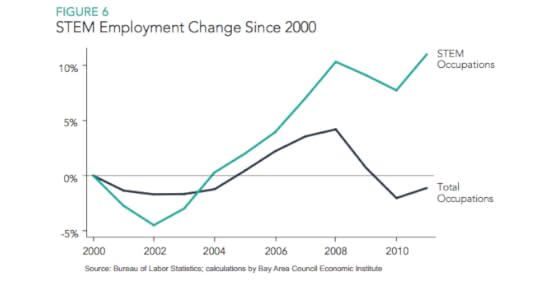 STEM occupations refer to Science, Technology, Engineering and Mathematics. The need for skilled workers in these jobs in the U.S is growing at a more rapid pace than our population growth. To put it in perspective, Information Technology (basically anything to do with computer technology) employed 110,800 managers in 2010. That number has now tripled.
STEM occupations refer to Science, Technology, Engineering and Mathematics. The need for skilled workers in these jobs in the U.S is growing at a more rapid pace than our population growth. To put it in perspective, Information Technology (basically anything to do with computer technology) employed 110,800 managers in 2010. That number has now tripled.
The new restrictions of the H-1B visa category restrict the visa for highly skilled workers such as software engineers and programmers. Last year, we issued 188,000 of these visas in the U.S., and the U.S. tech companies say those workers are crucial to their competitiveness with companies from other countries throughout the world.
Visa exemptions will be made for H-2B food service industry workers, such as cannery workers and agricultural labor. I’m not saying we shouldn’t do this—but think about the implications. We are exporting high tech jobs in exchange for basic labor jobs. One classic exemption in the visa policy is exemptions for an “au pair” (typically a young immigrant woman who provides childcare) if your au pair works in the best interest of national security. In other words, you can have an immigrant childcare worker if you’re a politician, but not if you’re an average American. It it’s right or wrong, shouldn’t it apply to everyone?
Steve Jobs, founder of Apple, spoke of the need for people in the technology industry before his death, reporting he needed to take Apple out of the U.S. because they simply couldn’t fill positions. Visas provide a way of keeping jobs in the U.S., and recruit people who can contribute significantly to our economy, tax base, etc.
We have unemployment in the U.S. The problem is that the vast majority of these people can’t step into technology jobs, and either aren’t able, or aren’t willing, to be trained to do so. Don’t get me wrong—we have great tech people in the U.S. We simply aren’t keeping up with the increased demand, and we are at risk of losing more American jobs if we don’t fill them with educated immigrants. A permanent solution would involve revamping our educational systems to better address the need for technological expertise in the future. It’s not like it’s difficult to get a child to sit at a computer. We need to be more assertive in educating our youth, rather than simply using technology for entertainment. With that said, can America handle crisis? Yes. We’re in crisis—right now—and we’re handling it. We are in the middle of the worst pandemic America has seen in a century, and everyone is a little more on edge. We have hate crimes and racial riots that have destroyed families and communities. But we’re getting back on our feet, and we find something to enjoy every day. Every person at my past week’s events respected the space and dignity of others. I swim with my grandchildren (in an above ground pool) every day, and we find the moon before bedtime.
With that said, can America handle crisis? Yes. We’re in crisis—right now—and we’re handling it. We are in the middle of the worst pandemic America has seen in a century, and everyone is a little more on edge. We have hate crimes and racial riots that have destroyed families and communities. But we’re getting back on our feet, and we find something to enjoy every day. Every person at my past week’s events respected the space and dignity of others. I swim with my grandchildren (in an above ground pool) every day, and we find the moon before bedtime.  My work goes on. My writing goes on. I’m anxious to see the bridge cover shots of Kloe Kapsner when Trisha Spencer has them done. I’ll share them online for feedback on the cover. I’ve spoken to Elise Yates, and ordered red smoke bombs for the back cover shoot. If anyone has had great success with using smoke bombs in photos, feel free to share your tips. I remain thankful for your kind support.
My work goes on. My writing goes on. I’m anxious to see the bridge cover shots of Kloe Kapsner when Trisha Spencer has them done. I’ll share them online for feedback on the cover. I’ve spoken to Elise Yates, and ordered red smoke bombs for the back cover shoot. If anyone has had great success with using smoke bombs in photos, feel free to share your tips. I remain thankful for your kind support.
Thanks for listening,
Frank
Thank you Theresa Woodward, Owner of CatTales Books & Gifts in Brainerd, for allowing me to sign books on the sidewalk in front of her store Tuesday. People respected social distancing and we sold a ton of books.
 I had the opportunity to speak on my books at The Center in Brainerd on Friday, although attendance was limited to 30 so social distancing could be observed. Numerous people needed to be turned away, but hopefully I’ll catch them at a future event
I had the opportunity to speak on my books at The Center in Brainerd on Friday, although attendance was limited to 30 so social distancing could be observed. Numerous people needed to be turned away, but hopefully I’ll catch them at a future event  On, Saturday, June 27, 2020,
Last Call
WON Best Romance of 2020 from Midwest Independent Publishers Association!!!!! It might not seem like that big of a deal, until you realize this covers cities like Detroit and Chicago, and all of the following states: Illinois, Indiana, Iowa, Kansas, Michigan, Minnesota, Missouri, Nebraska, North Dakota, Ohio, South Dakota, and Wisconsin. Thank you! Thank you! Thank you! for everyone’s kind support for my books.
On, Saturday, June 27, 2020,
Last Call
WON Best Romance of 2020 from Midwest Independent Publishers Association!!!!! It might not seem like that big of a deal, until you realize this covers cities like Detroit and Chicago, and all of the following states: Illinois, Indiana, Iowa, Kansas, Michigan, Minnesota, Missouri, Nebraska, North Dakota, Ohio, South Dakota, and Wisconsin. Thank you! Thank you! Thank you! for everyone’s kind support for my books.  I apologize for the following rant, but I’m a numbers guy. It’s important for people to understand our current need for skilled people in the technology arena at the present time. We can’t let politics stand in the way of progress. As people who’ve read my blog know, I’m not a democrat or a republican. I’m one of many people who want to improve the lives of all Americans.
I apologize for the following rant, but I’m a numbers guy. It’s important for people to understand our current need for skilled people in the technology arena at the present time. We can’t let politics stand in the way of progress. As people who’ve read my blog know, I’m not a democrat or a republican. I’m one of many people who want to improve the lives of all Americans.Visa restrictions are understandable, but it can’t be a blanket policy.
The United States is limiting visas in order to maintain jobs for our citizens in the midst of the covid-19 pandemic. This seems logical on the surface. But we need to be careful of the impact blanket policies have on our future. At the present time, there is a need for college graduates in the technology industry. Today, there are over 120,000 job openings in the tech sector in the U.S., which is as many as when the whole pandemic started. We simply don’t have the people to fill these positions. Students come from all over the world to attend college in the U.S., and stay here to work in our tech companies. By eliminating visa programs, they will return to their home countries, mostly China, and start their own companies. China and India produce hundreds of thousands of tech graduates every year. Apple, Google, Microsoft, Amazon and Tesla have all complained about blanket visa restrictions and have reported they may have to move more of their technology business out of the U.S. to fill the demands for their work. For example, Canada allows these visas. A financial analyst pointed out this week that the restrictions on visas hurt the U.S. and benefit all of competitors:
“This may be a Canadian jobs creation act. You can go to Toronto and hire people to work there quite effectively.” Chuck Robbins, The Financial Times on July 23, 2020.
 STEM occupations refer to Science, Technology, Engineering and Mathematics. The need for skilled workers in these jobs in the U.S is growing at a more rapid pace than our population growth. To put it in perspective, Information Technology (basically anything to do with computer technology) employed 110,800 managers in 2010. That number has now tripled.
STEM occupations refer to Science, Technology, Engineering and Mathematics. The need for skilled workers in these jobs in the U.S is growing at a more rapid pace than our population growth. To put it in perspective, Information Technology (basically anything to do with computer technology) employed 110,800 managers in 2010. That number has now tripled.The new restrictions of the H-1B visa category restrict the visa for highly skilled workers such as software engineers and programmers. Last year, we issued 188,000 of these visas in the U.S., and the U.S. tech companies say those workers are crucial to their competitiveness with companies from other countries throughout the world.
Visa exemptions will be made for H-2B food service industry workers, such as cannery workers and agricultural labor. I’m not saying we shouldn’t do this—but think about the implications. We are exporting high tech jobs in exchange for basic labor jobs. One classic exemption in the visa policy is exemptions for an “au pair” (typically a young immigrant woman who provides childcare) if your au pair works in the best interest of national security. In other words, you can have an immigrant childcare worker if you’re a politician, but not if you’re an average American. It it’s right or wrong, shouldn’t it apply to everyone?
Steve Jobs, founder of Apple, spoke of the need for people in the technology industry before his death, reporting he needed to take Apple out of the U.S. because they simply couldn’t fill positions. Visas provide a way of keeping jobs in the U.S., and recruit people who can contribute significantly to our economy, tax base, etc.
We have unemployment in the U.S. The problem is that the vast majority of these people can’t step into technology jobs, and either aren’t able, or aren’t willing, to be trained to do so. Don’t get me wrong—we have great tech people in the U.S. We simply aren’t keeping up with the increased demand, and we are at risk of losing more American jobs if we don’t fill them with educated immigrants. A permanent solution would involve revamping our educational systems to better address the need for technological expertise in the future. It’s not like it’s difficult to get a child to sit at a computer. We need to be more assertive in educating our youth, rather than simply using technology for entertainment.
 With that said, can America handle crisis? Yes. We’re in crisis—right now—and we’re handling it. We are in the middle of the worst pandemic America has seen in a century, and everyone is a little more on edge. We have hate crimes and racial riots that have destroyed families and communities. But we’re getting back on our feet, and we find something to enjoy every day. Every person at my past week’s events respected the space and dignity of others. I swim with my grandchildren (in an above ground pool) every day, and we find the moon before bedtime.
With that said, can America handle crisis? Yes. We’re in crisis—right now—and we’re handling it. We are in the middle of the worst pandemic America has seen in a century, and everyone is a little more on edge. We have hate crimes and racial riots that have destroyed families and communities. But we’re getting back on our feet, and we find something to enjoy every day. Every person at my past week’s events respected the space and dignity of others. I swim with my grandchildren (in an above ground pool) every day, and we find the moon before bedtime.  My work goes on. My writing goes on. I’m anxious to see the bridge cover shots of Kloe Kapsner when Trisha Spencer has them done. I’ll share them online for feedback on the cover. I’ve spoken to Elise Yates, and ordered red smoke bombs for the back cover shoot. If anyone has had great success with using smoke bombs in photos, feel free to share your tips. I remain thankful for your kind support.
My work goes on. My writing goes on. I’m anxious to see the bridge cover shots of Kloe Kapsner when Trisha Spencer has them done. I’ll share them online for feedback on the cover. I’ve spoken to Elise Yates, and ordered red smoke bombs for the back cover shoot. If anyone has had great success with using smoke bombs in photos, feel free to share your tips. I remain thankful for your kind support. Thanks for listening,
Frank
Published on June 28, 2020 17:08
June 15, 2020
Christopher Columbus
 What exactly are we celebrating on Columbus Day?
What exactly are we celebrating on Columbus Day? Columbus didn’t discover America, any more than I discovered St. Cloud. Both had people living there when we arrived. Columbus was never in the area that is now the United States. If we are celebrating the arrival of the first Europeans in America, it wasn’t Columbus. There was a settlement in the North American island of Greenland by the Norse as early as 980 (more than 500 years before Columbus arrived in America). Leif Erikson set foot in Newfoundland, Canada, in 1001.
So let’s take a look at the life of Columbus.
Christopher Columbus was born in Genoa, Italy in 1451. In his personal life, Columbus married a Portuguese noblewoman Filipa Moniz Perestrelo in Lisbon, She was the daughter of a Portuguese Knight of Santiago and a member of the Order of Prince John. She died around 1484. How does Columbus, the son of weaver, land her without a dowry? She was 25 years old. Columbus later took a Castilian mistress, Beatriz Enriquez de Arana, but never married her due to her lower social status. She raised both of his children, when he left town for the new world. He had one son with each woman. Though largely self-educated, Columbus was widely read in geography, astronomy, and history.
Columbus formulated a plan to seek a western sea passage to the East Indies, hoping to profit from the lucrative spice trade. Italy and Portugal felt Columbus underestimated the distance around the world to Asia so they wouldn’t fund his venture. (They didn’t know the American continent would also be in the way.) It was known the world was round at this time, despite myths that suggest otherwise. Following persistent lobbying, Queen Isabella I and King Ferdinand II of Spain agreed to sponsor his journey. Columbus left Castile, Spain, in August 1492 with three ships.
After a stopover in the Canary Islands, Columbus made landfall in the Americas on October 12, 1492 (later celebrated as Columbus Day). His landing place was an island in the Bahamas. Columbus subsequently visited the islands now known as Cuba and Hispaniola, establishing a colony in what is now Haiti—the first European settlement in the Americas since the Norse colonies nearly 500 years earlier. He returned to Castile, Spain, in early 1493, bringing a number of captive natives (Indian prisoners) with him. Columbus would eventually complete four voyages across the Atlantic Ocean providing the first European contact with the Caribbean, Central America, and South America.
 In his next 3 voyages to the New World, he explored the Lesser Antilles (the small islands south of Peurto Rico in the Caribbean) in 1493, Trinidad and the northern coast of South America in 1498, and the eastern coast of Central America in 1502. Columbus continued to seek a passage to the East Indies. It’s not clear that he ever honestly knew he had landed on a landmass separate from Asia, as he never clearly renounced his belief that he had reached the Far East. The country of Colombia is named after him.
In his next 3 voyages to the New World, he explored the Lesser Antilles (the small islands south of Peurto Rico in the Caribbean) in 1493, Trinidad and the northern coast of South America in 1498, and the eastern coast of Central America in 1502. Columbus continued to seek a passage to the East Indies. It’s not clear that he ever honestly knew he had landed on a landmass separate from Asia, as he never clearly renounced his belief that he had reached the Far East. The country of Colombia is named after him.Was Columbus an idiot? In some ways he was both intelligent and lucky.
Columbus had a valuable understanding of trade winds which made him the master of the Atlantic. During his first voyage in 1492, he took advantage of the brisk trade winds from the east, called "easterlies." His first land sighting (and landing point) was the island of San Salvador in El Salvador. To return to Spain, against this prevailing wind, would have required a procedure referred to as “beating.” Beating involves moving the ship zig-zag into the upwind. (No sailing vessel can move directly upwind.) Beating allows the vessel to advance indirectly upward. Using this method would have exhausted his food and drinking water. By sailing back directly west initially, he skirted the “horse latitudes” of the Mid-Atlantic. The “horse latitudes” are dangerous for sail ships since it is incredibly calm (little wind).
 Columbus risked running into a tropical storm, which by chance, he avoided. Columbus then took advantage of the curving trade winds northeast to the middle latitudes of the Atlantic where he was able to catch the “westerlies” which blow to the coast of Western Europe.
Columbus risked running into a tropical storm, which by chance, he avoided. Columbus then took advantage of the curving trade winds northeast to the middle latitudes of the Atlantic where he was able to catch the “westerlies” which blow to the coast of Western Europe.  Taino women Was Columbus a good person? No. His quest for gold and brutal treatment of the Taino people, who were incredibly kind to him, reflect this. Historically, Columbus was never researched accurately. In all fairness, some of this information only became available in 2006, when a 48 page report was found in the archives in the city of Simancas, Spain.
Taino women Was Columbus a good person? No. His quest for gold and brutal treatment of the Taino people, who were incredibly kind to him, reflect this. Historically, Columbus was never researched accurately. In all fairness, some of this information only became available in 2006, when a 48 page report was found in the archives in the city of Simancas, Spain.1. During Columbus’ maiden voyage he took somewhere between 10-25 Natives as prisoners. Only 7 or 8 arrived in Spain alive.
2. Columbus wrote in a letter to a friend about one of the indigenous women he captured:
"While I was in the boat, I captured a very beautiful Carib woman, whom the said Lord Admiral gave to me. When I had taken her to my cabin she was naked—as was their custom. I was filled with a desire to take my pleasure with her and attempted to satisfy my desire. She was unwilling, and so treated me with her nails that I wished I had never begun. But—to cut a long story short—I then took a piece of rope and whipped her soundly, and she let forth such incredible screams that you would not have believed your ears. Eventually we came to such terms, I assure you, that you would have thought that she had been brought up in a school for whores."
 Taino man By 1499, accusations of tyranny and incompetence by Columbus had reached Queen Isabella and King Ferdinand. They responded by removing him from power as Governor of Hispaniola. They were told that Columbus regularly used torture and mutilation as punishment. The 48-page report, found in 2006 in the national archive in the Spanish city of Simancas, contains testimonies from 23 people, including both enemies and supporters of Columbus, about the treatment of colonial subjects by Columbus and his brothers during his seven-year rule.
Taino man By 1499, accusations of tyranny and incompetence by Columbus had reached Queen Isabella and King Ferdinand. They responded by removing him from power as Governor of Hispaniola. They were told that Columbus regularly used torture and mutilation as punishment. The 48-page report, found in 2006 in the national archive in the Spanish city of Simancas, contains testimonies from 23 people, including both enemies and supporters of Columbus, about the treatment of colonial subjects by Columbus and his brothers during his seven-year rule.
3. According to the report, Columbus once punished a man found guilty of stealing corn by having his ears and nose cut off and then selling him into slavery.
4. Columbus congratulated his brother Bartolomeo on "defending the family" when Bartolomeo ordered a woman paraded naked through the streets and then had her tongue cut out for suggesting that Columbus was of lowly birth.
5. Columbus put down native unrest and revolt by first ordering a brutal crackdown in which many natives were killed, and then parading their dismembered bodies through the streets in order to discourage further rebellion.
Consuelo Varela, a Spanish historian who has seen the document, told journalists: "Even those who loved him had to admit the atrocities that had taken place."
Columbus and his brothers were arrested and imprisoned upon their return to Spain. They lingered in jail for six weeks before King Ferdinand ordered their release. Not long after, the king and queen summoned Columbus and his brothers to the Alhambra palace in Granada. There, the royal couple heard the brothers' pleas; restored their freedom and wealth; and, after much persuasion, agreed to fund Columbus's fourth voyage. But Columbus would never again be allowed to serve as governor.
 6. The Taino people from Hispaniola suffered severely as a result of the Spanish presence. Their numbers were once estimated to be 3 million. 85% were dead by the early 1500’s. (Remember Columbus arrived in 1492.) The Spaniards removed men from villages to work in gold mines and colonial plantations. This kept the Taíno from planting the crops that had fed them for centuries. They began to starve; many thousands fell prey to smallpox, measles and other European diseases for which they had no immunity; some committed suicide to avoid subjugation; and hundreds fell in fighting with the Spaniards. By 1514, (in just 2 decades) half of Spanish men had taken Taino wives. They mixed with African slaves, (who would eventually win independence in Haiti), forming a new, tri-racial Creole culture. To quote a historian, “Very few Indians were left, 50 years after Columbus arrived.”
6. The Taino people from Hispaniola suffered severely as a result of the Spanish presence. Their numbers were once estimated to be 3 million. 85% were dead by the early 1500’s. (Remember Columbus arrived in 1492.) The Spaniards removed men from villages to work in gold mines and colonial plantations. This kept the Taíno from planting the crops that had fed them for centuries. They began to starve; many thousands fell prey to smallpox, measles and other European diseases for which they had no immunity; some committed suicide to avoid subjugation; and hundreds fell in fighting with the Spaniards. By 1514, (in just 2 decades) half of Spanish men had taken Taino wives. They mixed with African slaves, (who would eventually win independence in Haiti), forming a new, tri-racial Creole culture. To quote a historian, “Very few Indians were left, 50 years after Columbus arrived.”  Taino woman The demise of Columbus
Taino woman The demise of ColumbusDuring a violent storm on his first return voyage, Columbus, then 41, suffered an attack of influenza and other fevers, bleeding from the eyes, temporary blindness and prolonged attacks of gout. The attacks increased in duration and severity, sometimes leaving Columbus bedridden for months at a time, and culminated in his death 14 years later. There are some suggestions he experienced intestinal infections as a result of sexually transmitted disease, but it’s more likely the infection was due to poor sanitation and improper food preparation on his ocean voyage. Columbus died in Valladolid, Spain on May 20, 1506. (Valladolid was the capital of Spain in the 1600’s.)
New York Governor, Andrew Cuomo, recently said Columbus was an important figure for Italian Americans, symbolizing their contribution to New York, and for that reason he opposes removal of the statues. I don’t know any Italian Americans whose pride rests on the contributions of Columbus. When you think about it, Columbus is the only person (other than Jesus) who never lived in the U.S. who has a holiday. And there isn’t much of a comparison between the two.
I believe critical thinking is a process of reasonable inquiry in which solutions to ill-structured problems are constructed; adequacy of solutions is evaluated in terms of what is reasonable or probable based on current evidence and is reevaluated when relevant new evidence, perspectives, or tools of inquiry become available. New evidence is available. We need to adjust our beliefs accordingly.
Thanks for listening,
Frank


 Babbling Brook in 2020. (Located East of Pierz) Back in the late 1970’s and early 1980’s, a lot of stories started with, “We were at Babbling Brook…”
Babbling Brook in 2020. (Located East of Pierz) Back in the late 1970’s and early 1980’s, a lot of stories started with, “We were at Babbling Brook…”  A teaser, but not final cover picture, from the photo shoot for the cover of Book 5 (tentatively titled Burning Bridges).
A teaser, but not final cover picture, from the photo shoot for the cover of Book 5 (tentatively titled Burning Bridges). 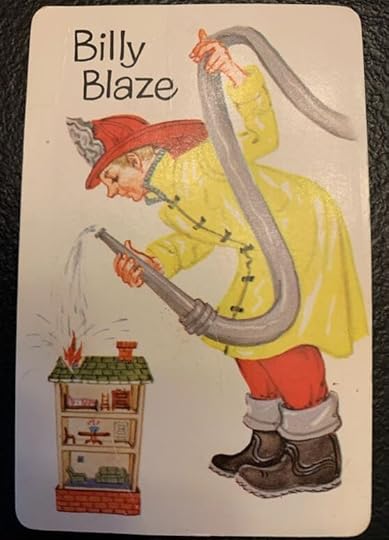 Evidently, Billy Blaze was a card in the Old Maid game. Thank you Jennifer! I may use this as an insert. It would be fun to have an artist redraw some of the events in the house to reflect his history.
Evidently, Billy Blaze was a card in the Old Maid game. Thank you Jennifer! I may use this as an insert. It would be fun to have an artist redraw some of the events in the house to reflect his history.
Published on June 15, 2020 10:33
May 30, 2020
The George Floyd murder in Minneapolis was a tragedy
George Floyd tragedy exacerbates…
The George Floyd murder in Minneapolis was a tragedy. I tell people that you can’t defend what 5% of the people in any occupation do. There are terrible police officers and there are great police officers. I met with the retired police chief of Minneapolis a couple months ago, and he shared his frustration with not being able to get rid of bad cops. He told me that he had fired 11 officers, and was forced to take them back by the union. This is part of the problem.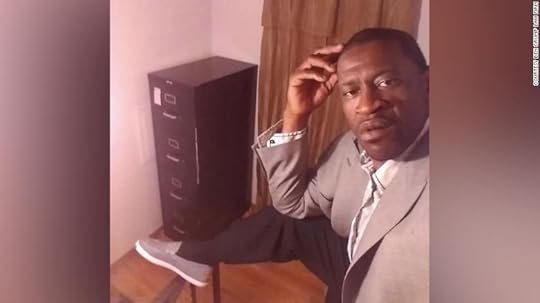 The incident:
The incident:
George Floyd enters Cup Foods in Minneapolis to buy cigarettes. He uses a counterfeit bill. Often people who use counterfeit money don’t know it’s counterfeit (as it was passed on to them). The store clerk calls the police. Floyd leaves the store without incident and is on the street in front of the store. The officers state at some point he resisted arrest so he was cuffed and laid down on the street. An officer kneels on Floyd’s neck for 8 minutes. Floyd initially states, “I can’t breathe.” Then dies. He is unresponsive when the ambulance arrives. The Minneapolis police department fires all 4 officers involved in the incident. The owner of Cup Foods volunteers to pay for Floyd’s funeral. The Minneapolis mayor wants the officer directly involved in the incident incarcerated.
Stores are vandalized and burned for 3 days in Minneapolis and on the third day the looting starts in St. Paul. The Minneapolis Tribune publishes an article in defense of looters, indicating the civil rights movement wasn’t successful.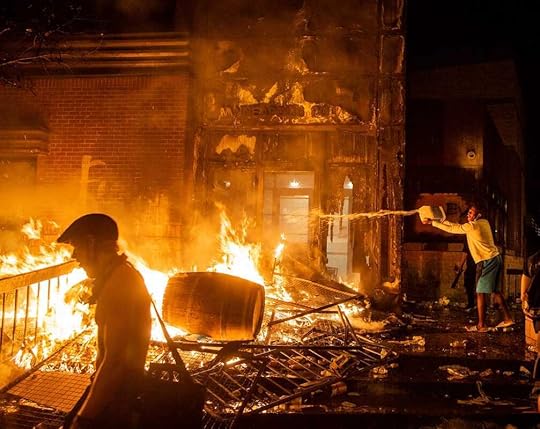 The idea that this behavior is heroic or necessary is as idiotic as racism. My thoughts:
The idea that this behavior is heroic or necessary is as idiotic as racism. My thoughts:
I remembered reading an argument between Winston Churchill and Mahatma Ghandi where Churchill stated we need to act for the greater good. Ghandi responded by stating that any act that denies one person rights, is not in the best interest of humanity.
I don’t defend looters. I understand the anger, but denying one person the opportunity to operate a business, because you’re angry over a separate injustice, is denying individuals and families their right to peacefully survive. Further, the civil rights movement was successful, it just wasn’t complete.
As anyone who has made successful life changes knows, you can’t go from A to Z. You go from A to B, and when you’re at B you can go to C. Everything wasn’t resolved after the civil rights movement, but much was accomplished. 100’s of people were lynched in the U.S. annually before 1950. Schools were integrated in the 1960’s. We still have much to accomplish, but don’t lose sight of the success. I appreciate that we are seeing material being suggested to open up people’s eyes to racism. But don’t tell me I need to be more enlightened when you’re burning people’s businesses and robbing stores. The argument that violence and destruction is what needs to happen to get people to listen, is the same argument I hear from assaultive men in domestic abuse cases. It’s not okay. Any behavior that violates the rights of one person, is not in the best interest of humanity. The assumption that the majority of white people think the same as one abusive man is as distorted as the thoughts of the white cop who committed the murder.
Other Gandhi quotes:
"I object to violence because when it appears to do good, the good is only temporary. The evil it does is permanent."
“Anger is the enemy of nonviolence, and pride is the monster that swallows it up.”
“One man cannot do right in one department of life whilst he is occupied in doing wrong in any other department. Life is one indivisible whole”
Don’t get caught up in the hate… We make the world better, one interaction at a time. It’s all I could ask of any of you today. Take care!
Pictured below: St. Cloud pulls off peaceful protest! Thank you! (Thank you KSNI for the photo!)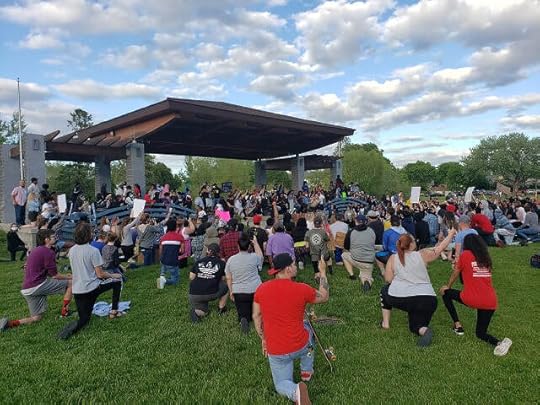 A separate story (and we need to have separate stories):
A separate story (and we need to have separate stories):
I hadn’t had a haircut since March, as a result of businesses shutting down.
Last weekend in my home, I asked, “Who wants to cut my hair?”
My 6-year-old granddaughter volunteered, “I would.”
To her surprise, I told her, “Okay. Let’s get a scissors and you can be my hair stylist.”
After I let her cut away, she suddenly stopped.
I asked, “How’s it going?”
She humbly responded, “Not good Grandpa.”
I laughed and buzzed it. Time to start over.


 Thanks for listening,
Thanks for listening,
Frank
The George Floyd murder in Minneapolis was a tragedy. I tell people that you can’t defend what 5% of the people in any occupation do. There are terrible police officers and there are great police officers. I met with the retired police chief of Minneapolis a couple months ago, and he shared his frustration with not being able to get rid of bad cops. He told me that he had fired 11 officers, and was forced to take them back by the union. This is part of the problem.
 The incident:
The incident:George Floyd enters Cup Foods in Minneapolis to buy cigarettes. He uses a counterfeit bill. Often people who use counterfeit money don’t know it’s counterfeit (as it was passed on to them). The store clerk calls the police. Floyd leaves the store without incident and is on the street in front of the store. The officers state at some point he resisted arrest so he was cuffed and laid down on the street. An officer kneels on Floyd’s neck for 8 minutes. Floyd initially states, “I can’t breathe.” Then dies. He is unresponsive when the ambulance arrives. The Minneapolis police department fires all 4 officers involved in the incident. The owner of Cup Foods volunteers to pay for Floyd’s funeral. The Minneapolis mayor wants the officer directly involved in the incident incarcerated.
Stores are vandalized and burned for 3 days in Minneapolis and on the third day the looting starts in St. Paul. The Minneapolis Tribune publishes an article in defense of looters, indicating the civil rights movement wasn’t successful.
 The idea that this behavior is heroic or necessary is as idiotic as racism. My thoughts:
The idea that this behavior is heroic or necessary is as idiotic as racism. My thoughts:I remembered reading an argument between Winston Churchill and Mahatma Ghandi where Churchill stated we need to act for the greater good. Ghandi responded by stating that any act that denies one person rights, is not in the best interest of humanity.
I don’t defend looters. I understand the anger, but denying one person the opportunity to operate a business, because you’re angry over a separate injustice, is denying individuals and families their right to peacefully survive. Further, the civil rights movement was successful, it just wasn’t complete.
As anyone who has made successful life changes knows, you can’t go from A to Z. You go from A to B, and when you’re at B you can go to C. Everything wasn’t resolved after the civil rights movement, but much was accomplished. 100’s of people were lynched in the U.S. annually before 1950. Schools were integrated in the 1960’s. We still have much to accomplish, but don’t lose sight of the success. I appreciate that we are seeing material being suggested to open up people’s eyes to racism. But don’t tell me I need to be more enlightened when you’re burning people’s businesses and robbing stores. The argument that violence and destruction is what needs to happen to get people to listen, is the same argument I hear from assaultive men in domestic abuse cases. It’s not okay. Any behavior that violates the rights of one person, is not in the best interest of humanity. The assumption that the majority of white people think the same as one abusive man is as distorted as the thoughts of the white cop who committed the murder.
Other Gandhi quotes:
"I object to violence because when it appears to do good, the good is only temporary. The evil it does is permanent."
“Anger is the enemy of nonviolence, and pride is the monster that swallows it up.”
“One man cannot do right in one department of life whilst he is occupied in doing wrong in any other department. Life is one indivisible whole”
Don’t get caught up in the hate… We make the world better, one interaction at a time. It’s all I could ask of any of you today. Take care!
Pictured below: St. Cloud pulls off peaceful protest! Thank you! (Thank you KSNI for the photo!)
 A separate story (and we need to have separate stories):
A separate story (and we need to have separate stories): I hadn’t had a haircut since March, as a result of businesses shutting down.
Last weekend in my home, I asked, “Who wants to cut my hair?”
My 6-year-old granddaughter volunteered, “I would.”
To her surprise, I told her, “Okay. Let’s get a scissors and you can be my hair stylist.”
After I let her cut away, she suddenly stopped.
I asked, “How’s it going?”
She humbly responded, “Not good Grandpa.”
I laughed and buzzed it. Time to start over.



 Thanks for listening,
Thanks for listening,Frank
Published on May 30, 2020 05:31
May 25, 2020
Names
Thursday, May 28, 2020, I will be speaking through Zoom (over the internet) for the Senior Center in Sartell from 9:00 a.m. to 10:30 a.m. on the writing of True Crime mystery and my forensic work. This presentation is focused on Last Call, which begins in Brainerd and ends in St. Cloud. Last Call identifies actual business and places in the Minnesota. The online presentation was arranged by Ann Doyscher-Domres, Program Coordinator, Sartell-St. Stephen Community Education. 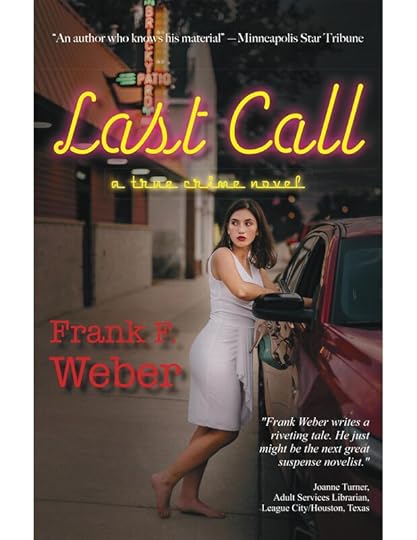 I want to thank Midwest Independent Publishers Association (MIPA) for their recognition of my books. MIPA is a vibrant professional nonprofit association that serves the upper-Midwest through education, networking, and peer recognition. MIPA is a regional affiliate of the Independent Book Publishers Association. Last Call is a finalist for Best Romance of 2020. The I-94 Murders won in 2019. My 1st book, Murder Book, was a finalist in 3 categories: Best Mystery, Best Young Adult Novel and Best Romance. With regard to my newest book, I would like to thank retired Police Officer/Investigator, Michael Lewandowski for his guidance. Mike now operates Priority Investigations and Protective Services.
I want to thank Midwest Independent Publishers Association (MIPA) for their recognition of my books. MIPA is a vibrant professional nonprofit association that serves the upper-Midwest through education, networking, and peer recognition. MIPA is a regional affiliate of the Independent Book Publishers Association. Last Call is a finalist for Best Romance of 2020. The I-94 Murders won in 2019. My 1st book, Murder Book, was a finalist in 3 categories: Best Mystery, Best Young Adult Novel and Best Romance. With regard to my newest book, I would like to thank retired Police Officer/Investigator, Michael Lewandowski for his guidance. Mike now operates Priority Investigations and Protective Services. 
Website:
www.priorityinvestigationmn.org What’s in a name? I’m inviting readers to share more of your thoughts on book 5.
I have had a variety of responses for names for Book 5. Here are the examples:
UnforgiVen (with the capital V representing this is the 5th book in the Jon Frederick series)
Beget and Regret
Burn the Boats
Burned Bridges
Bridges Burned
Circle of Hurt
Con Genitals
Dead Beat Daddy
Dead Dad
Dead Ends
Dead to Me
Falling Down
Father Knows Arrest
Illegitimate Pursuit
Mad Mouse
Maker’s Mark
Not all Bridges Burn
On the Rocks
Origins Unknown
Pop’s Sickle
Road Closure
Sorry Sire
Unknown Bridges
Uncovering True Colors
The Unknowns
The Father I Never Met
Treacherous Tracks
Treacherous Trails
And a couple that made me laugh…
Spawn of the Dead
Tequila Mockingbird (From an individual who remembered from True Crime Tuesdays that offender loved Tequila)
I’m leaning toward Bridges Burned for the time being, but I’m still not certain. You may recognize the pictures of this in bridge (in Little Falls). If people have suggestions for another bridge to use, please let me know. I am also thinking of having Kloe Kapsner, pictured below, as the cover model. She will be the portraying the character of Harper Rowe, a young woman searching for the father she never met.


 Bridges Burned
Bridges Burned
The story involves a young woman looking for her biological father. This is based on a true story and it’s an example how ancestry searches can lead to discovering information that doesn’t make you feel better.
This is the longest chapter in the book, and I’ve thought of cutting aspects of it, because it is intense and disturbing. However, it is the father’s actual criminal history. I received special permission from John Prine’s recording company to start each chapter with a John Prine quote. (You could also send me your favorite John Prine lines.) Please keep in mind, this is a raw version, and it will go through numerous rewrites. I am rewriting the story in the present day. Chapter 5
Your flag decal won't get you
Into Heaven any more
They're already overcrowded
From your dirty little wars
Now Jesus don't like killin'
No matter what the reasons for…
John Prine, Your flag decal won't get you
Into Heaven any more
Jon Frederick
MONDAY, APRIL 13, 2020
BIRCHMONDT DRIVE NORTHEAST, WEST SIDE OF LAKE BEMIDJI, BEMIDJI Yesterday again, was the highest increase in new coronavirus cases in Minnesota (+194). While it’s typically better to have information, I hated knowing Serena was being hammered with this news every time she turned on the TV.
I had the unenviable task of going over the information I received on Billy Blaze with his daughter Harper.
Harper nervously sat with a pen and a paper pad, long legs politely crossed, waiting for the verdict.
I began, “If I was in your shoes, I’d want factual information, rather than opinion, so I’ve prepared a timeline of Billy Blaze’s adult life. This is what I’ve unearthed so far on Billy Blaze from 1991 to the present.”
She picked up her mocha and took a sip. After setting it back down, she retrieved her notebook and pen. “I’m ready.”
I wanted to say, ‘No, you’re not,’ but instead offered, “You don’t have to take notes. I’ve printed you a copy of what I’m presenting. Just sit back and ask questions.”
Harper relaxed as best she could, in her cushioned wicker chair. “Thank you.”
I took a deep breath and started, “On March 11, 1991 Blaze was ticketed for Driving While Intoxicated. He joined the military and was stationed in Iraq after Desert Storm. Blaze ended up being shot in the hip by a sniper. This fueled open resentment toward Muslims, so the army elected to give him a medical discharge rather than allow him to return to duty. For the next six years, he apparently went to work and lived a relatively quiet civilian life.”
Harper smiled, “Okay, he served our country, and he drinks a little. And maybe he has some unresolved anger to work through.”
“On August 22, 1997, he pled guilty to domestic assault. The victim, Connie Berg, reported he struck her in the head multiple times. Blaze had scratches on his face.”
Harper naively asked, “Do you think it was it one of those he said-she said lovers quarrels, that just got out of hand?”
I softly revealed, “No. The incident was recorded. He violently raped her and brutally assaulted her. She scratched his face trying to fight him off. On August 29, 1997, he broke the front window at the bridal boutique Connie owned. Even though there was an eyewitness, Connie elected not to press charges.”
The next day, Blaze lept from a moving car on Highway 15, on a busy stretch where it crosses the Mississippi bridge in St. Cloud. He was given mouth to mouth resuscitation. Blaze seizured after he came to. He had been using heroin and cocaine intravenously.”
Her eyes had teared up. She suggested, “He must have been tormented with guilt.”
I continued, “On October 22, 1997, Blaze assaulted a Muslim man, after leaving the Red Carpet bar intoxicated. The man was driving by. Blaze asked, “How are you doing?” The man remarked, “Better than you,” in reference to Blaze’s intoxication. Blaze pulled the man out of his car through the open car window and beat him.”
Harper looked disappointed, but said, “He must be strong.”
“That he is. On January 1, 1998, Loni Lake returned home to find her front door had
been kicked open. Her collection of crystal glass was smashed on the floor. The only items taken were a key to her home, alcohol, and jar of change. Prior to coming home she had a verbal argument with Billy Blaze at the Corner Bar. The bartender had kicked Blaze out of the bar an hour before Loni left. Blaze denied breaking into her apartment and described Loni as ‘a drunken broad I picked up.’ Loni told the officer she is afraid of Blaze and preferred not to press charges.”
Harper didn’t respond so I went on, “On February 27, 1998, Blaze was charged with Disorderly Conduct. He was leaving a house party when he said to a couple entering,
“Now there’s a gross looking woman.” The woman responded, “You’re drunk.” Quoting the police complaint verbatim, Blaze threatened, “Do you know who you’re talking to?”
When her partner intervened. Blaze kicked him in the shin, and then ripped the woman’s
blouse open. Both reported they were very frightened of him.”
I glanced up, while Harper sat back in shock, “On April 1, 1998, police responded to a fight
that was reportedly instigated by Blaze at an apartment. When the police arrived, the fight was still
going but Blaze was gone. He didn’t receive any charges. Three weeks later Blaze received
his second DWI after it was reported he was swerving his Corvette through traffic on St. Germain
street in St. Cloud, yelling obscenities out his open window targeting minorities. The officers who
responded in the black and white, were black and white. Blaze tried to provoke the officers into
hitting him, but neither did.”
Harper said, “Please tell me your done with 1998.”
I continued, “On July 11, 1998 a couple complained to police Blaze was yelling from the window of his new Corvette at the woman working the drive-thru in Panera. When they stepped over to his car to ask him to stop, he hopped out, undid his pants, and exposed his genitals to them.” I decided not to use exact words, “He suggested they perform oral sex on him.”
Harper was so overwhelmed she now tried to make light of it, “Winnie the Pooh style--shirt no pants.”
On October 1, 1998, a man who met the description of Billy Blaze fired a shot into a trailer home with a handgun. The witness couldn’t confirm with certainty, so no charges were filed. On October 6, 1998 Ricky Walters reported Blaze had stolen his .308 caliber, pump action, Remington rifle. The next day, a bartender at the Old Brick House Pub, said Blaze walked in and pointed a .308 pump action Remington rifle at this head. The bartender wrestled it away from him. Blaze claimed he was bringing the rifle to the bar to give to a man he owed money. Blaze was charged with Aggravated Assault and theft, but surprisingly, all of the charges were dismissed.”
Harper scratched her head, “That doesn’t make any sense. Why would they dismiss, when his guilt was so obvious?”
“This is a situation I plan on revisiting. My guess is that Blaze gave up evidence on a major drug dealer. The DEA is given a lot of latitude with witnesses, when they’re going after a major player. When I worked for the BCA, I helped send a rapist to prison who had four previous criminal sexual conduct charges dismissed in exchange for his testimony on four previous drug cases.”
She huffed in frustration, “Didn’t it seem like they were making deals with the wrong guy?”
“It sure did. But he ran out of rope with me.”
Harper stuttered, “Did Blaze--dad, ever show any remorse?”
“Not really. Realizing she was struggling with calling Blaze dad, I stated, “Colton Rowe is your dad. Blaze is just a guy your mom was with for a short time.” Harper seemed to appreciate the opportunity to separate herself from him. “On January 29, 1999, Blaze was found passed out in a truck by the truck owner. Blaze broke in and drank most of the bottle of Windsor whiskey inside. Blaze became violent with police officers when they asked him to leave. He was charged with Disorderly Conduct and Trespassing. But all of the charges were dismissed by what the police report described as a ‘Big City Attorney,’ after Blaze agreed to enter CD treatment.” I noted, “I don’t see anything underhanded with this agreement. That kind of deal, for a minor offense is pretty typical.”
With naïve optimism, Harper thought out loud, “Alright. Finally, a chance to turn it around.”
I cleared my throat. “Okay, one month later, on February 26, 1999, Blaze and his friend Gunner Stone, stole a 30-30 Winchester, a Crossman 33 Air Rifle with scope, and a Chrome plated Colt .45 pistol, from ‘Fats’ Gangel and ‘Moe’ Brown. The pistol was unusual as it had a shiny chrome grip. Blaze and Stone’s vehicles were impounded and searched, but no weapons were found. After the vehicles were released investigators realized neither Blaze nor Stone had a current valid driver’s license. No charges were filed. However, within two weeks, on March 8, Blaze and Stone crashed a house party and Blaze, with a chrome plated Colt .45 in hand, made everyone hand over their money.”
“Did he get charges then?”
I shook my head, “No. There were lots of illegal drugs present and no one wanted their names in a criminal complaint. The incident was documented by an undercover DEA agent in the home and they weren’t ready to give up his cover. One week after that, on March 15, Blaze was charged with Aggravated DWI.”
Harper considered, “Do you think the DEA tipped off the police to make sure he was charged with something? Maybe even give them opportunity to search his car for the guns?”
I smiled, “It happens. On March 17, 1999, Blaze’s sister Deb Zion tells police Blaze has been calling her and threatening to kill her. No reason reported. No charges filed.”
“Zion? That’s an odd surname.”
“It’s one of the most common surnames in the world. It was her birth name. Half the people with this surname live in Africa.”
“Is his sister black?”
“I would guess so. Her race wasn’t in the file.”
Harper sat up, “I never even considered this, being I’m,” she waved a hand across her blonde hair and vanilla white skin, very white—is Billy Blaze black?”
“No. He’s white and so is the majority of his cohort.”
“How do you know their race if you don’t know his sister’s race?”
“They have criminal charges, so that information is available through the Department of Corrections.” I stopped and considered, “I believe it was sometime in March or April of 1999, when you were conceived correct?” Tony Shileto had run a background check on Harper for me. Her record was clean.
Harper quieried, “Did you come across mom’s name anywhere?”
“No, I didn’t. And that’s a good sign. It means she wasn’t involved in all the illegal stuff Blaze was involved in.”
Hopeful, she asked, “Do you think it’s possible Billy Blaze isn’t my father?”
“I believe Blaze is your father. She wanted you to stay away from him. If there was any possibility he wasn’t your father, he wouldn’t be on your birth certificate.” I took a breath and continued, “On May 3, 1999, Blaze showed up at Linda Michael’s home looking for her husband. Blaze threatened, ‘He better be home in an hour.’ Fearing for his life, Linda called the police. That night she received a call stating, ‘You called the cops. Now you’re a dead bitch.’ Even though she absolutely believes the calls were from Billy Blaze, they weren’t able to trace the number, so no charges were filed. On July 16, 1999, Jeff Anderson is found badly beaten in the parking lot of the La Playette bar in St. Joseph. Jeff reports he was assaulted by Billy Blaze, but he refuses to press charges. On August 5, 1999, Dominique Romano calls the police and states Blaze threatened him at the White Horse bar in St. Cloud. Once Dominique is safely escorted to his home, he refuses to press charges. He states it will only make things worse.”
“It’s all so crazy.”
“The next one’s a little lighter. On August 14, 1999, Kaplin’s Dentistry on Northway Drive in St. Cloud, reported Billy Blaze was in for a check up. When he left they realized two cans of cola were taken from the fridge, and a C.D. was stolen from the boombox. They decided it wasn’t worth filing charges.”
“Did they say what the c.d. was?”
“I’m a Barbie Girl, in a Barbie World—Aqua.”
Stunned, Harper asked, “You’re kidding right?”
“Yes-I’m kidding. They didn’t record the name of the c.d.” I took a deep breath and continued, “Okay, Deb Zion let her brother stay at her home for a couple days in August. On August 29, she called the police and reported she just realized checks were being forged from her account. That night, her son, Lenny received a call from Blaze telling Lenny to stay in the basement, as he’s going to shoot up the home in retaliation for Deb calling the police.”
“Nice brother. Very appreciative of her kindness.”
“On October 2, 1999, Blaze and Stone broke into the St. Cloud Animal Hospital and stole boxes of disposable syringes. Police responded to the silent alarm and Blaze was arrested leaving the building. He’s released pending a trial. Three days later Shari Kramer calls the police reporting Blaze entered her home and threatened her friend, ‘Chief’ with a rifle. Chief apparently owed him money. Blaze fired the rifle in the home, and then handed ‘Chief’ the shell stating, ‘the next one’s in you.’ Blaze then walked down the street to the Press bar, and fanned the gun across people sitting in the bar. A bouncer approached him, and he aimed the rifle at the bouncer’s head. The bouncer wrestled the rifle away. Blaze pled guilty to two counts of Terroristic threats, and was sentence to two years in the Minnesota Correctional Facility in Stillwater. Blaze was released from jail for Thanksgiving weekend to get his affairs in order, before going to prison. On Thanksgiving Eve, he rolled his Corvette numerous times after driving at high speeds down I-94 south of St. Cloud. He was found unconscious and didn’t recover consciousness until the next day. For the rest of 2000, until 2002, he was in prison. He lost his good time as a result of fights in prison.”
“Please tell me prison turned him around.” She added sarcastically, “It is a correctional facility, right?”
“Shortly after his release, on May 3, 2002, Blaze was ticketed for public urination. The reporting officer said, Blaze was standing shirtless in the Perkins parking lot at 1:30 a.m. with his jeans open and a woman named Cayenne Tiller was on her knees in front of him performing oral sex on him. Blaze argued he was just peeing and the woman had knelt down by him because she felt sick. The officer thought he’d give him a break, and just write him up for public urination. In return, Blaze wanted to fight the officer, but the officer just walked away.”
Harper was trying to find some sad humor in this. “So this time it’s the Smokey the Bear scenario—wearing jeans but no shirt.”
I smiled, “We seem to have a cartoon bear theme going.”
Harper grinned, “I’m sorry. It’s just so crazy.”
“Honestly, I wouldn’t know what to say myself.”
She added, “And cartoon bears have an apparel problem. Yogi bear and Fozzie bear both where a hat and a tie, and no other clothing. Bears seem to struggle with understanding the purpose of clothing.”
“I can’t argue with the evidence.”
Harper seemed to be recovering from being shell shocked with bad news. She asked, “Are there any positive events?”
“He had a flag decal on the windshield of his corvette. Keep in mind all of my information is from law enforcement files. With covid-19, I can’t simply go door to door. I’ve made some phone calls, but these people aren’t easy to find, and when I find them, they’re reluctant to talk. Blaze was apparently married to Mara Berrara in June or July of 2002.”
“Is it Maira or Marra?”
“It’s spelled M-A-R-A, but it’s just more fun to say Maira Barrera, so that’s what I’m going with until I hear otherwise. On August 2, 2002, the night manager at the Travel Host Motel in St. Cloud, called the police asking them to remove an unruly resident. Blaze had deep lacerations on his right wrist and forearm from smashing in the driver’s side window of Mara’s vehicle with his fist. The manager said Blaze was smearing blood on motel counter. Blaze told the clerk he left his wife’s car undriveable. Blaze was incarcerated for forty-five days on a probation violation.” I glanced up to make sure she was okay. “You have a half-brother. Blaze fathered a son with a Mexican woman when he was fifteen.”
Harper perked up. “Tell me about my bro.”
“On October 1, 2002, Concerns were expressed that Blaze was harboring his son, Phoenix Blaze. Phoenix had an outstanding warrant for car shopping.”
“Car shopping?”
“Breaking the windows of cars to steal items. Blaze claimed he hadn’t seen Phoenix. But on November 17, 2002, Phoenix was arrested after stealing a car only a block away from his dad’s home. Phoenix went on to become a major drug dealer for the Latin Kings. He’s currently serving an eight-year prison sentence in Oak Park Heights-- the only maximum security prison in Minnesota. It’s underground.”
Harper shook her head, “I won’t be visiting my bro. This is like a horror movie that you can’t shut off until you’ve seen the end.”
“Getting back to Billy Blaze, on November 6, 2002, Mara Berrara refuses to let her
husband, into her home because he’s intoxicated and he’s a mean drunk. Billy breaks all the porch
windows and threatens to “bury her” once he gets inside the house. After a physical altercation
with the police, Blaze spends the night in jail. Mara reports she is deathly afraid of Billy.”
“How long does this go on?”
“A while.”
Harper got up and retrieved a blanket from the corner of the three season porch. She
squirmed a little in her seat, until she was comfortable. “Keep going.”
“In 2003, the DEA takes a special interest in Blaze when Curtis Wicklin calls them from the Stearns county jail and reports Blaze is filling his wife Cheryl with drugs. On March 3, 2003
officers perform a welfare check and find Cheryl with slurred speech, bloodshot eyes and
needle marks all over her arms. She claims it’s because her doctor, who she refers to as “bobble
dick,” always has to try numerous times when he draws blood. Cheryl claims it’s all ‘a big set-up’
and her husband is just trying to make her look bad.”
“Bobble dick,” now that’s a nice nickname.”
“It turns out her doctor’s name is bobble dick, spelled, B-O-B-E-L-D-Y-K. They contact
Dr. Bobeldyk, who indicates he hasn’t drawn blood from Cheryl for over a year and he’s never
had difficulty drawing blood from her. On April 28, 2003, Blaze is arrested for trespassing when
he is intoxicated and refuses to leave the Ultimate Sports Bar and Grille in Waite Park. The drama
at home heats up when Curtis Wicklin is released early from jail. Curtis finds his wife in Blaze’s
bed, grabs her by the hair and drags her out of the home. She manages to dial ‘911.’ Cheryl claims
Curtis told her, “I’ll kill you bitch,” and her good friend, Billy Blaze witnessed the threat. Curtis
pled guilty to assault.”
“Unbelievable.”
“On July 30, 2003, Blaze reports his home was robbed. Even though he reports he was
face to face as he fought off the burglar, he can’t identify him. There was no forcible entry
noted. Police question if the home was actually robbed. Blaze filed a claim to his insurance.”
Later that day a report came in that Blaze had made threatening phone calls to Carol West.”
“Who is she?”
“No idea. On August 2, 2003, Mara Berrara files for divorce and she is granted an order
for Protection against Blaze. Mara reported that in the little over a year they’ve been married,
he’s punched her in the stomach, choked her, and dragged her around the house by her hair.
She reports being terrified, and knows he’s watching her when she’s in the community. There are
times she’s opened the curtains to find him standing right outside her window. She can’t sleep at
night and doesn’t even feel like eating.”
“I think I’m okay with never meeting my bio-dad, but I have to hear how this ends.”
On October 28, 2003, Chris Parker reported hearing glass breaking. Police arrive and
find Billy Blaze on the street with a baseball bat. Blaze said he was also awakened by glass
breaking and stepped out to check it out. All of the windows had been busted out of a home,
that was set to be demolished. Blaze said he saw teens jump in a car and take off. No charges
were filed. And then Blaze is off the grid for over a year. The rumor is, that he became involved
with a wealthy divorcee and is traveling the world.”
“I didn’t see that coming.”
I paused and asked, “Are you okay if I use the exact wording for the upcoming complaints. We have too much to cover to try to rephrase what he said in politically correct terms.“ I also felt that the exact wording, gave a clearer picture of this guy.
Harper said, “It would be my preference. I want to hear what you have, not what you think I should know.”
“By April of 2005 he’s back in St. Cloud. On April 14, 2005, Blaze is charged with violation of a DANCO order—Domestic Abuse No Contact Order. After they listen to Maya Berrara’s phone messages, he is also charged with Terroristic threats. Blaze is recorded saying, “You think you’re so fucking smart by not answering. I’m killing your motherfucking ass, bitch! And fuck you and everybody in this world. I’m killing you! You got that bitch? Fucking cunt. Answer that phone or I’m blowing up your house.” After a half hour passes, Blaze calls again and in his most pleasant voice, leaves a netw message, “Hi pretty. I’m horny and I want only you, babe. I want to taste you. You know what I’m talking about. How about answering the phone? Okay?”
Harper laughed at the ridiculousness of it. “Just ignore the last call. In the mood for
romance?”
“When police informed him that this time, they were able to trace the calls to his home,
Blaze stated, ‘Maybe it was my son.’ Now you get a break. Billy Blaze is sent to prison from 2005 to January of 2008. He executed his sentence, so he’s a free man when he’s released.”
Harper furrowed her eyebrows, “What does it mean to execute a sentence?”
“Offenders often do some time, and then are released early with the agreement they spend years on probation. People typically want to get out of prison as soon as possible, so they take the deal. But Blaze did the full sentence, with no early release, so he wouldn’t have to worry about probation. Once released, Blaze drops off the radar for a full year. The next we hear of Billy Blaze is on January 31, 2008, when he gets his fourth DWI in Ohio. He disappears again until September 28, 2008, when he pops up, once again, in St. Cloud. A man in a vehicle waves down a police officer saying he just picked up a man with broken arm who smashed up a Corvette. The ‘vette had struck a bridge, left the road and rolled. The police officer recognizes the injured man is Blaze. Billy refuses to go to the hospital, saying he doesn’t have insurance and can’t afford the bill. The officer points out that Blaze was too intoxicated to be driving. Blaze tells him, that the car was driven by a friend, and that since the accident he can’t remember the guys name or where he lives. Co-owners of Corvette were Billy Blaze and Margo Miller. Blaze was charged with driving without insurance. Then he’s gone again for over three years. The rumor is he’s running drugs in Florida. A year and a half later, on May 22, 2011, Blaze is arrested for a hit and run in St Cloud. He followed a woman’s car into the Hobby Lobby parking lot and bumped her car from behind in an apparent effort to get her to talk to him. She said when she stepped out, and he saw she was eight months pregnant, he swore at her and drove off. She was furious.”
Harper was lost in thought. “What do you think Blaze is doing that he’s keeps dropping below the radar?”
“Honestly, I don’t know. It’s hard to believe it’s something legal. On November 30, 2011, Randy Snyder calls the police and tells him Blaze is standing in his yard looking in his window. Snyder feared Blaze was going to kill him, as Blaze had threatened to kill him years earlier. Randy looks down and sees an envelope on the counter marked ‘Connie.’ The envelope states, ‘Billy Blaze is coming to kill you.’ Randy asks the officers if Blaze is going to kill Connie Bloom. Connie was at his home yesterday, and Blaze has told her he’d shut her big mouth in the past. The officers state they believe he was referring to Connie Berg.”
“How many Connie’s did he threaten to kill?”
“At least two. And then something changes. Up to this point, he’s consistently getting out of charges. Now the police seem to be paying closer attention to him. On July 20, 2012, Blaze apparently had a woman bent over the trunk of a car, with her skirt pulled up, in the Grand Central parking ramp in northeast St. Cloud and was taking her from behind. When a police officer told them to go home, Blaze threatened the officer. Blaze is charged with Disorderly Conduct. Two weeks later, Blaze received a ticket on August 3, 2012 for Obstructing the legal process after he interfered with the officer’s attempt to give a woman a ticket. She ended up being released without charges, so her name wasn’t in the file. On July 6, 2013, Blaze gets his fifth DWI. Woops—missed one. On February 24, 2013 Blaze is picked up for suspicious activity.”
“What is suspicious activity?”
“Typically, you see this in the record when they suspect someone is selling drugs, but somehow he ditched the product, so they didn’t up have enough to charge him. The following day, Blaze is picked for a threats complaint. My guess is Blaze had an idea on who ratted him out and found him. Two days after that, on February 26, Blaze is charged with Domestic Assault and Felon in possession of a weapon. He threatened a woman with a handgun. When the police spotted him walking down the street, he had a large bolt cutter up his sleeve. He didn’t have a weapon on his body, but they were able to photograph the imprint of handgun on his waist, where he is known to carry a gun. A .45 caliber handgun was found 3 feet away. When they searched him they also find blank checks belonging to Clara Lebowitz. Clara reports she’s never met Blaze and didn’t know how he got her checks.”
“It sounds like thing are really starting to amp up.”
“On May 23, 2013, Blaze was charged with Terroristic threats against Karsten Boon.
Blaze was taken in for a couple days by Craig and Irene Foley. Blaze decided to take a nap on
Craig’s recliner in their living room, bare chested and pants open—because he ate too much.
Karsten thought Blaze was being rude, so he set a cold beer on his chest. Blaze hopped to his feet
and put a loaded gun to Karsten’s head, threatening to kill him. When interviewed, Blaze denied
having the gun. He tells police, ‘Karsten’s on drugs. That punk mother fucker. Why are
you pullin this on me? I could give a fuck less about a fuckin drug addict mother fucker. I hate
drug dealers and I want to nail’em all.’”
“But isn’t Blaze also a dealer?”
“Probably, but he feels pretending he hates them is better cover. The most
interesting part of this story is Craig and Irene had taken Blaze in, when they found him in the alley behind the Press bar badly beaten. His eyes were black and blue and he had marks on his face
that were clearly made by punches from someone who was wearing a ring with skull on it. Blaze
claimed he fell. He had a pocket full of pain meds, but claimed they were all prescription. Craig
told police he took Blaze in because he wanted to help out a former vet. Irene wasn’t happy
about it. She stated if anyone did something Blaze didn’t like, he’d pat the gun on his waistband
to intimidate them. She described Blaze as ‘pure evil.’ During the police interview with
Irene, she reveals, that Blaze violently raped her friend, Cheryl Wicklin just a few months ago.
Irene hadn’t told her husband as Cheryl swore her to secrecy. Craig’s statement revealed Blaze
had told him he was a Desert Storm vet who was shot in the stomach, the head and in the leg.
Blaze told Craig his dad was mafia and was murdered.”
Harper interjected, “Is any of that true?”
“I have no idea. I need you to sign some releases so I can review some records.”
“It’s the first time I’ve heard him lose a fight.”
“He’s not the kind of guy who calls the police if he was beaten.”
“You said Cheryl Wicklin’s name earlier.”
“Her husband called the police and told them Blaze was shooting Cheryl up with drugs a
decade ago. Blaze was her witness when she reported her husband had assaulted her after his release from jail. Cheryl eventually got clean, but Blaze managed to find her and felt she owed him.”
Harper sighed, “If you do him a favor, he cashes it in heavy, doesn’t he?”
I nodded in agreement. “The charges he compiled in 2013 send Blaze back to prison from 2013 through most of 2015. I do think you’re on the right track when you mentioned he lost his first fight. Something changed. Now he doesn’t have any money. On December 12, 2015, he’s arrested for check forgery. On January 11, 2016, he’s arrested for check forgery again. On February 2, Margo Miller reports her Corvette was stolen. When Blaze is pulled over in it, she tells police it was just a misunderstanding. On February 5, 2016, it’s reported Blaze stole cash from a residence. On May 16, 2016, Blaze is picked up for busting the heads on garden gnomes with a golf club in the middle of the night, but the victim declines to press charges. On October 3, 2016, Michelle Evens reports suspicious activity in Blaze’s basement. Blaze threatens Michelle by calling and saying, “Goodbye sunshine, hello darkness.” Michelle’s advised to get an OFP against Blaze.”
Harper sarcastically adds, “Now dear old dad’s finding his rhythm again.”
“On October 12, 2016, the police are called as Blaze is being obnoxious in Taco Johns and he won’t leave. This is right across from the police station by the way.”
Harper laughs. It’s all she can do at this point.
“On October 18, 2016, Nellie Ellison calls the police. Blaze has told her that her daughter better leave town or he will come over and teach her a lesson. Nellie’s advised to get a restraining order against Blaze.”
“Do you have the daughter’s name?”
“No. It wasn’t in the report. On November 24, 2016, Blaze is charged with Assault in the 2nd Degree after he beats a cabdriver with a crutch. The cab had picked up Blaze at the MC’s Dugout Bar. Blaze lit up a cigarette in the cab, and the driver asked him to put it out. Blaze got angry. When the ride ended, Blaze through his money on the floor of the cab. When the driver bent down to collect it, Blaze beat him in the face with his crutch.”
“Why was he on crutches?”
“It didn’t say. Fortunately, a guy named ‘Big Mike’ Riley witnessed this and intervened. He yelled, ‘Fucking Blaze, just settle down!’ When Blaze attempted to strike the driver again, ‘Big Mike’ hit Blaze so hard he dropped to the tar. Blaze then wanted to fight ‘Big Mike,’ but Mike just laughed and told the cabdriver to call the police. ‘Big Mike’ told the police, ‘Blaze is always bad when he drinks tequila.”
Harper comments, “I don’t think tequila completely explains his behavior.”
“On New Year Eve of 2016, Blais is intoxicated and swearing at the VFW in St. Cloud. When the bartender refuses to serve him anymore alcohol, Blais threatens VFW bartender Jolyn Anderson, ‘I know where you live. I’ll hunt you down and will fucking kill you.’ Three weeks later, Blaze is considered a suspect in a financial card fraud case, but there isn’t enough evidence to charge him. On February 24, 2017, an undercover agent reports he overheard Blaze planning a robbery. The pharmacy is warned and they amp up security. On March 17, 2017, Randy Vogel is found in Cloverleaf trailer park, shirt soaked in blood, bleeding from his face and the back of head. Vogel reports Blaze punched him and stabbed him with screwdriver. Blaze went to the home with a biker named, Darko Dice. The door was locked so Blaze used a screwdriver to force entry. Blaze grabbed Vogel off couch, punched him and stabbed him. Vogel states that Blaze accused him of leaking out information about a robbery. He swears he didn’t, and he’s telling the truth. Vogel doesn’t want to press charges, stating Blaze has beat him up before, and he told me if I ever press charges against him, he’ll kill me and my family. The state feels there’s enough evidence to proceed with charges of Assault in the 2nd Degree against Blaze, even without Vogel’s cooperation,. Randy Vogel disappears before the trial and hasn’t been heard from since. His fiancé, Daisy Ronin, files a missing person’s report, and tells police Randy wouldn’t have willingly disappeared without her.” I pause to let this sink in, before I share, “Now this is the time you’re turning 18. Blaze fills out papers which give you power of attorney over his affairs, should he become incarcerated. Your mom makes you promise you’ll never seek him out.”
Harper shudders and under her breath softly says, “Thank you mom.”
On April 3, 2017, Terri Connor is parked at the Kwik trip in St. Cloud. She’s about to
back away, when a car pulls up behind hers driven by Darko Dice. Blaze shouts out the
passenger window, ‘Hey hot stuff,’ followed by additional remarks about her body.” Terri
asked him to knock it off and let her leave. The car bumps her vehicle. Carrie Nelson observes
and asks, “Did they just hit your car?” Blaze steps out of vehicle, and shouts at Carrie, “Fat
bitch, get your fat ass back in your car.” Blaze and Dice continue to yell obscenities at Carrie,
while keeping Terri blocked in. Both women, thought they were going to be assaulted. Eventually,
Darko backs the car away and Terri takes off. Fearing for Carrie’s safety, Terri calls the police.
When the police find Darko and Blaze cruising Division, Darko is charged with DWI. Blaze was
initially charged with Disorderly Conduct, but both women refuse to follow through with charges.”
“I thought for sure you were going to say he pulled his pants down again.” Harper pulls
the blanket tight around herself. “Whatever Blaze was struggling with, he has apparently
recovered from and is scarier now than ever.”
On June 3, 2017, Alissa Larson, stated she saw a shirtless man, with a large tattoo of the
Grim Reaper carrying the scythe, on his back, bust into her neighbor’s apartment. Alissa
watched through her peephole, directly across the hall. She gives an exact description of Billy
Blaze, down to the tattoos. But once she talks to her neighbors about it, she is warned of Blaze
and she refuses to participate in a photo line-up, out of fear of retaliation. Now here’s an
interesting twist. In July, Blaze is seen with a rooted platinum haired bombshell named
Vera Lake.”
“It sounds like a name out of a marvel comics magazine.”
“That isn’t the weird part. A DEA informant, I’ll refer to as “Joey,” goes to a crackhouse in Minneapolis with Blaze and Vera. They haven’t spotted Blaze in crack houses prior to this time. Vera is in her forties, but is a college student at St. Cloud State, so I don’t know if this was a field trip for Vera or a new venture for Blaze. Blaze tells Joey and Vera to walk around for a bit while he disappears, and then they leave. Joey admits that on a night Blaze was out of town, he slept with Vera. She told him that she is not officially ‘with’ Blaze. She wants to party with Blaze for a couple weeks, and then is leaving to LA to be with her daughter, Saffron. Her exact words were, ‘I thought I’d party with him for a bit, stay at his house awhile and then goodbye, good luck, I’ll see you later.’ Joey is pulled from the undercover operation, as his colleagues feel Blaze is in love with Vera and he’s going kill Joey when he finds out about this.”
“So was Joey the informant all along?”
“Yes. During Joey’s exit interview he reveals there’s another woman, Gwyneth Porter, who fell hard for Blaze at this time. Gwyneth’s a successful business woman in St. Cloud from a respected family and she doesn’t want anyone to know she’s involved with Blaze. Gwyneth lives in a nice house over on Cooper avenue south in St. Cloud. Gwyneth shared with Joey that she’s stayed away from Blaze after driving by and seeing Vera’s blue Ford Tauras at Blaze’s house night after night. Joey had asked Blaze about Gwyneth, but Blaze pretended like he didn’t hear him. There’s also a woman with a small child that stops by Blaze’s home occasionally, but Joey never caught her name. She never stays long. And then there’s drama with Cayenne Tiller.”
“So where did I hear her name earlier?”
“She’s the one with Blaze when he got the public urination charge. Cayenne is in front of Blaze’s home ranting and raving in a drug induced rage a few times during the summer. On August 17, 2017, when the police pick her up for disturbing the peace, she claims Blaze hit her. But she’s so nonsensical, they didn’t do anything with it. On August 18, the house next to where Blaze is staying, burns down. When police are investigating the fire, the neighbors share there’s lots of ‘foot traffic,’ at all hours of the night, at the Blaze home.”
Harper curiously asked, “Is this story coming to an end? I think I’ve heard enough.”
I smiled, “I’m done.”
“What do you mean you’re done?”
“A week later, there isn’t hide nor hair of Blaze to be found.”
“If the DEA was thinking of prosecuting him, they must have some information on
him.”
“Here’s the last report. On August 22, 2017, Blaze is seen out with Vera Lake at Legends
Bar in St. Cloud for jazz night. A neighbor hears an argument involving Blaze and a man and a
woman at 2:00 a.m.. It’s not unusual, so she goes back to sleep. The Corvette’s sitting there the
next morning, but no one else is home. Gunner Stone returns the next afternoon with a badly
bruised face. Billy Blaze is never seen or heard from again. Eventually Margo comes and gets the
Corvette.”
Harper ponders for a minute. “What do you think happened?”
“No idea. Do you want me to keep looking for him?”
Harper glances out the window as she answers. “I don’t think so. I stopped caring
about him ten minutes ago. But the ending bothers me. Give me the night to think about it. I
just wonder how mom ever ended up with that idiot.”
“Kari was young, and I’ve heard Blaze could be charming.”
Harper was not satisfied with the answer, but she tried to appease me by offering,
“Yeah, maybe. Mom used to say, ‘There’s some guys you can’t save.’ Maybe Blaze taught her
that lesson.”
“I’m willing to keep looking, but it’s going to take time with the coronavirus
restrictions.” I wanted to upfront with her, “There will be days where my best efforts will produce
nothing, and if I’m working I’ll still expect to be paid…” I am looking for a place to shoot the back cover for this book. A burned building or a place where there’s ashes. Let me know your thoughts. Thank you for your feedback!
Thanks for listening,
Frank Think in terms of Bridges Burned…
 I want to thank Midwest Independent Publishers Association (MIPA) for their recognition of my books. MIPA is a vibrant professional nonprofit association that serves the upper-Midwest through education, networking, and peer recognition. MIPA is a regional affiliate of the Independent Book Publishers Association. Last Call is a finalist for Best Romance of 2020. The I-94 Murders won in 2019. My 1st book, Murder Book, was a finalist in 3 categories: Best Mystery, Best Young Adult Novel and Best Romance. With regard to my newest book, I would like to thank retired Police Officer/Investigator, Michael Lewandowski for his guidance. Mike now operates Priority Investigations and Protective Services.
I want to thank Midwest Independent Publishers Association (MIPA) for their recognition of my books. MIPA is a vibrant professional nonprofit association that serves the upper-Midwest through education, networking, and peer recognition. MIPA is a regional affiliate of the Independent Book Publishers Association. Last Call is a finalist for Best Romance of 2020. The I-94 Murders won in 2019. My 1st book, Murder Book, was a finalist in 3 categories: Best Mystery, Best Young Adult Novel and Best Romance. With regard to my newest book, I would like to thank retired Police Officer/Investigator, Michael Lewandowski for his guidance. Mike now operates Priority Investigations and Protective Services. 
Website:
www.priorityinvestigationmn.org What’s in a name? I’m inviting readers to share more of your thoughts on book 5.
I have had a variety of responses for names for Book 5. Here are the examples:
UnforgiVen (with the capital V representing this is the 5th book in the Jon Frederick series)
Beget and Regret
Burn the Boats
Burned Bridges
Bridges Burned
Circle of Hurt
Con Genitals
Dead Beat Daddy
Dead Dad
Dead Ends
Dead to Me
Falling Down
Father Knows Arrest
Illegitimate Pursuit
Mad Mouse
Maker’s Mark
Not all Bridges Burn
On the Rocks
Origins Unknown
Pop’s Sickle
Road Closure
Sorry Sire
Unknown Bridges
Uncovering True Colors
The Unknowns
The Father I Never Met
Treacherous Tracks
Treacherous Trails
And a couple that made me laugh…
Spawn of the Dead
Tequila Mockingbird (From an individual who remembered from True Crime Tuesdays that offender loved Tequila)
I’m leaning toward Bridges Burned for the time being, but I’m still not certain. You may recognize the pictures of this in bridge (in Little Falls). If people have suggestions for another bridge to use, please let me know. I am also thinking of having Kloe Kapsner, pictured below, as the cover model. She will be the portraying the character of Harper Rowe, a young woman searching for the father she never met.



 Bridges Burned
Bridges BurnedThe story involves a young woman looking for her biological father. This is based on a true story and it’s an example how ancestry searches can lead to discovering information that doesn’t make you feel better.
This is the longest chapter in the book, and I’ve thought of cutting aspects of it, because it is intense and disturbing. However, it is the father’s actual criminal history. I received special permission from John Prine’s recording company to start each chapter with a John Prine quote. (You could also send me your favorite John Prine lines.) Please keep in mind, this is a raw version, and it will go through numerous rewrites. I am rewriting the story in the present day. Chapter 5
Your flag decal won't get you
Into Heaven any more
They're already overcrowded
From your dirty little wars
Now Jesus don't like killin'
No matter what the reasons for…
John Prine, Your flag decal won't get you
Into Heaven any more
Jon Frederick
MONDAY, APRIL 13, 2020
BIRCHMONDT DRIVE NORTHEAST, WEST SIDE OF LAKE BEMIDJI, BEMIDJI Yesterday again, was the highest increase in new coronavirus cases in Minnesota (+194). While it’s typically better to have information, I hated knowing Serena was being hammered with this news every time she turned on the TV.
I had the unenviable task of going over the information I received on Billy Blaze with his daughter Harper.
Harper nervously sat with a pen and a paper pad, long legs politely crossed, waiting for the verdict.
I began, “If I was in your shoes, I’d want factual information, rather than opinion, so I’ve prepared a timeline of Billy Blaze’s adult life. This is what I’ve unearthed so far on Billy Blaze from 1991 to the present.”
She picked up her mocha and took a sip. After setting it back down, she retrieved her notebook and pen. “I’m ready.”
I wanted to say, ‘No, you’re not,’ but instead offered, “You don’t have to take notes. I’ve printed you a copy of what I’m presenting. Just sit back and ask questions.”
Harper relaxed as best she could, in her cushioned wicker chair. “Thank you.”
I took a deep breath and started, “On March 11, 1991 Blaze was ticketed for Driving While Intoxicated. He joined the military and was stationed in Iraq after Desert Storm. Blaze ended up being shot in the hip by a sniper. This fueled open resentment toward Muslims, so the army elected to give him a medical discharge rather than allow him to return to duty. For the next six years, he apparently went to work and lived a relatively quiet civilian life.”
Harper smiled, “Okay, he served our country, and he drinks a little. And maybe he has some unresolved anger to work through.”
“On August 22, 1997, he pled guilty to domestic assault. The victim, Connie Berg, reported he struck her in the head multiple times. Blaze had scratches on his face.”
Harper naively asked, “Do you think it was it one of those he said-she said lovers quarrels, that just got out of hand?”
I softly revealed, “No. The incident was recorded. He violently raped her and brutally assaulted her. She scratched his face trying to fight him off. On August 29, 1997, he broke the front window at the bridal boutique Connie owned. Even though there was an eyewitness, Connie elected not to press charges.”
The next day, Blaze lept from a moving car on Highway 15, on a busy stretch where it crosses the Mississippi bridge in St. Cloud. He was given mouth to mouth resuscitation. Blaze seizured after he came to. He had been using heroin and cocaine intravenously.”
Her eyes had teared up. She suggested, “He must have been tormented with guilt.”
I continued, “On October 22, 1997, Blaze assaulted a Muslim man, after leaving the Red Carpet bar intoxicated. The man was driving by. Blaze asked, “How are you doing?” The man remarked, “Better than you,” in reference to Blaze’s intoxication. Blaze pulled the man out of his car through the open car window and beat him.”
Harper looked disappointed, but said, “He must be strong.”
“That he is. On January 1, 1998, Loni Lake returned home to find her front door had
been kicked open. Her collection of crystal glass was smashed on the floor. The only items taken were a key to her home, alcohol, and jar of change. Prior to coming home she had a verbal argument with Billy Blaze at the Corner Bar. The bartender had kicked Blaze out of the bar an hour before Loni left. Blaze denied breaking into her apartment and described Loni as ‘a drunken broad I picked up.’ Loni told the officer she is afraid of Blaze and preferred not to press charges.”
Harper didn’t respond so I went on, “On February 27, 1998, Blaze was charged with Disorderly Conduct. He was leaving a house party when he said to a couple entering,
“Now there’s a gross looking woman.” The woman responded, “You’re drunk.” Quoting the police complaint verbatim, Blaze threatened, “Do you know who you’re talking to?”
When her partner intervened. Blaze kicked him in the shin, and then ripped the woman’s
blouse open. Both reported they were very frightened of him.”
I glanced up, while Harper sat back in shock, “On April 1, 1998, police responded to a fight
that was reportedly instigated by Blaze at an apartment. When the police arrived, the fight was still
going but Blaze was gone. He didn’t receive any charges. Three weeks later Blaze received
his second DWI after it was reported he was swerving his Corvette through traffic on St. Germain
street in St. Cloud, yelling obscenities out his open window targeting minorities. The officers who
responded in the black and white, were black and white. Blaze tried to provoke the officers into
hitting him, but neither did.”
Harper said, “Please tell me your done with 1998.”
I continued, “On July 11, 1998 a couple complained to police Blaze was yelling from the window of his new Corvette at the woman working the drive-thru in Panera. When they stepped over to his car to ask him to stop, he hopped out, undid his pants, and exposed his genitals to them.” I decided not to use exact words, “He suggested they perform oral sex on him.”
Harper was so overwhelmed she now tried to make light of it, “Winnie the Pooh style--shirt no pants.”
On October 1, 1998, a man who met the description of Billy Blaze fired a shot into a trailer home with a handgun. The witness couldn’t confirm with certainty, so no charges were filed. On October 6, 1998 Ricky Walters reported Blaze had stolen his .308 caliber, pump action, Remington rifle. The next day, a bartender at the Old Brick House Pub, said Blaze walked in and pointed a .308 pump action Remington rifle at this head. The bartender wrestled it away from him. Blaze claimed he was bringing the rifle to the bar to give to a man he owed money. Blaze was charged with Aggravated Assault and theft, but surprisingly, all of the charges were dismissed.”
Harper scratched her head, “That doesn’t make any sense. Why would they dismiss, when his guilt was so obvious?”
“This is a situation I plan on revisiting. My guess is that Blaze gave up evidence on a major drug dealer. The DEA is given a lot of latitude with witnesses, when they’re going after a major player. When I worked for the BCA, I helped send a rapist to prison who had four previous criminal sexual conduct charges dismissed in exchange for his testimony on four previous drug cases.”
She huffed in frustration, “Didn’t it seem like they were making deals with the wrong guy?”
“It sure did. But he ran out of rope with me.”
Harper stuttered, “Did Blaze--dad, ever show any remorse?”
“Not really. Realizing she was struggling with calling Blaze dad, I stated, “Colton Rowe is your dad. Blaze is just a guy your mom was with for a short time.” Harper seemed to appreciate the opportunity to separate herself from him. “On January 29, 1999, Blaze was found passed out in a truck by the truck owner. Blaze broke in and drank most of the bottle of Windsor whiskey inside. Blaze became violent with police officers when they asked him to leave. He was charged with Disorderly Conduct and Trespassing. But all of the charges were dismissed by what the police report described as a ‘Big City Attorney,’ after Blaze agreed to enter CD treatment.” I noted, “I don’t see anything underhanded with this agreement. That kind of deal, for a minor offense is pretty typical.”
With naïve optimism, Harper thought out loud, “Alright. Finally, a chance to turn it around.”
I cleared my throat. “Okay, one month later, on February 26, 1999, Blaze and his friend Gunner Stone, stole a 30-30 Winchester, a Crossman 33 Air Rifle with scope, and a Chrome plated Colt .45 pistol, from ‘Fats’ Gangel and ‘Moe’ Brown. The pistol was unusual as it had a shiny chrome grip. Blaze and Stone’s vehicles were impounded and searched, but no weapons were found. After the vehicles were released investigators realized neither Blaze nor Stone had a current valid driver’s license. No charges were filed. However, within two weeks, on March 8, Blaze and Stone crashed a house party and Blaze, with a chrome plated Colt .45 in hand, made everyone hand over their money.”
“Did he get charges then?”
I shook my head, “No. There were lots of illegal drugs present and no one wanted their names in a criminal complaint. The incident was documented by an undercover DEA agent in the home and they weren’t ready to give up his cover. One week after that, on March 15, Blaze was charged with Aggravated DWI.”
Harper considered, “Do you think the DEA tipped off the police to make sure he was charged with something? Maybe even give them opportunity to search his car for the guns?”
I smiled, “It happens. On March 17, 1999, Blaze’s sister Deb Zion tells police Blaze has been calling her and threatening to kill her. No reason reported. No charges filed.”
“Zion? That’s an odd surname.”
“It’s one of the most common surnames in the world. It was her birth name. Half the people with this surname live in Africa.”
“Is his sister black?”
“I would guess so. Her race wasn’t in the file.”
Harper sat up, “I never even considered this, being I’m,” she waved a hand across her blonde hair and vanilla white skin, very white—is Billy Blaze black?”
“No. He’s white and so is the majority of his cohort.”
“How do you know their race if you don’t know his sister’s race?”
“They have criminal charges, so that information is available through the Department of Corrections.” I stopped and considered, “I believe it was sometime in March or April of 1999, when you were conceived correct?” Tony Shileto had run a background check on Harper for me. Her record was clean.
Harper quieried, “Did you come across mom’s name anywhere?”
“No, I didn’t. And that’s a good sign. It means she wasn’t involved in all the illegal stuff Blaze was involved in.”
Hopeful, she asked, “Do you think it’s possible Billy Blaze isn’t my father?”
“I believe Blaze is your father. She wanted you to stay away from him. If there was any possibility he wasn’t your father, he wouldn’t be on your birth certificate.” I took a breath and continued, “On May 3, 1999, Blaze showed up at Linda Michael’s home looking for her husband. Blaze threatened, ‘He better be home in an hour.’ Fearing for his life, Linda called the police. That night she received a call stating, ‘You called the cops. Now you’re a dead bitch.’ Even though she absolutely believes the calls were from Billy Blaze, they weren’t able to trace the number, so no charges were filed. On July 16, 1999, Jeff Anderson is found badly beaten in the parking lot of the La Playette bar in St. Joseph. Jeff reports he was assaulted by Billy Blaze, but he refuses to press charges. On August 5, 1999, Dominique Romano calls the police and states Blaze threatened him at the White Horse bar in St. Cloud. Once Dominique is safely escorted to his home, he refuses to press charges. He states it will only make things worse.”
“It’s all so crazy.”
“The next one’s a little lighter. On August 14, 1999, Kaplin’s Dentistry on Northway Drive in St. Cloud, reported Billy Blaze was in for a check up. When he left they realized two cans of cola were taken from the fridge, and a C.D. was stolen from the boombox. They decided it wasn’t worth filing charges.”
“Did they say what the c.d. was?”
“I’m a Barbie Girl, in a Barbie World—Aqua.”
Stunned, Harper asked, “You’re kidding right?”
“Yes-I’m kidding. They didn’t record the name of the c.d.” I took a deep breath and continued, “Okay, Deb Zion let her brother stay at her home for a couple days in August. On August 29, she called the police and reported she just realized checks were being forged from her account. That night, her son, Lenny received a call from Blaze telling Lenny to stay in the basement, as he’s going to shoot up the home in retaliation for Deb calling the police.”
“Nice brother. Very appreciative of her kindness.”
“On October 2, 1999, Blaze and Stone broke into the St. Cloud Animal Hospital and stole boxes of disposable syringes. Police responded to the silent alarm and Blaze was arrested leaving the building. He’s released pending a trial. Three days later Shari Kramer calls the police reporting Blaze entered her home and threatened her friend, ‘Chief’ with a rifle. Chief apparently owed him money. Blaze fired the rifle in the home, and then handed ‘Chief’ the shell stating, ‘the next one’s in you.’ Blaze then walked down the street to the Press bar, and fanned the gun across people sitting in the bar. A bouncer approached him, and he aimed the rifle at the bouncer’s head. The bouncer wrestled the rifle away. Blaze pled guilty to two counts of Terroristic threats, and was sentence to two years in the Minnesota Correctional Facility in Stillwater. Blaze was released from jail for Thanksgiving weekend to get his affairs in order, before going to prison. On Thanksgiving Eve, he rolled his Corvette numerous times after driving at high speeds down I-94 south of St. Cloud. He was found unconscious and didn’t recover consciousness until the next day. For the rest of 2000, until 2002, he was in prison. He lost his good time as a result of fights in prison.”
“Please tell me prison turned him around.” She added sarcastically, “It is a correctional facility, right?”
“Shortly after his release, on May 3, 2002, Blaze was ticketed for public urination. The reporting officer said, Blaze was standing shirtless in the Perkins parking lot at 1:30 a.m. with his jeans open and a woman named Cayenne Tiller was on her knees in front of him performing oral sex on him. Blaze argued he was just peeing and the woman had knelt down by him because she felt sick. The officer thought he’d give him a break, and just write him up for public urination. In return, Blaze wanted to fight the officer, but the officer just walked away.”
Harper was trying to find some sad humor in this. “So this time it’s the Smokey the Bear scenario—wearing jeans but no shirt.”
I smiled, “We seem to have a cartoon bear theme going.”
Harper grinned, “I’m sorry. It’s just so crazy.”
“Honestly, I wouldn’t know what to say myself.”
She added, “And cartoon bears have an apparel problem. Yogi bear and Fozzie bear both where a hat and a tie, and no other clothing. Bears seem to struggle with understanding the purpose of clothing.”
“I can’t argue with the evidence.”
Harper seemed to be recovering from being shell shocked with bad news. She asked, “Are there any positive events?”
“He had a flag decal on the windshield of his corvette. Keep in mind all of my information is from law enforcement files. With covid-19, I can’t simply go door to door. I’ve made some phone calls, but these people aren’t easy to find, and when I find them, they’re reluctant to talk. Blaze was apparently married to Mara Berrara in June or July of 2002.”
“Is it Maira or Marra?”
“It’s spelled M-A-R-A, but it’s just more fun to say Maira Barrera, so that’s what I’m going with until I hear otherwise. On August 2, 2002, the night manager at the Travel Host Motel in St. Cloud, called the police asking them to remove an unruly resident. Blaze had deep lacerations on his right wrist and forearm from smashing in the driver’s side window of Mara’s vehicle with his fist. The manager said Blaze was smearing blood on motel counter. Blaze told the clerk he left his wife’s car undriveable. Blaze was incarcerated for forty-five days on a probation violation.” I glanced up to make sure she was okay. “You have a half-brother. Blaze fathered a son with a Mexican woman when he was fifteen.”
Harper perked up. “Tell me about my bro.”
“On October 1, 2002, Concerns were expressed that Blaze was harboring his son, Phoenix Blaze. Phoenix had an outstanding warrant for car shopping.”
“Car shopping?”
“Breaking the windows of cars to steal items. Blaze claimed he hadn’t seen Phoenix. But on November 17, 2002, Phoenix was arrested after stealing a car only a block away from his dad’s home. Phoenix went on to become a major drug dealer for the Latin Kings. He’s currently serving an eight-year prison sentence in Oak Park Heights-- the only maximum security prison in Minnesota. It’s underground.”
Harper shook her head, “I won’t be visiting my bro. This is like a horror movie that you can’t shut off until you’ve seen the end.”
“Getting back to Billy Blaze, on November 6, 2002, Mara Berrara refuses to let her
husband, into her home because he’s intoxicated and he’s a mean drunk. Billy breaks all the porch
windows and threatens to “bury her” once he gets inside the house. After a physical altercation
with the police, Blaze spends the night in jail. Mara reports she is deathly afraid of Billy.”
“How long does this go on?”
“A while.”
Harper got up and retrieved a blanket from the corner of the three season porch. She
squirmed a little in her seat, until she was comfortable. “Keep going.”
“In 2003, the DEA takes a special interest in Blaze when Curtis Wicklin calls them from the Stearns county jail and reports Blaze is filling his wife Cheryl with drugs. On March 3, 2003
officers perform a welfare check and find Cheryl with slurred speech, bloodshot eyes and
needle marks all over her arms. She claims it’s because her doctor, who she refers to as “bobble
dick,” always has to try numerous times when he draws blood. Cheryl claims it’s all ‘a big set-up’
and her husband is just trying to make her look bad.”
“Bobble dick,” now that’s a nice nickname.”
“It turns out her doctor’s name is bobble dick, spelled, B-O-B-E-L-D-Y-K. They contact
Dr. Bobeldyk, who indicates he hasn’t drawn blood from Cheryl for over a year and he’s never
had difficulty drawing blood from her. On April 28, 2003, Blaze is arrested for trespassing when
he is intoxicated and refuses to leave the Ultimate Sports Bar and Grille in Waite Park. The drama
at home heats up when Curtis Wicklin is released early from jail. Curtis finds his wife in Blaze’s
bed, grabs her by the hair and drags her out of the home. She manages to dial ‘911.’ Cheryl claims
Curtis told her, “I’ll kill you bitch,” and her good friend, Billy Blaze witnessed the threat. Curtis
pled guilty to assault.”
“Unbelievable.”
“On July 30, 2003, Blaze reports his home was robbed. Even though he reports he was
face to face as he fought off the burglar, he can’t identify him. There was no forcible entry
noted. Police question if the home was actually robbed. Blaze filed a claim to his insurance.”
Later that day a report came in that Blaze had made threatening phone calls to Carol West.”
“Who is she?”
“No idea. On August 2, 2003, Mara Berrara files for divorce and she is granted an order
for Protection against Blaze. Mara reported that in the little over a year they’ve been married,
he’s punched her in the stomach, choked her, and dragged her around the house by her hair.
She reports being terrified, and knows he’s watching her when she’s in the community. There are
times she’s opened the curtains to find him standing right outside her window. She can’t sleep at
night and doesn’t even feel like eating.”
“I think I’m okay with never meeting my bio-dad, but I have to hear how this ends.”
On October 28, 2003, Chris Parker reported hearing glass breaking. Police arrive and
find Billy Blaze on the street with a baseball bat. Blaze said he was also awakened by glass
breaking and stepped out to check it out. All of the windows had been busted out of a home,
that was set to be demolished. Blaze said he saw teens jump in a car and take off. No charges
were filed. And then Blaze is off the grid for over a year. The rumor is, that he became involved
with a wealthy divorcee and is traveling the world.”
“I didn’t see that coming.”
I paused and asked, “Are you okay if I use the exact wording for the upcoming complaints. We have too much to cover to try to rephrase what he said in politically correct terms.“ I also felt that the exact wording, gave a clearer picture of this guy.
Harper said, “It would be my preference. I want to hear what you have, not what you think I should know.”
“By April of 2005 he’s back in St. Cloud. On April 14, 2005, Blaze is charged with violation of a DANCO order—Domestic Abuse No Contact Order. After they listen to Maya Berrara’s phone messages, he is also charged with Terroristic threats. Blaze is recorded saying, “You think you’re so fucking smart by not answering. I’m killing your motherfucking ass, bitch! And fuck you and everybody in this world. I’m killing you! You got that bitch? Fucking cunt. Answer that phone or I’m blowing up your house.” After a half hour passes, Blaze calls again and in his most pleasant voice, leaves a netw message, “Hi pretty. I’m horny and I want only you, babe. I want to taste you. You know what I’m talking about. How about answering the phone? Okay?”
Harper laughed at the ridiculousness of it. “Just ignore the last call. In the mood for
romance?”
“When police informed him that this time, they were able to trace the calls to his home,
Blaze stated, ‘Maybe it was my son.’ Now you get a break. Billy Blaze is sent to prison from 2005 to January of 2008. He executed his sentence, so he’s a free man when he’s released.”
Harper furrowed her eyebrows, “What does it mean to execute a sentence?”
“Offenders often do some time, and then are released early with the agreement they spend years on probation. People typically want to get out of prison as soon as possible, so they take the deal. But Blaze did the full sentence, with no early release, so he wouldn’t have to worry about probation. Once released, Blaze drops off the radar for a full year. The next we hear of Billy Blaze is on January 31, 2008, when he gets his fourth DWI in Ohio. He disappears again until September 28, 2008, when he pops up, once again, in St. Cloud. A man in a vehicle waves down a police officer saying he just picked up a man with broken arm who smashed up a Corvette. The ‘vette had struck a bridge, left the road and rolled. The police officer recognizes the injured man is Blaze. Billy refuses to go to the hospital, saying he doesn’t have insurance and can’t afford the bill. The officer points out that Blaze was too intoxicated to be driving. Blaze tells him, that the car was driven by a friend, and that since the accident he can’t remember the guys name or where he lives. Co-owners of Corvette were Billy Blaze and Margo Miller. Blaze was charged with driving without insurance. Then he’s gone again for over three years. The rumor is he’s running drugs in Florida. A year and a half later, on May 22, 2011, Blaze is arrested for a hit and run in St Cloud. He followed a woman’s car into the Hobby Lobby parking lot and bumped her car from behind in an apparent effort to get her to talk to him. She said when she stepped out, and he saw she was eight months pregnant, he swore at her and drove off. She was furious.”
Harper was lost in thought. “What do you think Blaze is doing that he’s keeps dropping below the radar?”
“Honestly, I don’t know. It’s hard to believe it’s something legal. On November 30, 2011, Randy Snyder calls the police and tells him Blaze is standing in his yard looking in his window. Snyder feared Blaze was going to kill him, as Blaze had threatened to kill him years earlier. Randy looks down and sees an envelope on the counter marked ‘Connie.’ The envelope states, ‘Billy Blaze is coming to kill you.’ Randy asks the officers if Blaze is going to kill Connie Bloom. Connie was at his home yesterday, and Blaze has told her he’d shut her big mouth in the past. The officers state they believe he was referring to Connie Berg.”
“How many Connie’s did he threaten to kill?”
“At least two. And then something changes. Up to this point, he’s consistently getting out of charges. Now the police seem to be paying closer attention to him. On July 20, 2012, Blaze apparently had a woman bent over the trunk of a car, with her skirt pulled up, in the Grand Central parking ramp in northeast St. Cloud and was taking her from behind. When a police officer told them to go home, Blaze threatened the officer. Blaze is charged with Disorderly Conduct. Two weeks later, Blaze received a ticket on August 3, 2012 for Obstructing the legal process after he interfered with the officer’s attempt to give a woman a ticket. She ended up being released without charges, so her name wasn’t in the file. On July 6, 2013, Blaze gets his fifth DWI. Woops—missed one. On February 24, 2013 Blaze is picked up for suspicious activity.”
“What is suspicious activity?”
“Typically, you see this in the record when they suspect someone is selling drugs, but somehow he ditched the product, so they didn’t up have enough to charge him. The following day, Blaze is picked for a threats complaint. My guess is Blaze had an idea on who ratted him out and found him. Two days after that, on February 26, Blaze is charged with Domestic Assault and Felon in possession of a weapon. He threatened a woman with a handgun. When the police spotted him walking down the street, he had a large bolt cutter up his sleeve. He didn’t have a weapon on his body, but they were able to photograph the imprint of handgun on his waist, where he is known to carry a gun. A .45 caliber handgun was found 3 feet away. When they searched him they also find blank checks belonging to Clara Lebowitz. Clara reports she’s never met Blaze and didn’t know how he got her checks.”
“It sounds like thing are really starting to amp up.”
“On May 23, 2013, Blaze was charged with Terroristic threats against Karsten Boon.
Blaze was taken in for a couple days by Craig and Irene Foley. Blaze decided to take a nap on
Craig’s recliner in their living room, bare chested and pants open—because he ate too much.
Karsten thought Blaze was being rude, so he set a cold beer on his chest. Blaze hopped to his feet
and put a loaded gun to Karsten’s head, threatening to kill him. When interviewed, Blaze denied
having the gun. He tells police, ‘Karsten’s on drugs. That punk mother fucker. Why are
you pullin this on me? I could give a fuck less about a fuckin drug addict mother fucker. I hate
drug dealers and I want to nail’em all.’”
“But isn’t Blaze also a dealer?”
“Probably, but he feels pretending he hates them is better cover. The most
interesting part of this story is Craig and Irene had taken Blaze in, when they found him in the alley behind the Press bar badly beaten. His eyes were black and blue and he had marks on his face
that were clearly made by punches from someone who was wearing a ring with skull on it. Blaze
claimed he fell. He had a pocket full of pain meds, but claimed they were all prescription. Craig
told police he took Blaze in because he wanted to help out a former vet. Irene wasn’t happy
about it. She stated if anyone did something Blaze didn’t like, he’d pat the gun on his waistband
to intimidate them. She described Blaze as ‘pure evil.’ During the police interview with
Irene, she reveals, that Blaze violently raped her friend, Cheryl Wicklin just a few months ago.
Irene hadn’t told her husband as Cheryl swore her to secrecy. Craig’s statement revealed Blaze
had told him he was a Desert Storm vet who was shot in the stomach, the head and in the leg.
Blaze told Craig his dad was mafia and was murdered.”
Harper interjected, “Is any of that true?”
“I have no idea. I need you to sign some releases so I can review some records.”
“It’s the first time I’ve heard him lose a fight.”
“He’s not the kind of guy who calls the police if he was beaten.”
“You said Cheryl Wicklin’s name earlier.”
“Her husband called the police and told them Blaze was shooting Cheryl up with drugs a
decade ago. Blaze was her witness when she reported her husband had assaulted her after his release from jail. Cheryl eventually got clean, but Blaze managed to find her and felt she owed him.”
Harper sighed, “If you do him a favor, he cashes it in heavy, doesn’t he?”
I nodded in agreement. “The charges he compiled in 2013 send Blaze back to prison from 2013 through most of 2015. I do think you’re on the right track when you mentioned he lost his first fight. Something changed. Now he doesn’t have any money. On December 12, 2015, he’s arrested for check forgery. On January 11, 2016, he’s arrested for check forgery again. On February 2, Margo Miller reports her Corvette was stolen. When Blaze is pulled over in it, she tells police it was just a misunderstanding. On February 5, 2016, it’s reported Blaze stole cash from a residence. On May 16, 2016, Blaze is picked up for busting the heads on garden gnomes with a golf club in the middle of the night, but the victim declines to press charges. On October 3, 2016, Michelle Evens reports suspicious activity in Blaze’s basement. Blaze threatens Michelle by calling and saying, “Goodbye sunshine, hello darkness.” Michelle’s advised to get an OFP against Blaze.”
Harper sarcastically adds, “Now dear old dad’s finding his rhythm again.”
“On October 12, 2016, the police are called as Blaze is being obnoxious in Taco Johns and he won’t leave. This is right across from the police station by the way.”
Harper laughs. It’s all she can do at this point.
“On October 18, 2016, Nellie Ellison calls the police. Blaze has told her that her daughter better leave town or he will come over and teach her a lesson. Nellie’s advised to get a restraining order against Blaze.”
“Do you have the daughter’s name?”
“No. It wasn’t in the report. On November 24, 2016, Blaze is charged with Assault in the 2nd Degree after he beats a cabdriver with a crutch. The cab had picked up Blaze at the MC’s Dugout Bar. Blaze lit up a cigarette in the cab, and the driver asked him to put it out. Blaze got angry. When the ride ended, Blaze through his money on the floor of the cab. When the driver bent down to collect it, Blaze beat him in the face with his crutch.”
“Why was he on crutches?”
“It didn’t say. Fortunately, a guy named ‘Big Mike’ Riley witnessed this and intervened. He yelled, ‘Fucking Blaze, just settle down!’ When Blaze attempted to strike the driver again, ‘Big Mike’ hit Blaze so hard he dropped to the tar. Blaze then wanted to fight ‘Big Mike,’ but Mike just laughed and told the cabdriver to call the police. ‘Big Mike’ told the police, ‘Blaze is always bad when he drinks tequila.”
Harper comments, “I don’t think tequila completely explains his behavior.”
“On New Year Eve of 2016, Blais is intoxicated and swearing at the VFW in St. Cloud. When the bartender refuses to serve him anymore alcohol, Blais threatens VFW bartender Jolyn Anderson, ‘I know where you live. I’ll hunt you down and will fucking kill you.’ Three weeks later, Blaze is considered a suspect in a financial card fraud case, but there isn’t enough evidence to charge him. On February 24, 2017, an undercover agent reports he overheard Blaze planning a robbery. The pharmacy is warned and they amp up security. On March 17, 2017, Randy Vogel is found in Cloverleaf trailer park, shirt soaked in blood, bleeding from his face and the back of head. Vogel reports Blaze punched him and stabbed him with screwdriver. Blaze went to the home with a biker named, Darko Dice. The door was locked so Blaze used a screwdriver to force entry. Blaze grabbed Vogel off couch, punched him and stabbed him. Vogel states that Blaze accused him of leaking out information about a robbery. He swears he didn’t, and he’s telling the truth. Vogel doesn’t want to press charges, stating Blaze has beat him up before, and he told me if I ever press charges against him, he’ll kill me and my family. The state feels there’s enough evidence to proceed with charges of Assault in the 2nd Degree against Blaze, even without Vogel’s cooperation,. Randy Vogel disappears before the trial and hasn’t been heard from since. His fiancé, Daisy Ronin, files a missing person’s report, and tells police Randy wouldn’t have willingly disappeared without her.” I pause to let this sink in, before I share, “Now this is the time you’re turning 18. Blaze fills out papers which give you power of attorney over his affairs, should he become incarcerated. Your mom makes you promise you’ll never seek him out.”
Harper shudders and under her breath softly says, “Thank you mom.”
On April 3, 2017, Terri Connor is parked at the Kwik trip in St. Cloud. She’s about to
back away, when a car pulls up behind hers driven by Darko Dice. Blaze shouts out the
passenger window, ‘Hey hot stuff,’ followed by additional remarks about her body.” Terri
asked him to knock it off and let her leave. The car bumps her vehicle. Carrie Nelson observes
and asks, “Did they just hit your car?” Blaze steps out of vehicle, and shouts at Carrie, “Fat
bitch, get your fat ass back in your car.” Blaze and Dice continue to yell obscenities at Carrie,
while keeping Terri blocked in. Both women, thought they were going to be assaulted. Eventually,
Darko backs the car away and Terri takes off. Fearing for Carrie’s safety, Terri calls the police.
When the police find Darko and Blaze cruising Division, Darko is charged with DWI. Blaze was
initially charged with Disorderly Conduct, but both women refuse to follow through with charges.”
“I thought for sure you were going to say he pulled his pants down again.” Harper pulls
the blanket tight around herself. “Whatever Blaze was struggling with, he has apparently
recovered from and is scarier now than ever.”
On June 3, 2017, Alissa Larson, stated she saw a shirtless man, with a large tattoo of the
Grim Reaper carrying the scythe, on his back, bust into her neighbor’s apartment. Alissa
watched through her peephole, directly across the hall. She gives an exact description of Billy
Blaze, down to the tattoos. But once she talks to her neighbors about it, she is warned of Blaze
and she refuses to participate in a photo line-up, out of fear of retaliation. Now here’s an
interesting twist. In July, Blaze is seen with a rooted platinum haired bombshell named
Vera Lake.”
“It sounds like a name out of a marvel comics magazine.”
“That isn’t the weird part. A DEA informant, I’ll refer to as “Joey,” goes to a crackhouse in Minneapolis with Blaze and Vera. They haven’t spotted Blaze in crack houses prior to this time. Vera is in her forties, but is a college student at St. Cloud State, so I don’t know if this was a field trip for Vera or a new venture for Blaze. Blaze tells Joey and Vera to walk around for a bit while he disappears, and then they leave. Joey admits that on a night Blaze was out of town, he slept with Vera. She told him that she is not officially ‘with’ Blaze. She wants to party with Blaze for a couple weeks, and then is leaving to LA to be with her daughter, Saffron. Her exact words were, ‘I thought I’d party with him for a bit, stay at his house awhile and then goodbye, good luck, I’ll see you later.’ Joey is pulled from the undercover operation, as his colleagues feel Blaze is in love with Vera and he’s going kill Joey when he finds out about this.”
“So was Joey the informant all along?”
“Yes. During Joey’s exit interview he reveals there’s another woman, Gwyneth Porter, who fell hard for Blaze at this time. Gwyneth’s a successful business woman in St. Cloud from a respected family and she doesn’t want anyone to know she’s involved with Blaze. Gwyneth lives in a nice house over on Cooper avenue south in St. Cloud. Gwyneth shared with Joey that she’s stayed away from Blaze after driving by and seeing Vera’s blue Ford Tauras at Blaze’s house night after night. Joey had asked Blaze about Gwyneth, but Blaze pretended like he didn’t hear him. There’s also a woman with a small child that stops by Blaze’s home occasionally, but Joey never caught her name. She never stays long. And then there’s drama with Cayenne Tiller.”
“So where did I hear her name earlier?”
“She’s the one with Blaze when he got the public urination charge. Cayenne is in front of Blaze’s home ranting and raving in a drug induced rage a few times during the summer. On August 17, 2017, when the police pick her up for disturbing the peace, she claims Blaze hit her. But she’s so nonsensical, they didn’t do anything with it. On August 18, the house next to where Blaze is staying, burns down. When police are investigating the fire, the neighbors share there’s lots of ‘foot traffic,’ at all hours of the night, at the Blaze home.”
Harper curiously asked, “Is this story coming to an end? I think I’ve heard enough.”
I smiled, “I’m done.”
“What do you mean you’re done?”
“A week later, there isn’t hide nor hair of Blaze to be found.”
“If the DEA was thinking of prosecuting him, they must have some information on
him.”
“Here’s the last report. On August 22, 2017, Blaze is seen out with Vera Lake at Legends
Bar in St. Cloud for jazz night. A neighbor hears an argument involving Blaze and a man and a
woman at 2:00 a.m.. It’s not unusual, so she goes back to sleep. The Corvette’s sitting there the
next morning, but no one else is home. Gunner Stone returns the next afternoon with a badly
bruised face. Billy Blaze is never seen or heard from again. Eventually Margo comes and gets the
Corvette.”
Harper ponders for a minute. “What do you think happened?”
“No idea. Do you want me to keep looking for him?”
Harper glances out the window as she answers. “I don’t think so. I stopped caring
about him ten minutes ago. But the ending bothers me. Give me the night to think about it. I
just wonder how mom ever ended up with that idiot.”
“Kari was young, and I’ve heard Blaze could be charming.”
Harper was not satisfied with the answer, but she tried to appease me by offering,
“Yeah, maybe. Mom used to say, ‘There’s some guys you can’t save.’ Maybe Blaze taught her
that lesson.”
“I’m willing to keep looking, but it’s going to take time with the coronavirus
restrictions.” I wanted to upfront with her, “There will be days where my best efforts will produce
nothing, and if I’m working I’ll still expect to be paid…” I am looking for a place to shoot the back cover for this book. A burned building or a place where there’s ashes. Let me know your thoughts. Thank you for your feedback!
Thanks for listening,
Frank Think in terms of Bridges Burned…
Published on May 25, 2020 12:22
May 13, 2020
Book 5
I am looking for a title for book 5. I have played with the thought of “Burning Bridges,” but it’s not a title that makes me want to pick up a book. I do like the origin of the phrase as it is a military term where they burned the bridges behind them so retreat wouldn’t be an option.
I will send the first person who gives me the title I use for book 5 a free book or audio book of their choice. Here is a quick summary of Book 5:
The book starts with a 20-year-old college student, Harper, working through the loss of her mother (through illness). Harper’s mother made her promise to never go looking for her biological father, and Harper respects her wish, until she dies. Harper discovers her birth was the result of her mother being sex-trafficked for a short period of time, before being rescued. Harper decides to find her biological father, whom she has never had contact with. {Obsessive trivia: Fertilization doesn’t occur immediately when people have sex, but can occur up to 5 days later. So by that definition, they have never met.}
Jon Frederick is hired to help her track him down. Harper naively hopes to find some redeeming quality in bio-dad. Jon’s search reveals Harper’s father was an obnoxious and arrogant man, who after 11 years of ridiculous and abusive behavior, disappears. Harper has her own personal secrets that drive her to find him and complete the story of her mother’s past, even though she loses compassion for the man. (This is based on a true story with the person’s actual criminal history revealed. I have information on this case, beyond his recorded criminal history that came from an undercover agent working in the area. It’s a great story, although at times it’s hard to believe anyone could be so obnoxious.)
Because of the man’s history, suspects in his disappearance are numerous. Jon’s task is to whittle it down, as he does so well. The reader is invited to consider the clues and solve it with him. St. Paul Pioneer Press article on Last Call:
Jon Frederick, BCA investigator, is not a happy man when we meet him in the first pages of Minnesota author Frank Weber’s “Last Call,” the final book in his Minnesota Murder trilogy. In the opening pages, Frederick is at the bedside of Jada, a woman who just gave birth to a baby she says is his. This is not good news, since Frederick is married to pregnant Serena, with whom he has a daughter. And that’s just the beginning of this twisty and sometimes violent story of betrayal.
Besides his personal woes, Frederick is assigned to investigate the disappearance of Audrey Evans, a college student who went missing in Brainerd during a snowstorm. There are few leads, and the short list of suspects is made up of men who visited the small store where Audrey worked on that night of bad weather. While Frederick is investigating, his slippery friend Clay steals Jon’s identity.
The story is told in a variety of voices, including Frederick, Jada, Serena, Clay and Audrey, whose comments are hard to read because she’s kept in a basement and repeatedly violated. But she’s also smart and patient in captivity, making friends with the wife of the man holding her prisoner. Weber pulls the threads together tightly in a blazing conclusion.
The author is a forensic psychologist with 25 years of experience, so he knows what he’s writing about when it comes to crime. First in the Minnesota Mysteries series is “Murder Book” (2017), followed by “The I-94 Murders” (2018).
 Sheila DeChantal's review of Lying Close:
Sheila DeChantal's review of Lying Close:
Frank Weber is a master of the written word. I was immediately pulled into this hard to put down book that kept me thinking about it when I wasn't able to be reading, as well as thinking about it after I finished the last page. I felt like I was part of the action and able to piece the crime together alongside our protagonist. That is a feat in itself, to make the reader feel as though they are part of what is happening. I enjoy reading books by authors that have the background experience to support what they are writing - Frank Weber has all of that and more. Definitely an author to keep your eye on. This is a book that you don't just read, you experience. I personally, love an experience. I can not wait for what Frank puts to paper next.
I loved the history! I learned as I read. I also love books that are outside the norm and not following a cookie cutter pattern and I found this book to be refreshingly different and insightful from anything I've read before.
Sheila DeChantal, Writer and Book Reviewer at Book Journey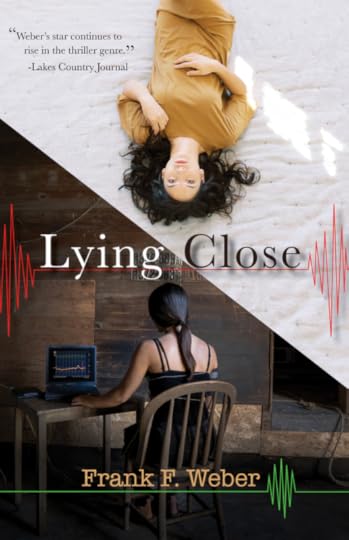
 Thank you all for making the True Crime Tuesdays a tremendous success! I would like to offer one more family story, followed by a plethora of old family pictures.
Thank you all for making the True Crime Tuesdays a tremendous success! I would like to offer one more family story, followed by a plethora of old family pictures. 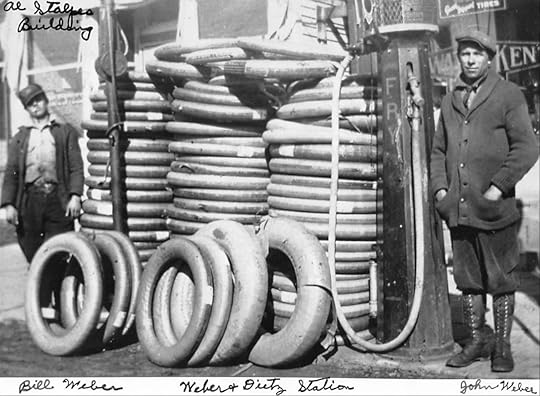 My grandparents, John and Elizabeth Weber, operated Weber’s Texaco, before Ted took over the business. (It is now Red’s Auto. When my grandparents, John and Elizabeth (Dietz) Weber, owned it, the business barely survived and they retired with nothing. The business was primarily changing tires and engine repair. Ted and Arlene (Seuss) Weber made it a stable business for a couple without children. Red and Pam (Brixius) Sitzman made it successful.)
My grandparents, John and Elizabeth Weber, operated Weber’s Texaco, before Ted took over the business. (It is now Red’s Auto. When my grandparents, John and Elizabeth (Dietz) Weber, owned it, the business barely survived and they retired with nothing. The business was primarily changing tires and engine repair. Ted and Arlene (Seuss) Weber made it a stable business for a couple without children. Red and Pam (Brixius) Sitzman made it successful.)
One evening, Grandma Elizabeth had all of the kids sitting around the table while they waited for Grandpa John to return from a hard day’s work. Grandma was a tough character, and when she noticed something was bothering John Francis (Grandpa’s oldest son from a previous marriage), she asked him to explain.
(John Francis’ mother, Margaret “Maggie” Colter, died as a result of complications of childbirth. Maggie was in Iowa at her sister’s home having the baby, while Grandpa John was gone looking for a farm to buy in Minnesota when she died.)
John Francis revealed that a bully had been picking on him at school. Grandma told him he needs to learn to stand up for himself and fight. So she had him stand, and she started jabbing him with punches, stating, “You look for an opening, and you land a solid punch.” Grandma continued to jab at him, while John Francis repeated, “I’m not going to hit you, mom.”
Finally, Grandpa swung the front door open and entered. As he did so, Grandma glanced his way, and John Francis landed a punch, knocking her to the floor. As Grandpa began yelling, “What is going on here?” Grandma directed him from the floor, “Don’t you punish that boy. He did exactly what he should have done!” And that’s my family…
Thanks for listening,
Frank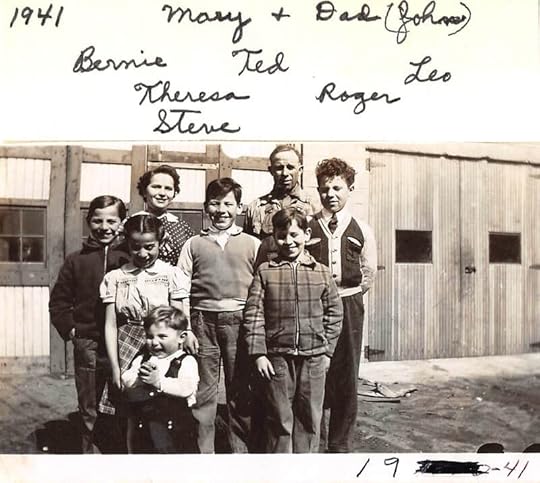

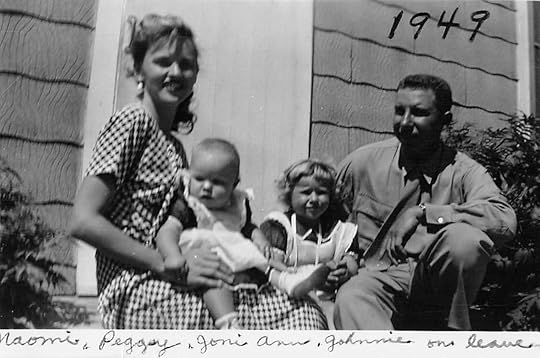
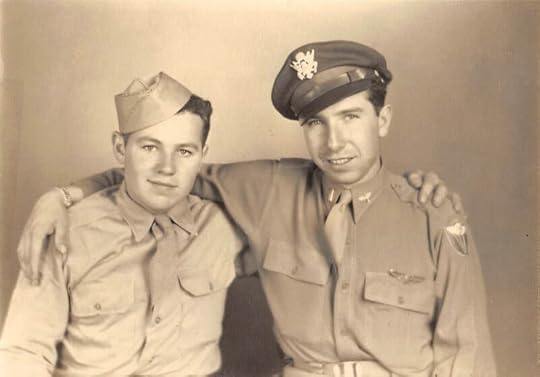
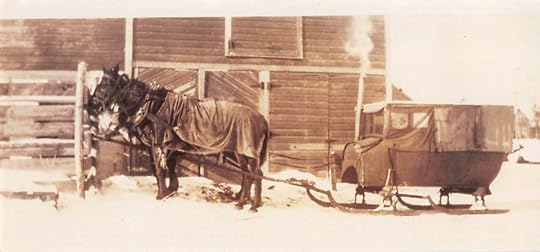


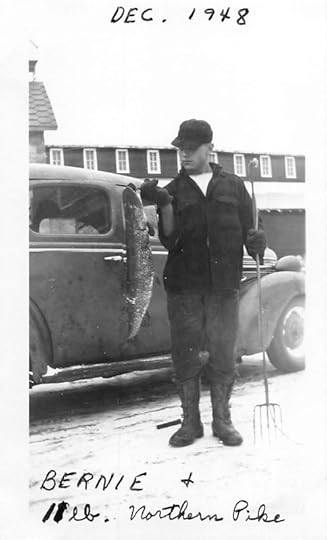
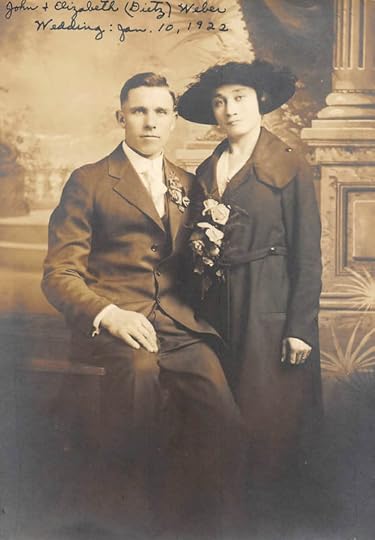

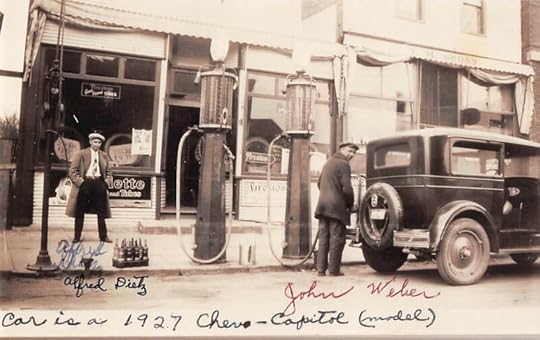
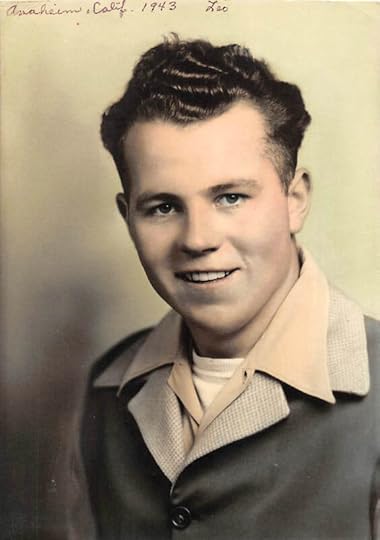


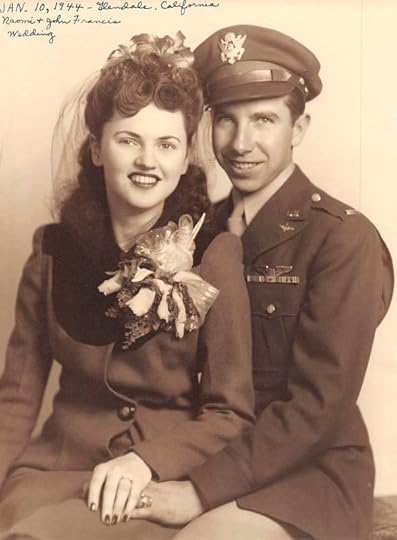


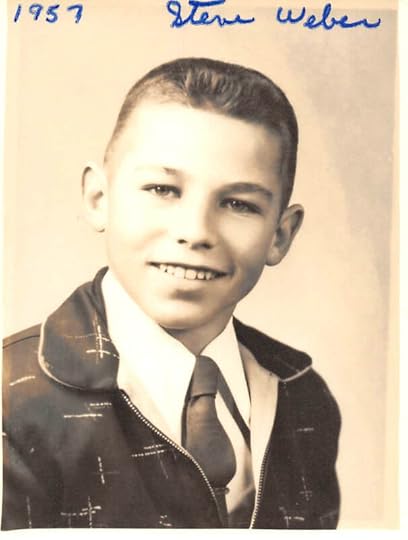

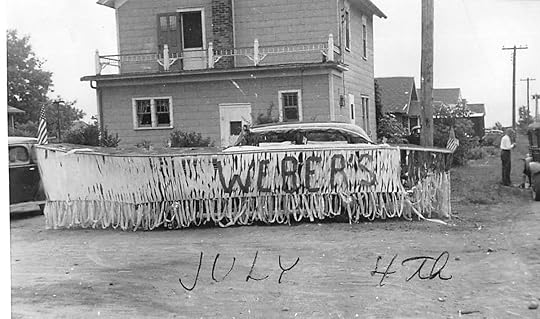
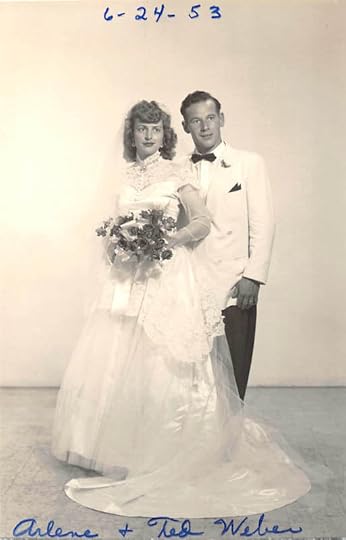



I will send the first person who gives me the title I use for book 5 a free book or audio book of their choice. Here is a quick summary of Book 5:
The book starts with a 20-year-old college student, Harper, working through the loss of her mother (through illness). Harper’s mother made her promise to never go looking for her biological father, and Harper respects her wish, until she dies. Harper discovers her birth was the result of her mother being sex-trafficked for a short period of time, before being rescued. Harper decides to find her biological father, whom she has never had contact with. {Obsessive trivia: Fertilization doesn’t occur immediately when people have sex, but can occur up to 5 days later. So by that definition, they have never met.}
Jon Frederick is hired to help her track him down. Harper naively hopes to find some redeeming quality in bio-dad. Jon’s search reveals Harper’s father was an obnoxious and arrogant man, who after 11 years of ridiculous and abusive behavior, disappears. Harper has her own personal secrets that drive her to find him and complete the story of her mother’s past, even though she loses compassion for the man. (This is based on a true story with the person’s actual criminal history revealed. I have information on this case, beyond his recorded criminal history that came from an undercover agent working in the area. It’s a great story, although at times it’s hard to believe anyone could be so obnoxious.)
Because of the man’s history, suspects in his disappearance are numerous. Jon’s task is to whittle it down, as he does so well. The reader is invited to consider the clues and solve it with him. St. Paul Pioneer Press article on Last Call:
Jon Frederick, BCA investigator, is not a happy man when we meet him in the first pages of Minnesota author Frank Weber’s “Last Call,” the final book in his Minnesota Murder trilogy. In the opening pages, Frederick is at the bedside of Jada, a woman who just gave birth to a baby she says is his. This is not good news, since Frederick is married to pregnant Serena, with whom he has a daughter. And that’s just the beginning of this twisty and sometimes violent story of betrayal.
Besides his personal woes, Frederick is assigned to investigate the disappearance of Audrey Evans, a college student who went missing in Brainerd during a snowstorm. There are few leads, and the short list of suspects is made up of men who visited the small store where Audrey worked on that night of bad weather. While Frederick is investigating, his slippery friend Clay steals Jon’s identity.
The story is told in a variety of voices, including Frederick, Jada, Serena, Clay and Audrey, whose comments are hard to read because she’s kept in a basement and repeatedly violated. But she’s also smart and patient in captivity, making friends with the wife of the man holding her prisoner. Weber pulls the threads together tightly in a blazing conclusion.
The author is a forensic psychologist with 25 years of experience, so he knows what he’s writing about when it comes to crime. First in the Minnesota Mysteries series is “Murder Book” (2017), followed by “The I-94 Murders” (2018).

 Sheila DeChantal's review of Lying Close:
Sheila DeChantal's review of Lying Close:Frank Weber is a master of the written word. I was immediately pulled into this hard to put down book that kept me thinking about it when I wasn't able to be reading, as well as thinking about it after I finished the last page. I felt like I was part of the action and able to piece the crime together alongside our protagonist. That is a feat in itself, to make the reader feel as though they are part of what is happening. I enjoy reading books by authors that have the background experience to support what they are writing - Frank Weber has all of that and more. Definitely an author to keep your eye on. This is a book that you don't just read, you experience. I personally, love an experience. I can not wait for what Frank puts to paper next.
I loved the history! I learned as I read. I also love books that are outside the norm and not following a cookie cutter pattern and I found this book to be refreshingly different and insightful from anything I've read before.
Sheila DeChantal, Writer and Book Reviewer at Book Journey

 Thank you all for making the True Crime Tuesdays a tremendous success! I would like to offer one more family story, followed by a plethora of old family pictures.
Thank you all for making the True Crime Tuesdays a tremendous success! I would like to offer one more family story, followed by a plethora of old family pictures.  My grandparents, John and Elizabeth Weber, operated Weber’s Texaco, before Ted took over the business. (It is now Red’s Auto. When my grandparents, John and Elizabeth (Dietz) Weber, owned it, the business barely survived and they retired with nothing. The business was primarily changing tires and engine repair. Ted and Arlene (Seuss) Weber made it a stable business for a couple without children. Red and Pam (Brixius) Sitzman made it successful.)
My grandparents, John and Elizabeth Weber, operated Weber’s Texaco, before Ted took over the business. (It is now Red’s Auto. When my grandparents, John and Elizabeth (Dietz) Weber, owned it, the business barely survived and they retired with nothing. The business was primarily changing tires and engine repair. Ted and Arlene (Seuss) Weber made it a stable business for a couple without children. Red and Pam (Brixius) Sitzman made it successful.)One evening, Grandma Elizabeth had all of the kids sitting around the table while they waited for Grandpa John to return from a hard day’s work. Grandma was a tough character, and when she noticed something was bothering John Francis (Grandpa’s oldest son from a previous marriage), she asked him to explain.
(John Francis’ mother, Margaret “Maggie” Colter, died as a result of complications of childbirth. Maggie was in Iowa at her sister’s home having the baby, while Grandpa John was gone looking for a farm to buy in Minnesota when she died.)
John Francis revealed that a bully had been picking on him at school. Grandma told him he needs to learn to stand up for himself and fight. So she had him stand, and she started jabbing him with punches, stating, “You look for an opening, and you land a solid punch.” Grandma continued to jab at him, while John Francis repeated, “I’m not going to hit you, mom.”
Finally, Grandpa swung the front door open and entered. As he did so, Grandma glanced his way, and John Francis landed a punch, knocking her to the floor. As Grandpa began yelling, “What is going on here?” Grandma directed him from the floor, “Don’t you punish that boy. He did exactly what he should have done!” And that’s my family…
Thanks for listening,
Frank
























Published on May 13, 2020 18:16
May 7, 2020
Poor Farm
Murder Book now available on Audio!  Thank you everyone for making True Crime Tuesday an incredible success! On the last night, I gave away 5 audio books of Murder Book, and I’m giving away 5 more to people who respond to this blog. My next book, still unnamed, takes place in the St. Cloud and Bemidji areas. Each chapter in book 5 begins with a quote from a John Prine song. I’ve received special permission from his recording studio to do this.
Thank you everyone for making True Crime Tuesday an incredible success! On the last night, I gave away 5 audio books of Murder Book, and I’m giving away 5 more to people who respond to this blog. My next book, still unnamed, takes place in the St. Cloud and Bemidji areas. Each chapter in book 5 begins with a quote from a John Prine song. I’ve received special permission from his recording studio to do this.  Bemidji In 2016, the FBI ranked Bemidji as the most dangerous city in Minnesota, based on the number of violent crimes per capita. With that said, I like Bemidji and enjoy visiting Bemidji. I will give an example of a case only a few years old, and share a little history about a Bemidji “poor farm.”
Bemidji In 2016, the FBI ranked Bemidji as the most dangerous city in Minnesota, based on the number of violent crimes per capita. With that said, I like Bemidji and enjoy visiting Bemidji. I will give an example of a case only a few years old, and share a little history about a Bemidji “poor farm.”
In June of 2016, firefighters respond to a fire at Hillcrest Manor trailer park in Bemidji to find Melissa Norby’s body buried in the rubble. Melissa’s hands were bound with duct tape. Hours into the arson-murder investigation, Amanda Smith tells police officers that Melissa was babysitting her 5-year-old daughter the night of the fire, but the girl was nowhere to be found. She had allowed her daughter to stay at Melissa's house at least 20 different times, as Melissa was someone Amanda trusted and had known for decades.
During a conversation with one of Melissa's friends, investigators soon learn disturbing details about Melissa’s (a single mom) sex life. After analyzing her computer, cell phone records, and talking with close friends they realize Melissa was very into ‘daddy-little girl’ sexual scenarios that she was playing out with her new friend “Chance.” At times the sex was rough, and had even turned violent. A friend thought the relationship “ended in him punching her and choking her out and putting over the back of the SUV and raping her." Detectives learn "Chance's" real name is Jake, and he owns a food truck called Jake's Eats. They immediately recognize him.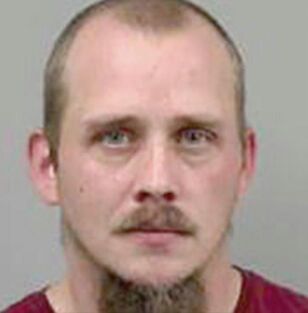 "We discovered that our dead victim was dating Jacob Kinn. We knew Jacob Kinn, and we went 'Oh my God,'" said BCA Special Agent Chad Museus. Jacob Kinn was a registered sex offender, well-known to law enforcement in Bemidji. "He actually put an ad out on Craigslist asking to take photos of a young girl. And we, the sheriff's office here, sent an undercover deputy, she posed as the mother of a 8- 9-year-old-girl, and he was convicted on some charges related to that."
"We discovered that our dead victim was dating Jacob Kinn. We knew Jacob Kinn, and we went 'Oh my God,'" said BCA Special Agent Chad Museus. Jacob Kinn was a registered sex offender, well-known to law enforcement in Bemidji. "He actually put an ad out on Craigslist asking to take photos of a young girl. And we, the sheriff's office here, sent an undercover deputy, she posed as the mother of a 8- 9-year-old-girl, and he was convicted on some charges related to that."
Jacob Kinn was now the prime suspect in the murder of Melissa Norby, and the kidnapping of a 5-year-old girl. Cops needed to find him quickly. "He was obsessed with child porn. He would, almost continuous throughout the day, access some image-sharing sites of young girls," said BCA Special Agent Paul Gherardi.
Jacob Kinn claims he was fishing on Clear Lake at the time the girl disappeared. But his cell phone records place him near Bigfork, Minnesota. Further examination of his cell phone by Special Agents William Bennet and Jake Hodapp find Melissa had been complicit in the kidnapping of the 5-year-old girl. "She definitely wanted to do anything she could to have a relationship with him, and at all costs," said Jake Hodapp. "Jacob Kinn only maintained that relationship with Melissa because he could have access to a little girl," said Special Agent Paul Gherardi. While Melissa thought she was saving the relationship, Kinn may have planned on killing her from the onset. On the day the girl disappeared, it appears Melissa and Jacob Kinn had sex, and then she was willingly bound and tied up, to make it look like a stranger broke in and abducted the girl. But Kinn didn’t want any witnesses, so he choked her to death, while the 5-year-old waited in the next room. Melissa Norby Minnesota BCA special agents Don Newhouse and Rob Fraik were told to head to Bigfork to start searching for the girl. It was the middle of the night and not a street light in sight. Before leaving the sheriff's station, the agents got a good look at Kinn's Jeep. Newhouse stated, "The undercarriage had a lot of vegetation, grass, yellow and white flowers hanging from the undercarriage, muddy tires. It was pretty clear that he was out, we figured in a wet area, possibly driving in a hayfield or somewhere that he had to go through a lot of grass and wildflowers."
Melissa Norby Minnesota BCA special agents Don Newhouse and Rob Fraik were told to head to Bigfork to start searching for the girl. It was the middle of the night and not a street light in sight. Before leaving the sheriff's station, the agents got a good look at Kinn's Jeep. Newhouse stated, "The undercarriage had a lot of vegetation, grass, yellow and white flowers hanging from the undercarriage, muddy tires. It was pretty clear that he was out, we figured in a wet area, possibly driving in a hayfield or somewhere that he had to go through a lot of grass and wildflowers."
If you’ve ever been to Bigfork, that didn't exactly narrow down the search. “We have a Kinn who owns property in that same area, 3.1 miles from the cellphone tower,” said Chad Museus. Newhouse and Fraik make it to Bigfork just as the sun was coming up. Compliments of Mother Nature, there was a heavy downpour that night. If anyone had driven in the area recently there would be fresh tire marks. The two men start making their way from the cellphone tower to the direction of the ping from Kinn's phone. They found tracks matching the tires on Kinn's Jeep. After about a half-mile, the gravel road came to an end. And it was clear which direction they needed to go.
"Nobody had driven down that road for weeks, except for those tire tracks," said Newhouse. The men get out and start to follow the tracks on foot. "Had it not been for the tracks, we would have been focusing our efforts somewhere else," said Newhouse. After walking about half a mile, detectives spot a camper off in the distance. The tire tracks they were following led right to it.
The door to the camper was taped shut with electrical tape. Fraik removes the tape and slowly opens the door. And there is the 5-year-old girl, alive. Both agents were trembling with adrenaline and joy. Her ankles and legs were taped together. She shows the officers scrapes and bruises on her arms, and says it's the only thing that hurts. It had been a long sleepless night for Amanda Smith, the 5-year-old’s mother. She finally got the phone call she'll never forget. Her daughter is alive and has been rescued. Amanda states with regard to her daughter, “The strength that radiates from her is unbelievable … we are so incredibly thankful.”
It had been a long sleepless night for Amanda Smith, the 5-year-old’s mother. She finally got the phone call she'll never forget. Her daughter is alive and has been rescued. Amanda states with regard to her daughter, “The strength that radiates from her is unbelievable … we are so incredibly thankful.”
About 90 minutes later, Jacob Kinn is spotted behind the wheel of his dad's truck heading north. He's pulled over and taken into custody. "He's located on his way back out to that camper in Bigfork," said Museus. "Either he was going to kill her or move her or hide or do something to keep us from finding her."
Eventually, Kinn admits that after he killed Melissa, he took the child to his home in Bemidji and tied her up. He then went back to Melissa’s trailer home, doused it in gas, and set it on fire. Kinn then returned home, assaulted the child, tied her up again and went to work. When he returned home from work, he took the girl to a pop-up camper he owned near Bigfork and left her there.
Jacob William Kinn, age 33, pled guilty to 2nd Degree Unintentional Murder (claiming Melissa enjoyed being choked and he simply did it too long), Kidnapping, and Criminal Sexual Conduct in the 1st Degree. On June 26, 2017, Kinn was sentenced to 52 years in prison. (As a child molester in prison, that will be hard time.)
The Beltrami County Poor Farm provided shelter and care for elderly and disabled people from 1902 until 1935, when social security replaced the poor farm system.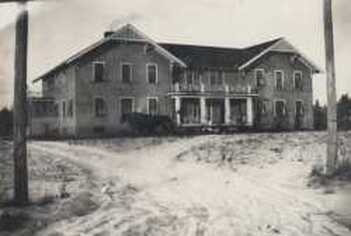 In 1901, the Beltrami County Board of Commissioners decided to purchase land suitable for a farm complex that would care for the county’s poor citizens. While large cities in Minnesota (and across the US) supported poor houses and houses of charity, rural areas established poor farms and tried to make them well run and self-sustaining. Beltrami County was one of the sixty-three Minnesota counties, out of a total of eighty-seven, that maintained a poor farm at some point in its history.
In 1901, the Beltrami County Board of Commissioners decided to purchase land suitable for a farm complex that would care for the county’s poor citizens. While large cities in Minnesota (and across the US) supported poor houses and houses of charity, rural areas established poor farms and tried to make them well run and self-sustaining. Beltrami County was one of the sixty-three Minnesota counties, out of a total of eighty-seven, that maintained a poor farm at some point in its history.
Beltrami County purchased the property on August 2, 1901, in Section 14 of Bemidji Township, directly east of the city limits. They built a main building and a second small building for quarantine and hospital purposes in September 1901.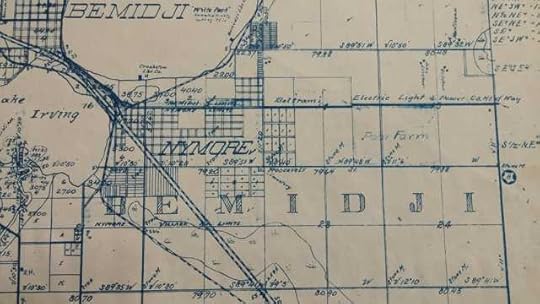 It’s lightly written, but if you look close to the center, right side of this map, you see the location of the poor farm.
It’s lightly written, but if you look close to the center, right side of this map, you see the location of the poor farm.
They took bids to run the farm and H. J. Armstrong, the lowest bidder, was appointed farm superintendent. His salary was fixed at $50 per month, starting on the first day of January 1902. This salary included the services of Mrs. Armstrong as cook and matron. Neighbors hired by the superintendent often helped with outside work; residents who were able to perform labor did so and helped keep the farm functioning.
The Beltrami County Poor Farm was run with great economy. It consisted of a house, a four-story barn, a granary, a pest house, a smoke house, and a root cellar on thirty-two acres of land. The pest house was a separate building and housed people with contagious diseases, particularly diphtheria, smallpox, and typhoid. Epidemics that originated in lumber camps—homes for many farm residents—were a common concern. After the logging era passed, the farm formally became known as the Detention Hospital.
The farm included a “paupers’” cemetery on a two-acre tract of land set aside for that purpose. Beltrami County paid for coffins as well as the services of an undertaker and a gravedigger, who placed an upright board with the name of the deceased and date of death at the head of each grave.
When farm’s main building burned on March 10, 1914, its residents were moved to various locations throughout the city. At that time, there were nine residents (commonly referred to as inmates). In 1920, the county constructed a new building. It opened on April 1, 1920, with a new name: the Beltrami County Infirmary. At the time, it was considered one of the most modern institutions in the Northwest. Locally, it was still referred to as “the poor farm.” After the Social Security Act mandated old-age assistance in 1935, several Minnesota counties closed their poor houses. Ten of them, including Beltrami County, followed a different course of action: selling their poor farms to private buyers. After Beltrami County leased its farm to Arthur Spears, it was no longer regarded as a poor house, and the resident population of the farm quickly grew. In 1937, Arthur Spears bought much of the property, and it became a private facility.
After the Social Security Act mandated old-age assistance in 1935, several Minnesota counties closed their poor houses. Ten of them, including Beltrami County, followed a different course of action: selling their poor farms to private buyers. After Beltrami County leased its farm to Arthur Spears, it was no longer regarded as a poor house, and the resident population of the farm quickly grew. In 1937, Arthur Spears bought much of the property, and it became a private facility.
As decades passed, the farm’s cemetery became a pasture. Grave markers rotted or were lost, and in 1967, Beltrami County sold a portion of the property to a private owner. In 1979, however, it exchanged land deeds with the owner to regain ownership. The land was cleared, fenced, and once again marked off as a cemetery. The records containing information relating to adoptions and illegitimate births from 1904 to 1916 were restricted for 100 years, but are now public information. They would be listed in the State Archives, MN Historical Society in St. Paul under Nymore (Beltrami County).
Conclusion: We need to take care of each other and look out for others.
Thanks for listening,
Frank
I’ve been listening to a variety of music lately, and this song reminded me of being extra caring to the ones you love.
 Thank you everyone for making True Crime Tuesday an incredible success! On the last night, I gave away 5 audio books of Murder Book, and I’m giving away 5 more to people who respond to this blog. My next book, still unnamed, takes place in the St. Cloud and Bemidji areas. Each chapter in book 5 begins with a quote from a John Prine song. I’ve received special permission from his recording studio to do this.
Thank you everyone for making True Crime Tuesday an incredible success! On the last night, I gave away 5 audio books of Murder Book, and I’m giving away 5 more to people who respond to this blog. My next book, still unnamed, takes place in the St. Cloud and Bemidji areas. Each chapter in book 5 begins with a quote from a John Prine song. I’ve received special permission from his recording studio to do this.  Bemidji In 2016, the FBI ranked Bemidji as the most dangerous city in Minnesota, based on the number of violent crimes per capita. With that said, I like Bemidji and enjoy visiting Bemidji. I will give an example of a case only a few years old, and share a little history about a Bemidji “poor farm.”
Bemidji In 2016, the FBI ranked Bemidji as the most dangerous city in Minnesota, based on the number of violent crimes per capita. With that said, I like Bemidji and enjoy visiting Bemidji. I will give an example of a case only a few years old, and share a little history about a Bemidji “poor farm.”In June of 2016, firefighters respond to a fire at Hillcrest Manor trailer park in Bemidji to find Melissa Norby’s body buried in the rubble. Melissa’s hands were bound with duct tape. Hours into the arson-murder investigation, Amanda Smith tells police officers that Melissa was babysitting her 5-year-old daughter the night of the fire, but the girl was nowhere to be found. She had allowed her daughter to stay at Melissa's house at least 20 different times, as Melissa was someone Amanda trusted and had known for decades.
During a conversation with one of Melissa's friends, investigators soon learn disturbing details about Melissa’s (a single mom) sex life. After analyzing her computer, cell phone records, and talking with close friends they realize Melissa was very into ‘daddy-little girl’ sexual scenarios that she was playing out with her new friend “Chance.” At times the sex was rough, and had even turned violent. A friend thought the relationship “ended in him punching her and choking her out and putting over the back of the SUV and raping her." Detectives learn "Chance's" real name is Jake, and he owns a food truck called Jake's Eats. They immediately recognize him.
 "We discovered that our dead victim was dating Jacob Kinn. We knew Jacob Kinn, and we went 'Oh my God,'" said BCA Special Agent Chad Museus. Jacob Kinn was a registered sex offender, well-known to law enforcement in Bemidji. "He actually put an ad out on Craigslist asking to take photos of a young girl. And we, the sheriff's office here, sent an undercover deputy, she posed as the mother of a 8- 9-year-old-girl, and he was convicted on some charges related to that."
"We discovered that our dead victim was dating Jacob Kinn. We knew Jacob Kinn, and we went 'Oh my God,'" said BCA Special Agent Chad Museus. Jacob Kinn was a registered sex offender, well-known to law enforcement in Bemidji. "He actually put an ad out on Craigslist asking to take photos of a young girl. And we, the sheriff's office here, sent an undercover deputy, she posed as the mother of a 8- 9-year-old-girl, and he was convicted on some charges related to that."
Jacob Kinn was now the prime suspect in the murder of Melissa Norby, and the kidnapping of a 5-year-old girl. Cops needed to find him quickly. "He was obsessed with child porn. He would, almost continuous throughout the day, access some image-sharing sites of young girls," said BCA Special Agent Paul Gherardi.
Jacob Kinn claims he was fishing on Clear Lake at the time the girl disappeared. But his cell phone records place him near Bigfork, Minnesota. Further examination of his cell phone by Special Agents William Bennet and Jake Hodapp find Melissa had been complicit in the kidnapping of the 5-year-old girl. "She definitely wanted to do anything she could to have a relationship with him, and at all costs," said Jake Hodapp. "Jacob Kinn only maintained that relationship with Melissa because he could have access to a little girl," said Special Agent Paul Gherardi. While Melissa thought she was saving the relationship, Kinn may have planned on killing her from the onset. On the day the girl disappeared, it appears Melissa and Jacob Kinn had sex, and then she was willingly bound and tied up, to make it look like a stranger broke in and abducted the girl. But Kinn didn’t want any witnesses, so he choked her to death, while the 5-year-old waited in the next room.
 Melissa Norby Minnesota BCA special agents Don Newhouse and Rob Fraik were told to head to Bigfork to start searching for the girl. It was the middle of the night and not a street light in sight. Before leaving the sheriff's station, the agents got a good look at Kinn's Jeep. Newhouse stated, "The undercarriage had a lot of vegetation, grass, yellow and white flowers hanging from the undercarriage, muddy tires. It was pretty clear that he was out, we figured in a wet area, possibly driving in a hayfield or somewhere that he had to go through a lot of grass and wildflowers."
Melissa Norby Minnesota BCA special agents Don Newhouse and Rob Fraik were told to head to Bigfork to start searching for the girl. It was the middle of the night and not a street light in sight. Before leaving the sheriff's station, the agents got a good look at Kinn's Jeep. Newhouse stated, "The undercarriage had a lot of vegetation, grass, yellow and white flowers hanging from the undercarriage, muddy tires. It was pretty clear that he was out, we figured in a wet area, possibly driving in a hayfield or somewhere that he had to go through a lot of grass and wildflowers."
If you’ve ever been to Bigfork, that didn't exactly narrow down the search. “We have a Kinn who owns property in that same area, 3.1 miles from the cellphone tower,” said Chad Museus. Newhouse and Fraik make it to Bigfork just as the sun was coming up. Compliments of Mother Nature, there was a heavy downpour that night. If anyone had driven in the area recently there would be fresh tire marks. The two men start making their way from the cellphone tower to the direction of the ping from Kinn's phone. They found tracks matching the tires on Kinn's Jeep. After about a half-mile, the gravel road came to an end. And it was clear which direction they needed to go.
"Nobody had driven down that road for weeks, except for those tire tracks," said Newhouse. The men get out and start to follow the tracks on foot. "Had it not been for the tracks, we would have been focusing our efforts somewhere else," said Newhouse. After walking about half a mile, detectives spot a camper off in the distance. The tire tracks they were following led right to it.
The door to the camper was taped shut with electrical tape. Fraik removes the tape and slowly opens the door. And there is the 5-year-old girl, alive. Both agents were trembling with adrenaline and joy. Her ankles and legs were taped together. She shows the officers scrapes and bruises on her arms, and says it's the only thing that hurts.
 It had been a long sleepless night for Amanda Smith, the 5-year-old’s mother. She finally got the phone call she'll never forget. Her daughter is alive and has been rescued. Amanda states with regard to her daughter, “The strength that radiates from her is unbelievable … we are so incredibly thankful.”
It had been a long sleepless night for Amanda Smith, the 5-year-old’s mother. She finally got the phone call she'll never forget. Her daughter is alive and has been rescued. Amanda states with regard to her daughter, “The strength that radiates from her is unbelievable … we are so incredibly thankful.”About 90 minutes later, Jacob Kinn is spotted behind the wheel of his dad's truck heading north. He's pulled over and taken into custody. "He's located on his way back out to that camper in Bigfork," said Museus. "Either he was going to kill her or move her or hide or do something to keep us from finding her."
Eventually, Kinn admits that after he killed Melissa, he took the child to his home in Bemidji and tied her up. He then went back to Melissa’s trailer home, doused it in gas, and set it on fire. Kinn then returned home, assaulted the child, tied her up again and went to work. When he returned home from work, he took the girl to a pop-up camper he owned near Bigfork and left her there.
Jacob William Kinn, age 33, pled guilty to 2nd Degree Unintentional Murder (claiming Melissa enjoyed being choked and he simply did it too long), Kidnapping, and Criminal Sexual Conduct in the 1st Degree. On June 26, 2017, Kinn was sentenced to 52 years in prison. (As a child molester in prison, that will be hard time.)
The Beltrami County Poor Farm provided shelter and care for elderly and disabled people from 1902 until 1935, when social security replaced the poor farm system.
 In 1901, the Beltrami County Board of Commissioners decided to purchase land suitable for a farm complex that would care for the county’s poor citizens. While large cities in Minnesota (and across the US) supported poor houses and houses of charity, rural areas established poor farms and tried to make them well run and self-sustaining. Beltrami County was one of the sixty-three Minnesota counties, out of a total of eighty-seven, that maintained a poor farm at some point in its history.
In 1901, the Beltrami County Board of Commissioners decided to purchase land suitable for a farm complex that would care for the county’s poor citizens. While large cities in Minnesota (and across the US) supported poor houses and houses of charity, rural areas established poor farms and tried to make them well run and self-sustaining. Beltrami County was one of the sixty-three Minnesota counties, out of a total of eighty-seven, that maintained a poor farm at some point in its history.
Beltrami County purchased the property on August 2, 1901, in Section 14 of Bemidji Township, directly east of the city limits. They built a main building and a second small building for quarantine and hospital purposes in September 1901.
 It’s lightly written, but if you look close to the center, right side of this map, you see the location of the poor farm.
It’s lightly written, but if you look close to the center, right side of this map, you see the location of the poor farm.
They took bids to run the farm and H. J. Armstrong, the lowest bidder, was appointed farm superintendent. His salary was fixed at $50 per month, starting on the first day of January 1902. This salary included the services of Mrs. Armstrong as cook and matron. Neighbors hired by the superintendent often helped with outside work; residents who were able to perform labor did so and helped keep the farm functioning.
The Beltrami County Poor Farm was run with great economy. It consisted of a house, a four-story barn, a granary, a pest house, a smoke house, and a root cellar on thirty-two acres of land. The pest house was a separate building and housed people with contagious diseases, particularly diphtheria, smallpox, and typhoid. Epidemics that originated in lumber camps—homes for many farm residents—were a common concern. After the logging era passed, the farm formally became known as the Detention Hospital.
The farm included a “paupers’” cemetery on a two-acre tract of land set aside for that purpose. Beltrami County paid for coffins as well as the services of an undertaker and a gravedigger, who placed an upright board with the name of the deceased and date of death at the head of each grave.
When farm’s main building burned on March 10, 1914, its residents were moved to various locations throughout the city. At that time, there were nine residents (commonly referred to as inmates). In 1920, the county constructed a new building. It opened on April 1, 1920, with a new name: the Beltrami County Infirmary. At the time, it was considered one of the most modern institutions in the Northwest. Locally, it was still referred to as “the poor farm.”
 After the Social Security Act mandated old-age assistance in 1935, several Minnesota counties closed their poor houses. Ten of them, including Beltrami County, followed a different course of action: selling their poor farms to private buyers. After Beltrami County leased its farm to Arthur Spears, it was no longer regarded as a poor house, and the resident population of the farm quickly grew. In 1937, Arthur Spears bought much of the property, and it became a private facility.
After the Social Security Act mandated old-age assistance in 1935, several Minnesota counties closed their poor houses. Ten of them, including Beltrami County, followed a different course of action: selling their poor farms to private buyers. After Beltrami County leased its farm to Arthur Spears, it was no longer regarded as a poor house, and the resident population of the farm quickly grew. In 1937, Arthur Spears bought much of the property, and it became a private facility.As decades passed, the farm’s cemetery became a pasture. Grave markers rotted or were lost, and in 1967, Beltrami County sold a portion of the property to a private owner. In 1979, however, it exchanged land deeds with the owner to regain ownership. The land was cleared, fenced, and once again marked off as a cemetery. The records containing information relating to adoptions and illegitimate births from 1904 to 1916 were restricted for 100 years, but are now public information. They would be listed in the State Archives, MN Historical Society in St. Paul under Nymore (Beltrami County).
Conclusion: We need to take care of each other and look out for others.
Thanks for listening,
Frank
I’ve been listening to a variety of music lately, and this song reminded me of being extra caring to the ones you love.
Published on May 07, 2020 10:27
May 3, 2020
Insurance Fraud
Yes… 1 more week of True Crime Tuesday! I will be live on Facebook May 5, 2020, from 7:00 to 7:30 pm. Go to
www.facebook.com/FrankWeberauthor/
This will be my last Facebook live event for now. I’m currently writing a thriller, based on a true crime case. I want to use the criminal’s actual history in the book, but I also don’t want to risk losing the reader’s interest. So this Tuesday, I will address how it’s presented as written so far and accept feedback.
In the actual case, the body was found down this logging road near Bemidji.
Insurance Fraud
Insurance Fraud
In 1999, Beverly Hills ophthalmologist Steve G. Cooperman managed to get a $12.5 million insurance policy from Huntington T. Block insurance brokerage, on two paintings worth a total of $2.5 million. Does anybody else see a problem developing? The paintings were Claude Monet’s 1882 “Customs Officer’s Cabin at Pourville” (pictured below), and Pablo Picasso’s 1932 “Nude Before a Mirror.” Surprise, surprise, they were reported stolen from his home. Law officials were skeptical of the theft report from the beginning, but it took five years for the truth to come out. Claude Monet’s 1882 “Custom Officer’s Cabin at Pourville.” Cooperman’s license was canceled by the California Medical Board amid accusations of fraud. He had been in financial distress at the time of the theft, with more than $6 million in outstanding loans. Chase Manhattan Bank was pressuring him to make a payment on its $4-million loan--for which the art was collateral--and First Interstate Bank had sued him.
Claude Monet’s 1882 “Custom Officer’s Cabin at Pourville.” Cooperman’s license was canceled by the California Medical Board amid accusations of fraud. He had been in financial distress at the time of the theft, with more than $6 million in outstanding loans. Chase Manhattan Bank was pressuring him to make a payment on its $4-million loan--for which the art was collateral--and First Interstate Bank had sued him.
His attorney’s ex-lover, Pamela Davis, tipped police to the whereabouts of the missing paintings and is pursuing the $250,000 reward offered for their recovery. “It’s an unfortunate tragedy, however justice was served.” Pamela said with a chuckle: “I’m going to Disney World.”
I understand the consequences, but something about the way this was resolved doesn’t seem right. Would she have reported the theft had she stayed with the attorney? She hadn’t… Picasso’s 1932 “Nude Before a Mirror.” Cooperman was convicted of conspiracy and fraud, and sentenced to three years in jail.
Picasso’s 1932 “Nude Before a Mirror.” Cooperman was convicted of conspiracy and fraud, and sentenced to three years in jail.
I’m not an art expert. I do know I wouldn’t pay $5 for this Picasso painting, if I wasn’t allowed to sell it. I would pay $5 for the Monet, although I always wonder what Monet’s paintings would have looked like if he had decent glasses. With that said, I often go to the Modern Museum of Art when I go to cities and admire some work and laugh at others. Still, I find myself leaving these museums with renewed creativity and I can’t typically explain where it came from.
As a business owner and employer of about 50 people, the cost of health insurance infuriates me. Every year the plans become more difficult to understand, as companies find new ways to hide the fact that people are paying more for less coverage. People are stuck with higher and higher deductibles every year. Further, the cost is so high, and the coverage is so poor, that every community has “Go Fund Me” pages to try to help out people who can’t pay for the care they need to survive.
The American prison system led me to this blog. Most states have “socialized” law enforcement and prison systems. Some states have private prisons, and the private prisons are the environments where the worst types of abuse takes place. The guards are underpaid and the prisons are under supervised, so you have guards who get paid off or look the other way out of convenience. In addition, imagine how corrupt law enforcement could be if it was run by a private agency. We benefit from our local police not being on a private payroll. With that said, I’m a strong advocate of capitalism for most things. As a matter of fact, I’d argue that we are not as capitalist as we should be. We pay more for cell phones and plane tickets than other developed countries because we’ve allowed large companies to monopolize areas of the country and state so we no longer have decent competition. Many poorer countries have better internet than we have in the U.S.
With that said, I’m a strong advocate of capitalism for most things. As a matter of fact, I’d argue that we are not as capitalist as we should be. We pay more for cell phones and plane tickets than other developed countries because we’ve allowed large companies to monopolize areas of the country and state so we no longer have decent competition. Many poorer countries have better internet than we have in the U.S.
Since insurance, in the context of health care, will be a major issue in the 2020 presidential election I’d like to say a few words about it. To clarify, I don’t identify with either political party. For 30 years I’ve stated that I’d vote for the candidate that will make the wealthiest Americans pay the same percentage of what I and the majority of the middle class pays in taxes, and for 30 years the gap has increased. I still stand by this. Regardless of the % figures you see proposed, the bottom line is they don’t, as they are given advantages and loopholes.
Here is the Forbes income level for the top 18 presidential candidates for 2016. All paid a lower % in income taxes than I do.
1. Donald Trump $4.5 bil Richest candidate
2. Carly Fiorina $58 mil Former HP CEO has over 1,000 investments.
3. Hillary Clinton $45 mil The Clintons earned $28 million in 2014.
4. Lincoln Chafee $32 mil Rhode Island royalty inherited fortune
5. Ben Carson $26 mil Retired neurosurgeon on boards of Costco, Kellogg
6. Jeb Bush $22 mil Fortune up nearly sixteenfold since leaving office in 2007.
7. George Pataki $13 mil Former N.Y. governor; advises on energy, environment.
8. John Kasich $10 mil Worked at Lehman Bros.; hosted Fox show.
9. Mike Huckabee $9 mil Radio host made millions on Fox, giving speeches .
10. Jim Gilmore $7 mil AG has money in cash, stocks.
11. Jim Webb $6 mil Wrote script for Rules of Engagement .
12. Bobby Jindal $5 mil Louisiana governor makes about $130,000 a year.
13. Ted Cruz $3.5 mil Tea Partier practiced law; wife works at Goldman Sachs.
14. Chris Christie $3 mil Wife made the money on Wall Street while he ran N.J.
15. Rand Paul $2 mil Ophthalmology practice for $220,000; wrote 4 books.
16. Rick Santorum $2 mil Collects rent on six properties near Penn State.
17. Lindsey Graham $1 mil Senator gets fortune from homes, salary.
18. Bernie Sanders $700,000 Senator worked as a carpenter and a filmmaker.
 Getting back to healthcare. I’m not sure if we should go to nationalized healthcare, but people should realize it isn’t more expensive. If you simply look at what we pay in taxes compared to countries that have national healthcare, we pay less. However, if you combine what we pay in taxes with what we pay in healthcare, we pay more than they do.
Getting back to healthcare. I’m not sure if we should go to nationalized healthcare, but people should realize it isn’t more expensive. If you simply look at what we pay in taxes compared to countries that have national healthcare, we pay less. However, if you combine what we pay in taxes with what we pay in healthcare, we pay more than they do.
Take a look at a high tax country like Finland. An American family earning around $43,000, pays 37 % of their income in taxes and health care premiums. In high-tax Finland, the same type of family pays 23 % of their income in taxes and to support their universal health care.
We have great medical care in the U.S., for those who can afford to access it. But our care and medication is ridiculously expensive. Families in particular are punished in the U.S. with high family premiums which result in middle class families paying 40% of their income in taxes and medical care. The % of Americans with healthcare decreased over the last 2 years while the % of uninsured children increased. (This is before the pandemic)
Another general problem with America's healthcare system is that most of the money is being spent on intervention after people already are sick. We need to spend more money and resources keeping people healthy in the first place. In the long run, we’d save money.
In 2018, 8.5 % of Americans, or 27.5 million, did not have health insurance at any point during the year. The uninsured rate and number of uninsured increased from 2017 (7.9 percent or 25.6 million).
Odd insurance facts:
Alien abduction coverage exists and has since 1987.Hole-in-one insurance policies cover lavish spending, grand prizes and over-the-top parties after a golfer gets a hole-in-one. It’s particularly popular in Japan.Steven Spielberg has the most expensive life insurance policy in the world at $1.2 billion.The idea for GPS was born in an MIT lab, but wasn’t patented there because it was believed insurance companies wouldn’t ever let people drive with a device navigating them.Astronauts aboard the Apollo 11 weren’t offered life insurance, so instead they left behind hundreds of autographed posters for their families to sell if anything happened to them.
The rolling green hills and blue sky featured as the background of every Microsoft computer (pictured below) is an actual photograph Microsoft purchased—a photograph so valuable that the insurance to ship it was too high, so Microsoft paid to have it retrieved and delivered by hand instead. Ending on the art theme. There is amazing art in every community to appreciate, and I’m proud to be a member of the Crossing Arts Alliance in Brainerd.
Ending on the art theme. There is amazing art in every community to appreciate, and I’m proud to be a member of the Crossing Arts Alliance in Brainerd. 

 Thanks for listening,
Thanks for listening,
Frank
Music can help when stressed. I’ve listened to this song at times, since high school, and it still makes me smile. Love and be kind…
This will be my last Facebook live event for now. I’m currently writing a thriller, based on a true crime case. I want to use the criminal’s actual history in the book, but I also don’t want to risk losing the reader’s interest. So this Tuesday, I will address how it’s presented as written so far and accept feedback.
In the actual case, the body was found down this logging road near Bemidji.

Insurance Fraud
Insurance Fraud
In 1999, Beverly Hills ophthalmologist Steve G. Cooperman managed to get a $12.5 million insurance policy from Huntington T. Block insurance brokerage, on two paintings worth a total of $2.5 million. Does anybody else see a problem developing? The paintings were Claude Monet’s 1882 “Customs Officer’s Cabin at Pourville” (pictured below), and Pablo Picasso’s 1932 “Nude Before a Mirror.” Surprise, surprise, they were reported stolen from his home. Law officials were skeptical of the theft report from the beginning, but it took five years for the truth to come out.
 Claude Monet’s 1882 “Custom Officer’s Cabin at Pourville.” Cooperman’s license was canceled by the California Medical Board amid accusations of fraud. He had been in financial distress at the time of the theft, with more than $6 million in outstanding loans. Chase Manhattan Bank was pressuring him to make a payment on its $4-million loan--for which the art was collateral--and First Interstate Bank had sued him.
Claude Monet’s 1882 “Custom Officer’s Cabin at Pourville.” Cooperman’s license was canceled by the California Medical Board amid accusations of fraud. He had been in financial distress at the time of the theft, with more than $6 million in outstanding loans. Chase Manhattan Bank was pressuring him to make a payment on its $4-million loan--for which the art was collateral--and First Interstate Bank had sued him.His attorney’s ex-lover, Pamela Davis, tipped police to the whereabouts of the missing paintings and is pursuing the $250,000 reward offered for their recovery. “It’s an unfortunate tragedy, however justice was served.” Pamela said with a chuckle: “I’m going to Disney World.”
I understand the consequences, but something about the way this was resolved doesn’t seem right. Would she have reported the theft had she stayed with the attorney? She hadn’t…
 Picasso’s 1932 “Nude Before a Mirror.” Cooperman was convicted of conspiracy and fraud, and sentenced to three years in jail.
Picasso’s 1932 “Nude Before a Mirror.” Cooperman was convicted of conspiracy and fraud, and sentenced to three years in jail.I’m not an art expert. I do know I wouldn’t pay $5 for this Picasso painting, if I wasn’t allowed to sell it. I would pay $5 for the Monet, although I always wonder what Monet’s paintings would have looked like if he had decent glasses. With that said, I often go to the Modern Museum of Art when I go to cities and admire some work and laugh at others. Still, I find myself leaving these museums with renewed creativity and I can’t typically explain where it came from.
As a business owner and employer of about 50 people, the cost of health insurance infuriates me. Every year the plans become more difficult to understand, as companies find new ways to hide the fact that people are paying more for less coverage. People are stuck with higher and higher deductibles every year. Further, the cost is so high, and the coverage is so poor, that every community has “Go Fund Me” pages to try to help out people who can’t pay for the care they need to survive.
The American prison system led me to this blog. Most states have “socialized” law enforcement and prison systems. Some states have private prisons, and the private prisons are the environments where the worst types of abuse takes place. The guards are underpaid and the prisons are under supervised, so you have guards who get paid off or look the other way out of convenience. In addition, imagine how corrupt law enforcement could be if it was run by a private agency. We benefit from our local police not being on a private payroll.
 With that said, I’m a strong advocate of capitalism for most things. As a matter of fact, I’d argue that we are not as capitalist as we should be. We pay more for cell phones and plane tickets than other developed countries because we’ve allowed large companies to monopolize areas of the country and state so we no longer have decent competition. Many poorer countries have better internet than we have in the U.S.
With that said, I’m a strong advocate of capitalism for most things. As a matter of fact, I’d argue that we are not as capitalist as we should be. We pay more for cell phones and plane tickets than other developed countries because we’ve allowed large companies to monopolize areas of the country and state so we no longer have decent competition. Many poorer countries have better internet than we have in the U.S.Since insurance, in the context of health care, will be a major issue in the 2020 presidential election I’d like to say a few words about it. To clarify, I don’t identify with either political party. For 30 years I’ve stated that I’d vote for the candidate that will make the wealthiest Americans pay the same percentage of what I and the majority of the middle class pays in taxes, and for 30 years the gap has increased. I still stand by this. Regardless of the % figures you see proposed, the bottom line is they don’t, as they are given advantages and loopholes.
Here is the Forbes income level for the top 18 presidential candidates for 2016. All paid a lower % in income taxes than I do.
1. Donald Trump $4.5 bil Richest candidate
2. Carly Fiorina $58 mil Former HP CEO has over 1,000 investments.
3. Hillary Clinton $45 mil The Clintons earned $28 million in 2014.
4. Lincoln Chafee $32 mil Rhode Island royalty inherited fortune
5. Ben Carson $26 mil Retired neurosurgeon on boards of Costco, Kellogg
6. Jeb Bush $22 mil Fortune up nearly sixteenfold since leaving office in 2007.
7. George Pataki $13 mil Former N.Y. governor; advises on energy, environment.
8. John Kasich $10 mil Worked at Lehman Bros.; hosted Fox show.
9. Mike Huckabee $9 mil Radio host made millions on Fox, giving speeches .
10. Jim Gilmore $7 mil AG has money in cash, stocks.
11. Jim Webb $6 mil Wrote script for Rules of Engagement .
12. Bobby Jindal $5 mil Louisiana governor makes about $130,000 a year.
13. Ted Cruz $3.5 mil Tea Partier practiced law; wife works at Goldman Sachs.
14. Chris Christie $3 mil Wife made the money on Wall Street while he ran N.J.
15. Rand Paul $2 mil Ophthalmology practice for $220,000; wrote 4 books.
16. Rick Santorum $2 mil Collects rent on six properties near Penn State.
17. Lindsey Graham $1 mil Senator gets fortune from homes, salary.
18. Bernie Sanders $700,000 Senator worked as a carpenter and a filmmaker.

 Getting back to healthcare. I’m not sure if we should go to nationalized healthcare, but people should realize it isn’t more expensive. If you simply look at what we pay in taxes compared to countries that have national healthcare, we pay less. However, if you combine what we pay in taxes with what we pay in healthcare, we pay more than they do.
Getting back to healthcare. I’m not sure if we should go to nationalized healthcare, but people should realize it isn’t more expensive. If you simply look at what we pay in taxes compared to countries that have national healthcare, we pay less. However, if you combine what we pay in taxes with what we pay in healthcare, we pay more than they do.Take a look at a high tax country like Finland. An American family earning around $43,000, pays 37 % of their income in taxes and health care premiums. In high-tax Finland, the same type of family pays 23 % of their income in taxes and to support their universal health care.
We have great medical care in the U.S., for those who can afford to access it. But our care and medication is ridiculously expensive. Families in particular are punished in the U.S. with high family premiums which result in middle class families paying 40% of their income in taxes and medical care. The % of Americans with healthcare decreased over the last 2 years while the % of uninsured children increased. (This is before the pandemic)
Another general problem with America's healthcare system is that most of the money is being spent on intervention after people already are sick. We need to spend more money and resources keeping people healthy in the first place. In the long run, we’d save money.
In 2018, 8.5 % of Americans, or 27.5 million, did not have health insurance at any point during the year. The uninsured rate and number of uninsured increased from 2017 (7.9 percent or 25.6 million).
Odd insurance facts:
Alien abduction coverage exists and has since 1987.Hole-in-one insurance policies cover lavish spending, grand prizes and over-the-top parties after a golfer gets a hole-in-one. It’s particularly popular in Japan.Steven Spielberg has the most expensive life insurance policy in the world at $1.2 billion.The idea for GPS was born in an MIT lab, but wasn’t patented there because it was believed insurance companies wouldn’t ever let people drive with a device navigating them.Astronauts aboard the Apollo 11 weren’t offered life insurance, so instead they left behind hundreds of autographed posters for their families to sell if anything happened to them.
The rolling green hills and blue sky featured as the background of every Microsoft computer (pictured below) is an actual photograph Microsoft purchased—a photograph so valuable that the insurance to ship it was too high, so Microsoft paid to have it retrieved and delivered by hand instead.
 Ending on the art theme. There is amazing art in every community to appreciate, and I’m proud to be a member of the Crossing Arts Alliance in Brainerd.
Ending on the art theme. There is amazing art in every community to appreciate, and I’m proud to be a member of the Crossing Arts Alliance in Brainerd. 

 Thanks for listening,
Thanks for listening,Frank
Music can help when stressed. I’ve listened to this song at times, since high school, and it still makes me smile. Love and be kind…
Published on May 03, 2020 10:09
April 26, 2020
Hate Crime
On April 28, from 7:00 to 7:30 p.m., Frank will discuss the development of Lying Close on Facebook live. www.facebook.com/frankweberauthor
*Win a chance to be a True Crime Star! During the 4 weeks of presentations, people who make comments during the presentation will have their name put into a drawing with the winner receiving 1 of 3 choices. I will either use your name as a character, have you make a brief appearance, or use your business name somewhere in the book. (You can gift this award to a friend if you wish.)
We will have the drawing this Tuesday, April 28 at the end of the presentation.
Attend here!
Lying Close: A hunting accident, a rural home break in, and the disappearance of a teen, all occur in a 30 mile stretch of rural Minnesota. Jon Frederick realizes they are all symptoms of a larger problem. Lying Close also involves a relationship between a white rural Christian, and a Somali Muslim woman in St. Cloud. It’s hard to believe in 2020 that there are still young people in the United States who can’t tell their parents who they’re dating because of hate. Lying Close is a thrilling mystery, with a forbidden love affair.
 Poverty & Race, Heroes & their counterparts
Poverty & Race, Heroes & their counterparts
On March 14, 19-year-old Jose L. Gomez, 19, stabbed the three people at the Midland, Texas Sam's Club before being taken down by a store employee. The Texas man tried to kill an Asian American family of three because he "thought the family was Chinese, and infecting people with the coronavirus."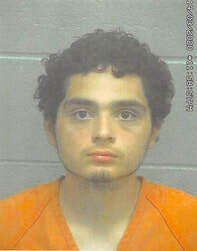 Jose Gomez
Jose Gomez  Bernie Ramirez and Zach Owen Gomez was then taken into custody by off-duty officer, Bernie Ramirez, and was charged with three counts of attempted capital murder. Ramirez initially approached Gomez and family with the intention of breaking up what he thought was a fight over scarce goods. Ramirez said "credit is due" to Zach Owen, a store employee who stopped Gomez by putting him in a chokehold. Zach suffered stab wounds to the hand in the process. "He went into a knife fight bare-handed," Ramirez said. "He took control of the individual, and he disarmed him. If Zach had not been there, things could’ve gone really badly.”
Bernie Ramirez and Zach Owen Gomez was then taken into custody by off-duty officer, Bernie Ramirez, and was charged with three counts of attempted capital murder. Ramirez initially approached Gomez and family with the intention of breaking up what he thought was a fight over scarce goods. Ramirez said "credit is due" to Zach Owen, a store employee who stopped Gomez by putting him in a chokehold. Zach suffered stab wounds to the hand in the process. "He went into a knife fight bare-handed," Ramirez said. "He took control of the individual, and he disarmed him. If Zach had not been there, things could’ve gone really badly.”  Zach Owen saved the lives of 3 strangers, simply because it was the right thing to do. Zach is an American hero!
Zach Owen saved the lives of 3 strangers, simply because it was the right thing to do. Zach is an American hero!
On March 11, a woman in New York punched another woman, telling her, “Where’s your mask, you Asian bitch?” Governor Andrew Cuomo responded: "To be clear: there is zero evidence that people of Asian descent bear any additional responsibility for the transmission of the coronavirus. This incident was not only despicable but also illegal, and I am directing the State Police Hate Crimes Task Force to assist in the investigation to make sure the assailant is held accountable. No one in this state should ever feel intimidated or threatened because of who they are or how they look. Diversity is our greatest strength - it's one of the things that makes New York great - and in difficult times we need to band together even tighter." Great response Andrew!
 The Coronavirus (or what President Trump called the “Chinese virus”) actually did start in Wuhan, China. But please keep in mind that Asian people outside of the live butchering meat markets in Wuhan, China are no more responsible for the virus than white Minnesotans are responsible for slavery. People make bad choices. If you need to categorize, then remember, not everyone in their category is responsible. Scientists have been warning that a deadly virus was going to come out of this environment for decades.
The Coronavirus (or what President Trump called the “Chinese virus”) actually did start in Wuhan, China. But please keep in mind that Asian people outside of the live butchering meat markets in Wuhan, China are no more responsible for the virus than white Minnesotans are responsible for slavery. People make bad choices. If you need to categorize, then remember, not everyone in their category is responsible. Scientists have been warning that a deadly virus was going to come out of this environment for decades.
Do you remember the “German measles,” or the pandemic of the “Spanish flu?” The German measles didn’t originate in Germany and the Spanish flu didn’t originate in Spain. It’s interesting that Small Pox, which killed so many Natives, was given such a neutral name.
In 1918 and 1919 the so-called “Spanish flu” killed 50 million people worldwide. Many Americans, including Senator Chuck Grassley, seem to believe—as the Spanish flu name implies—that this outbreak began in Spain. Grassley tweeted, “I don’t understand why China gets upset because we refer to the virus that originated there the “Chinese virus” Spain never got upset when we referred to the Spanish flu in 1918 & 1919.”
That led me to research the diseases.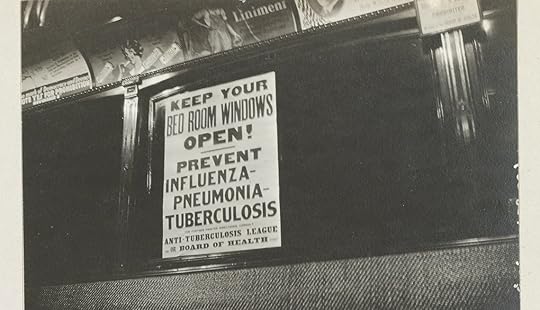 It was believed keeping your windows open would curb the Spanish flu. There is no truth to it, but a variety of misguided theories emerge with every major illness. There was an old classic movie where a sick woman was saved by opening the window. If anybody remembers the name of it, please forward it to me.
It was believed keeping your windows open would curb the Spanish flu. There is no truth to it, but a variety of misguided theories emerge with every major illness. There was an old classic movie where a sick woman was saved by opening the window. If anybody remembers the name of it, please forward it to me.
The first recorded case of the “Spanish flu” was in Kansas. As the flu spread through the U.S. and European countries during World War I, fighting nations actively censored coverage of the outbreaks. Spain, which was neutral, stood out because it was one of the only nations that accurately reported the number of people afflicted by the outbreak, leading to the perception that the flu was concentrated there. Meanwhile in Spain, it was called the “French flu.” Everybody wants to blame somebody-- An influx of Italians to the U.S. were blamed for polio, even though there was no evidence to support it.
Why was Rubella called the “German measles?” Because Germany has produced great scientists basically. German scientists were the first to identify that Rubella wasn’t a form of measles, but instead a separate disease. With anti-German sentiment being popular at the time, the disease was tagged the “German measles.” Here’s an example: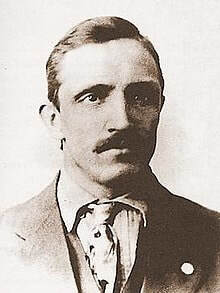 Robert Prager was lynched because he was born in Germany and anti-war. In 1918, 1 out of every 3 Americans was born outside of the United States. Perhaps the most horrendous anti-German act was the lynching in April 1918 of 29-year-old Robert Paul Prager, a German-born bakery employee, who was accused of making "disloyal utterances." Immigrants from Germany and Ireland in particular were urging America to stay out of World War I. Robert Prager had been dismissed from the local union because of his German heritage and opposition to the war. He wrote a letter to the Maryville miners, complaining that he had been treated unfairly by Local 1802 President James Fornero. "I have been a union man all times and never once a scab [strikebreaker]." He denied accusations that he was a German sympathizer. He wrote, "I am heart and soul for the good old USA. I am of German birth, of which accident I cannot help." On the afternoon of April 4, he posted copies of his letter near the Maryville mine and nearby saloons.
Robert Prager was lynched because he was born in Germany and anti-war. In 1918, 1 out of every 3 Americans was born outside of the United States. Perhaps the most horrendous anti-German act was the lynching in April 1918 of 29-year-old Robert Paul Prager, a German-born bakery employee, who was accused of making "disloyal utterances." Immigrants from Germany and Ireland in particular were urging America to stay out of World War I. Robert Prager had been dismissed from the local union because of his German heritage and opposition to the war. He wrote a letter to the Maryville miners, complaining that he had been treated unfairly by Local 1802 President James Fornero. "I have been a union man all times and never once a scab [strikebreaker]." He denied accusations that he was a German sympathizer. He wrote, "I am heart and soul for the good old USA. I am of German birth, of which accident I cannot help." On the afternoon of April 4, he posted copies of his letter near the Maryville mine and nearby saloons.
Robert Prager was a patriot who flew the American flag. After people read his posting a mob took him from his home, wrapped him tight in an American flag and marched him through the streets. The police took him into custody to protect him. The mob marched to the jail. The officers hid Robert in the sewer and told the mob he left. They allowed a couple members of the mob to have a look in the Collinsville, Illinois jail. They found Robert, dragged him outside of town, and hanged him. Before the lynching, he was allowed to write a last note to his parents in Dresden, Germany:
Dear Parents: I must on this, the 4th day of April, 1918, die. Please pray for me, my dear parents.
In the trial that followed, the defendants wore red, white, and blue ribbons, while a band in the courthouse played patriotic songs. It took the jury 25 minutes to return a not-guilty verdict. The German government lodged a protest and offered to pay Prager's funeral expenses.
Poverty & Race
Sociologist James Coleman completed an extensive study of American schools, and realized that the greatest impact on performance in schools is not race, sex, or religion. The best predictor of success in school is income. The poor do worse, in every school. Ironically, this can appear as race in graphs and data, because certain races haven’t had the same opportunities and therefore are greater represented among the poor.
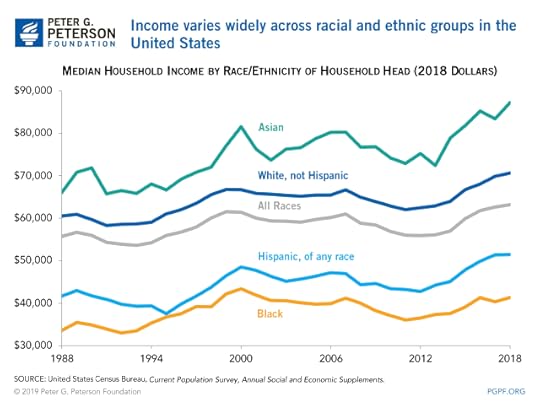 After viewing the above graph, take a look at the graphs on test performance in schools below. It is exactly the same.
After viewing the above graph, take a look at the graphs on test performance in schools below. It is exactly the same.
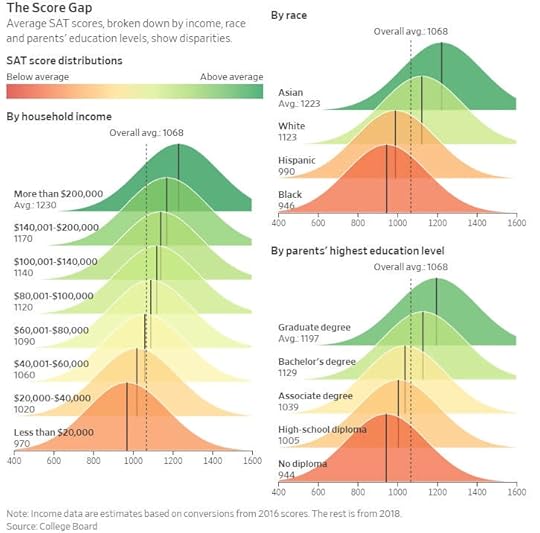
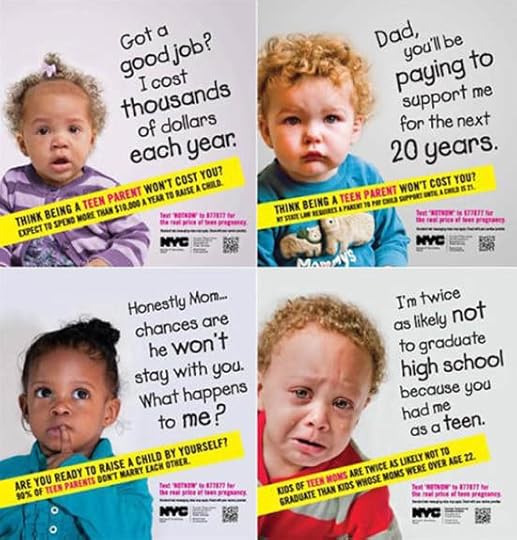
 Teen pregnancy is at its lowest level for every race in the U.S. This is an important statistic, since it is basically a ticket into poverty. Only ½ of teen mothers earn a high school diploma by age 22, compared to 90% of women without a teen birth. Teenage mothers are more likely to live in poverty and depend on public assistance. Children born to teen parents are more likely to have lower school achievement, enter the child welfare and correctional systems, drop out of high school and become teen parents themselves, compared to children born to older parents.
Teen pregnancy is at its lowest level for every race in the U.S. This is an important statistic, since it is basically a ticket into poverty. Only ½ of teen mothers earn a high school diploma by age 22, compared to 90% of women without a teen birth. Teenage mothers are more likely to live in poverty and depend on public assistance. Children born to teen parents are more likely to have lower school achievement, enter the child welfare and correctional systems, drop out of high school and become teen parents themselves, compared to children born to older parents.
2017 Teen Birth Rates
American Indian (32 per 1000)
Hispanic (29 per 1,000) *Hispanic teens of Mexican origin had birth rates similar to those for teens of Puerto Rican origin (32 and 31 per 1,000, respectively), and both were higher than the rate for Cuban teens (15 per 1,000)
African American (28 per 1,000)
American Indian and Alaska Native (22 per 1,000)
White (13 per 1,000)
Asian or Pacific Islander (7 per 1,000)
What’s ironic about this data is about 1 in 4 teens living in poverty become pregnant, regardless of race. So the pregnancy rates are basically reflective of who is living in poverty. Fortunately, teen pregnancy rates are going down for all races. My conclusion is that we need to do more to help people living in poverty and we need to be less judgmental of others. In 2019, the U.S. had a historic number of billionaires, but still a large homeless population. In Minnesota alone, there were 6,000 homeless children.
My conclusion is that we need to do more to help people living in poverty and we need to be less judgmental of others. In 2019, the U.S. had a historic number of billionaires, but still a large homeless population. In Minnesota alone, there were 6,000 homeless children.
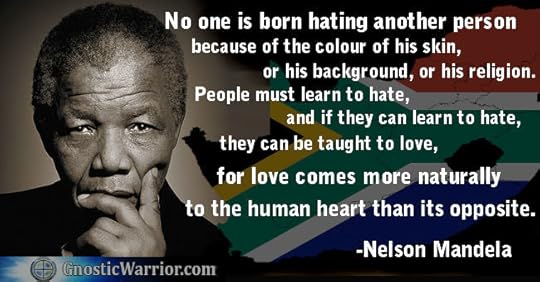 People chill out. Life is a bumpy road. We need solutions, not blame. Be kind…
People chill out. Life is a bumpy road. We need solutions, not blame. Be kind…


Thanks for listening,
Frank
*Win a chance to be a True Crime Star! During the 4 weeks of presentations, people who make comments during the presentation will have their name put into a drawing with the winner receiving 1 of 3 choices. I will either use your name as a character, have you make a brief appearance, or use your business name somewhere in the book. (You can gift this award to a friend if you wish.)
We will have the drawing this Tuesday, April 28 at the end of the presentation.
Attend here!
Lying Close: A hunting accident, a rural home break in, and the disappearance of a teen, all occur in a 30 mile stretch of rural Minnesota. Jon Frederick realizes they are all symptoms of a larger problem. Lying Close also involves a relationship between a white rural Christian, and a Somali Muslim woman in St. Cloud. It’s hard to believe in 2020 that there are still young people in the United States who can’t tell their parents who they’re dating because of hate. Lying Close is a thrilling mystery, with a forbidden love affair.

 Poverty & Race, Heroes & their counterparts
Poverty & Race, Heroes & their counterpartsOn March 14, 19-year-old Jose L. Gomez, 19, stabbed the three people at the Midland, Texas Sam's Club before being taken down by a store employee. The Texas man tried to kill an Asian American family of three because he "thought the family was Chinese, and infecting people with the coronavirus."
 Jose Gomez
Jose Gomez  Bernie Ramirez and Zach Owen Gomez was then taken into custody by off-duty officer, Bernie Ramirez, and was charged with three counts of attempted capital murder. Ramirez initially approached Gomez and family with the intention of breaking up what he thought was a fight over scarce goods. Ramirez said "credit is due" to Zach Owen, a store employee who stopped Gomez by putting him in a chokehold. Zach suffered stab wounds to the hand in the process. "He went into a knife fight bare-handed," Ramirez said. "He took control of the individual, and he disarmed him. If Zach had not been there, things could’ve gone really badly.”
Bernie Ramirez and Zach Owen Gomez was then taken into custody by off-duty officer, Bernie Ramirez, and was charged with three counts of attempted capital murder. Ramirez initially approached Gomez and family with the intention of breaking up what he thought was a fight over scarce goods. Ramirez said "credit is due" to Zach Owen, a store employee who stopped Gomez by putting him in a chokehold. Zach suffered stab wounds to the hand in the process. "He went into a knife fight bare-handed," Ramirez said. "He took control of the individual, and he disarmed him. If Zach had not been there, things could’ve gone really badly.”  Zach Owen saved the lives of 3 strangers, simply because it was the right thing to do. Zach is an American hero!
Zach Owen saved the lives of 3 strangers, simply because it was the right thing to do. Zach is an American hero!On March 11, a woman in New York punched another woman, telling her, “Where’s your mask, you Asian bitch?” Governor Andrew Cuomo responded: "To be clear: there is zero evidence that people of Asian descent bear any additional responsibility for the transmission of the coronavirus. This incident was not only despicable but also illegal, and I am directing the State Police Hate Crimes Task Force to assist in the investigation to make sure the assailant is held accountable. No one in this state should ever feel intimidated or threatened because of who they are or how they look. Diversity is our greatest strength - it's one of the things that makes New York great - and in difficult times we need to band together even tighter." Great response Andrew!
 The Coronavirus (or what President Trump called the “Chinese virus”) actually did start in Wuhan, China. But please keep in mind that Asian people outside of the live butchering meat markets in Wuhan, China are no more responsible for the virus than white Minnesotans are responsible for slavery. People make bad choices. If you need to categorize, then remember, not everyone in their category is responsible. Scientists have been warning that a deadly virus was going to come out of this environment for decades.
The Coronavirus (or what President Trump called the “Chinese virus”) actually did start in Wuhan, China. But please keep in mind that Asian people outside of the live butchering meat markets in Wuhan, China are no more responsible for the virus than white Minnesotans are responsible for slavery. People make bad choices. If you need to categorize, then remember, not everyone in their category is responsible. Scientists have been warning that a deadly virus was going to come out of this environment for decades.Do you remember the “German measles,” or the pandemic of the “Spanish flu?” The German measles didn’t originate in Germany and the Spanish flu didn’t originate in Spain. It’s interesting that Small Pox, which killed so many Natives, was given such a neutral name.
In 1918 and 1919 the so-called “Spanish flu” killed 50 million people worldwide. Many Americans, including Senator Chuck Grassley, seem to believe—as the Spanish flu name implies—that this outbreak began in Spain. Grassley tweeted, “I don’t understand why China gets upset because we refer to the virus that originated there the “Chinese virus” Spain never got upset when we referred to the Spanish flu in 1918 & 1919.”
That led me to research the diseases.
 It was believed keeping your windows open would curb the Spanish flu. There is no truth to it, but a variety of misguided theories emerge with every major illness. There was an old classic movie where a sick woman was saved by opening the window. If anybody remembers the name of it, please forward it to me.
It was believed keeping your windows open would curb the Spanish flu. There is no truth to it, but a variety of misguided theories emerge with every major illness. There was an old classic movie where a sick woman was saved by opening the window. If anybody remembers the name of it, please forward it to me.The first recorded case of the “Spanish flu” was in Kansas. As the flu spread through the U.S. and European countries during World War I, fighting nations actively censored coverage of the outbreaks. Spain, which was neutral, stood out because it was one of the only nations that accurately reported the number of people afflicted by the outbreak, leading to the perception that the flu was concentrated there. Meanwhile in Spain, it was called the “French flu.” Everybody wants to blame somebody-- An influx of Italians to the U.S. were blamed for polio, even though there was no evidence to support it.
Why was Rubella called the “German measles?” Because Germany has produced great scientists basically. German scientists were the first to identify that Rubella wasn’t a form of measles, but instead a separate disease. With anti-German sentiment being popular at the time, the disease was tagged the “German measles.” Here’s an example:
 Robert Prager was lynched because he was born in Germany and anti-war. In 1918, 1 out of every 3 Americans was born outside of the United States. Perhaps the most horrendous anti-German act was the lynching in April 1918 of 29-year-old Robert Paul Prager, a German-born bakery employee, who was accused of making "disloyal utterances." Immigrants from Germany and Ireland in particular were urging America to stay out of World War I. Robert Prager had been dismissed from the local union because of his German heritage and opposition to the war. He wrote a letter to the Maryville miners, complaining that he had been treated unfairly by Local 1802 President James Fornero. "I have been a union man all times and never once a scab [strikebreaker]." He denied accusations that he was a German sympathizer. He wrote, "I am heart and soul for the good old USA. I am of German birth, of which accident I cannot help." On the afternoon of April 4, he posted copies of his letter near the Maryville mine and nearby saloons.
Robert Prager was lynched because he was born in Germany and anti-war. In 1918, 1 out of every 3 Americans was born outside of the United States. Perhaps the most horrendous anti-German act was the lynching in April 1918 of 29-year-old Robert Paul Prager, a German-born bakery employee, who was accused of making "disloyal utterances." Immigrants from Germany and Ireland in particular were urging America to stay out of World War I. Robert Prager had been dismissed from the local union because of his German heritage and opposition to the war. He wrote a letter to the Maryville miners, complaining that he had been treated unfairly by Local 1802 President James Fornero. "I have been a union man all times and never once a scab [strikebreaker]." He denied accusations that he was a German sympathizer. He wrote, "I am heart and soul for the good old USA. I am of German birth, of which accident I cannot help." On the afternoon of April 4, he posted copies of his letter near the Maryville mine and nearby saloons.Robert Prager was a patriot who flew the American flag. After people read his posting a mob took him from his home, wrapped him tight in an American flag and marched him through the streets. The police took him into custody to protect him. The mob marched to the jail. The officers hid Robert in the sewer and told the mob he left. They allowed a couple members of the mob to have a look in the Collinsville, Illinois jail. They found Robert, dragged him outside of town, and hanged him. Before the lynching, he was allowed to write a last note to his parents in Dresden, Germany:
Dear Parents: I must on this, the 4th day of April, 1918, die. Please pray for me, my dear parents.
In the trial that followed, the defendants wore red, white, and blue ribbons, while a band in the courthouse played patriotic songs. It took the jury 25 minutes to return a not-guilty verdict. The German government lodged a protest and offered to pay Prager's funeral expenses.
Poverty & Race
Sociologist James Coleman completed an extensive study of American schools, and realized that the greatest impact on performance in schools is not race, sex, or religion. The best predictor of success in school is income. The poor do worse, in every school. Ironically, this can appear as race in graphs and data, because certain races haven’t had the same opportunities and therefore are greater represented among the poor.
 After viewing the above graph, take a look at the graphs on test performance in schools below. It is exactly the same.
After viewing the above graph, take a look at the graphs on test performance in schools below. It is exactly the same.

 Teen pregnancy is at its lowest level for every race in the U.S. This is an important statistic, since it is basically a ticket into poverty. Only ½ of teen mothers earn a high school diploma by age 22, compared to 90% of women without a teen birth. Teenage mothers are more likely to live in poverty and depend on public assistance. Children born to teen parents are more likely to have lower school achievement, enter the child welfare and correctional systems, drop out of high school and become teen parents themselves, compared to children born to older parents.
Teen pregnancy is at its lowest level for every race in the U.S. This is an important statistic, since it is basically a ticket into poverty. Only ½ of teen mothers earn a high school diploma by age 22, compared to 90% of women without a teen birth. Teenage mothers are more likely to live in poverty and depend on public assistance. Children born to teen parents are more likely to have lower school achievement, enter the child welfare and correctional systems, drop out of high school and become teen parents themselves, compared to children born to older parents. 2017 Teen Birth Rates
American Indian (32 per 1000)
Hispanic (29 per 1,000) *Hispanic teens of Mexican origin had birth rates similar to those for teens of Puerto Rican origin (32 and 31 per 1,000, respectively), and both were higher than the rate for Cuban teens (15 per 1,000)
African American (28 per 1,000)
American Indian and Alaska Native (22 per 1,000)
White (13 per 1,000)
Asian or Pacific Islander (7 per 1,000)
What’s ironic about this data is about 1 in 4 teens living in poverty become pregnant, regardless of race. So the pregnancy rates are basically reflective of who is living in poverty. Fortunately, teen pregnancy rates are going down for all races.
 My conclusion is that we need to do more to help people living in poverty and we need to be less judgmental of others. In 2019, the U.S. had a historic number of billionaires, but still a large homeless population. In Minnesota alone, there were 6,000 homeless children.
My conclusion is that we need to do more to help people living in poverty and we need to be less judgmental of others. In 2019, the U.S. had a historic number of billionaires, but still a large homeless population. In Minnesota alone, there were 6,000 homeless children. People chill out. Life is a bumpy road. We need solutions, not blame. Be kind…
People chill out. Life is a bumpy road. We need solutions, not blame. Be kind…

Thanks for listening,
Frank
Published on April 26, 2020 11:51
April 20, 2020
Sex Trafficking
True Crime Tuesday

 April 21, from 7:00 to 7:30 p.m., Frank Weber discusses the development of Last Call on Facebook live.
www.facebook.com/frankweberauthor
April 21, from 7:00 to 7:30 p.m., Frank Weber discusses the development of Last Call on Facebook live.
www.facebook.com/frankweberauthor
*Win a chance to be a True Crime Star! During the 4 weeks of presentations, people who make comments during the presentation will have their name put into a drawing with the winner receiving 1 of 3 choices. I will either use your name as a character, have you make a brief appearance, or use your business name somewhere in the book. You can gift this award to a friend if you wish.
Sex Trafficking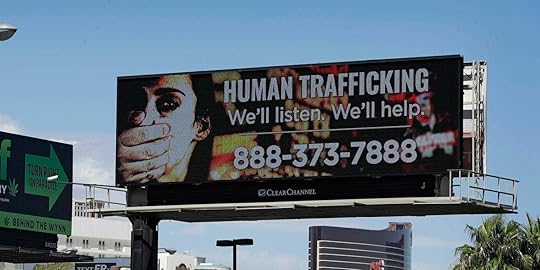 In the United States, Sex trafficking is most prolific in America’s multibillion-dollar illicit massage industry. The arrest of New England Patriots owner, Robert Kraft, and of hundreds of others who solicited sex in Florida spas brought the issue to the forefront. Raids on illicit spas are often well-publicized. What isn’t given the same attention is that in many cases, these sex spas return to normal business within months of the raid. Below is the front window of the Florida spa revealed in the Kraft case.
In the United States, Sex trafficking is most prolific in America’s multibillion-dollar illicit massage industry. The arrest of New England Patriots owner, Robert Kraft, and of hundreds of others who solicited sex in Florida spas brought the issue to the forefront. Raids on illicit spas are often well-publicized. What isn’t given the same attention is that in many cases, these sex spas return to normal business within months of the raid. Below is the front window of the Florida spa revealed in the Kraft case.  Our best evidence suggests that the lucrative illicit massage business is growing. (Modern day slavery in my opinion.) While prostitution has been illegal, the trafficking of sex workers wasn’t made illegal in the U.S. until George Bush Jr. signed it into law in 2000.
Our best evidence suggests that the lucrative illicit massage business is growing. (Modern day slavery in my opinion.) While prostitution has been illegal, the trafficking of sex workers wasn’t made illegal in the U.S. until George Bush Jr. signed it into law in 2000.  The United States, along with Mexico and the Philippines, was ranked one of the world's worst places for human trafficking in 2018. In the US, there is no official number of human trafficking victims. Estimates place it in the hundreds of thousands. About 150 calls come into the human trafficking hotline in the U.S. every day.
The United States, along with Mexico and the Philippines, was ranked one of the world's worst places for human trafficking in 2018. In the US, there is no official number of human trafficking victims. Estimates place it in the hundreds of thousands. About 150 calls come into the human trafficking hotline in the U.S. every day.  The red indicates where most of the calls are coming from. While most of the human trafficking cases have been reported in California, Texas, and Florida, Las Vegas is also a hot spot due to the city's culture and high rates of homelessness. Every state, including Minnesota, has reports of human trafficking. An organization called Telebinth Refuge in St. Cloud is currently helping about 50 women recover from trafficking.
The red indicates where most of the calls are coming from. While most of the human trafficking cases have been reported in California, Texas, and Florida, Las Vegas is also a hot spot due to the city's culture and high rates of homelessness. Every state, including Minnesota, has reports of human trafficking. An organization called Telebinth Refuge in St. Cloud is currently helping about 50 women recover from trafficking.  While all sexes can be victimized, 99% are women and girls. In Minnesota the majority are white, with Mexican immigrants and African American workers also existing in high numbers. (I’ll talk about the U.S. below.) Globally, about half of the females are Asian, with the greatest number coming from the Fujian province in Southeast China. The second highest percentage comes from South Korea. Of sex traffickers in the U.S., 71% entered legally. New York, and Queens in particular, is a documented destination for trafficking, because of its location on the eastern corridor. As Homeland Security assistant special agent Akil Baldwin stated, "New York is the epicenter of everything, legitimate and illegitimate." Approximately 20,000 individuals are sex trafficked every year in the U.S. This comes to 54 new people every day.
While all sexes can be victimized, 99% are women and girls. In Minnesota the majority are white, with Mexican immigrants and African American workers also existing in high numbers. (I’ll talk about the U.S. below.) Globally, about half of the females are Asian, with the greatest number coming from the Fujian province in Southeast China. The second highest percentage comes from South Korea. Of sex traffickers in the U.S., 71% entered legally. New York, and Queens in particular, is a documented destination for trafficking, because of its location on the eastern corridor. As Homeland Security assistant special agent Akil Baldwin stated, "New York is the epicenter of everything, legitimate and illegitimate." Approximately 20,000 individuals are sex trafficked every year in the U.S. This comes to 54 new people every day.
The potential victims are targeted by slimeball opportunists who look for kids coming out of problematic families. Children raised in foster care have a greater chance of becoming victims. In 2013, 60% of child victims recovered by the FBI were from foster care. It’s estimated that 1 in 7 runaways in the U.S. ends up in sex trafficking. Native American women are at particular risk, because of the high percentage living in poverty. In Phoenix, another of the top trafficking jurisdictions in the US, it was estimated that 40% of sex trafficking victims in 2015 were Native American.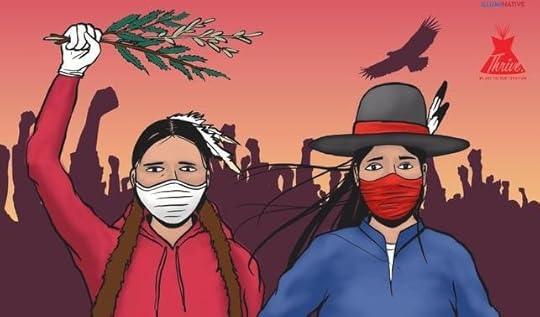 The smallest Mexican state, Tlaxcala, has been identified as the biggest source of sex slaves to the US. In 2015, 5 out of 10 of Homeland Security's "most wanted" sex traffickers were from Tenancingo, in Tlaxcala. There are estimates that 1 in 10 people from Tenancingo are involved in trafficking. I will share the story below, as this is the most typical scenario. You hear of girls being kidnapped for sex trafficking, but it isn’t the typical scenario. For example, that specific scenario happened once in Minnesota last year. Most often, poor desperate girls are talked into it, and then made to stay, out of fear the people they care about will be murdered if they don’t.
The smallest Mexican state, Tlaxcala, has been identified as the biggest source of sex slaves to the US. In 2015, 5 out of 10 of Homeland Security's "most wanted" sex traffickers were from Tenancingo, in Tlaxcala. There are estimates that 1 in 10 people from Tenancingo are involved in trafficking. I will share the story below, as this is the most typical scenario. You hear of girls being kidnapped for sex trafficking, but it isn’t the typical scenario. For example, that specific scenario happened once in Minnesota last year. Most often, poor desperate girls are talked into it, and then made to stay, out of fear the people they care about will be murdered if they don’t.
María Méndez shared her story. She was a live-in domestic worker when she met Ricardo López on her way to the supermarket. She was 15, from a poor family. She had had been cleaning houses since the age of 8. He was a cocky, charming 16-year-old from Tenancingo. He courted her, promising marriage and a home. She desperately wanted it to be true, and within a fortnight (2 weeks or “14 nights”) moved with him to Tenancingo.
At first López and his family treated her well, but it quickly turned violent. “He sent me to work as a prostitute– all over the country-- to make money selling my body. He said the money was to buy land so we could build a little house, but it was all false, even the name he’d given me was false. He made me live a very sad, ugly, desperate life. I was so ashamed.”
 Tenancingo only has a population of 11,000, but the presence of organized crime is breathtaking. Huge, tawdry houses are scattered among rows of modest homes. Everyone knows who owns the big houses, but there is no public land registry. This helps keep the proceeds from sex trafficking off paper. The mansions look like fancy multilayered wedding cakes adorned with sculptured eagles, lions and swans. The grandiosity continues into the cemetery, where tombs are ornate and extravagant, similar to those seen in the northern state of Sinaloa, from where many of the drug cartel leaders hail. Maria spoke of the pimps, “They go to other states looking for vulnerable girls to trick – that’s their role in the family business. Everyone knows who the padrotes are, it’s no secret, and it’s the same families who sponsor religious festivals. They operate with almost complete impunity. Trafficking has become so normalized and profitable that young people look up to them.”
Tenancingo only has a population of 11,000, but the presence of organized crime is breathtaking. Huge, tawdry houses are scattered among rows of modest homes. Everyone knows who owns the big houses, but there is no public land registry. This helps keep the proceeds from sex trafficking off paper. The mansions look like fancy multilayered wedding cakes adorned with sculptured eagles, lions and swans. The grandiosity continues into the cemetery, where tombs are ornate and extravagant, similar to those seen in the northern state of Sinaloa, from where many of the drug cartel leaders hail. Maria spoke of the pimps, “They go to other states looking for vulnerable girls to trick – that’s their role in the family business. Everyone knows who the padrotes are, it’s no secret, and it’s the same families who sponsor religious festivals. They operate with almost complete impunity. Trafficking has become so normalized and profitable that young people look up to them.”
Federal prosecution for the sex trafficking of children increased until 2016, and has decreased every year since. Some suggest the same incentives are no longer available to law enforcement, and others suggest the risk of deportation keeps sex trafficked females from coming forward.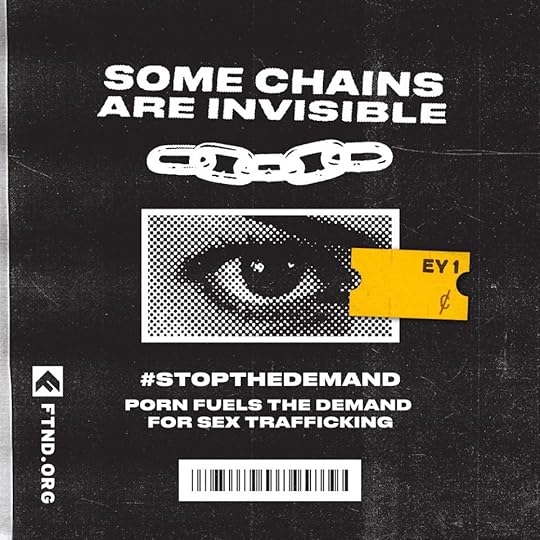 Is the porn industry related to sex trafficking?
Is the porn industry related to sex trafficking?
Not all porn is nonconsensual, and porn is alluring. There’s a reason billions of people access it. But what’s alluring isn’t always good for us. The porn industry fuels people being sexually exploited at the hands of people who should care for them, and at other times exploited by traffickers, and pimps who blatantly abuse them. Porn directly fuels the demand for sex traffickers to make money by selling videos of their sex slaves to porn sites. Major porn studios and porn sites are not immune from this. I’d encourage you to look at the site, Fight the New Drug, for more information.
What’s ironic about helping people out of prostitution, or sex trafficking, is that they are typically not welcoming the intervention with elation. Most often, help is presented when their “John” is being arrested. The workers fear for their lives and do everything they can to avoid being “rescued.” Very often, if not most of the time, the sex worker has developed a drug addiction and desires a reprieve from withdrawal more than help. As a therapist that helps people with sexual issues, I can tell you that prostitutes and strippers are some of the most mentally ill people I see. Think of the dissociation you need to create to let people you hate, violate your body, over and over again. In most cases, their problems started with being sexually abused as they were experiencing puberty and they have amplified the problems since. They’ve burned bridges with the few healthy relatives they’ve had, and lack resources. How is the girl brought here from Tencaningo going to get legal work? She has no papers. She sees her sexual availability as her only resource. Fortunately, there are places, like Terebinth in St. Cloud, that help. The task is on all of us to reduce the demand! CeCe Terlouw, Executive Director of Terebinth
CeCe Terlouw, Executive Director of Terebinth  The Terebinth (pistacia) tree is referenced in the Old Testament. The terebinth tree develops a very large deep and extensive root system and therefore remains green in years of drought. It often sprouts from the stump after being cut. Because of its large size and great age, terebinth trees were places of significance in the scripture. They were also seen as a resting place of shelter and shade. To me, a large tree is an example of resilience.
The Terebinth (pistacia) tree is referenced in the Old Testament. The terebinth tree develops a very large deep and extensive root system and therefore remains green in years of drought. It often sprouts from the stump after being cut. Because of its large size and great age, terebinth trees were places of significance in the scripture. They were also seen as a resting place of shelter and shade. To me, a large tree is an example of resilience.
Thanks for listening,
Frank

 April 21, from 7:00 to 7:30 p.m., Frank Weber discusses the development of Last Call on Facebook live.
www.facebook.com/frankweberauthor
April 21, from 7:00 to 7:30 p.m., Frank Weber discusses the development of Last Call on Facebook live.
www.facebook.com/frankweberauthor
*Win a chance to be a True Crime Star! During the 4 weeks of presentations, people who make comments during the presentation will have their name put into a drawing with the winner receiving 1 of 3 choices. I will either use your name as a character, have you make a brief appearance, or use your business name somewhere in the book. You can gift this award to a friend if you wish.
Sex Trafficking
 In the United States, Sex trafficking is most prolific in America’s multibillion-dollar illicit massage industry. The arrest of New England Patriots owner, Robert Kraft, and of hundreds of others who solicited sex in Florida spas brought the issue to the forefront. Raids on illicit spas are often well-publicized. What isn’t given the same attention is that in many cases, these sex spas return to normal business within months of the raid. Below is the front window of the Florida spa revealed in the Kraft case.
In the United States, Sex trafficking is most prolific in America’s multibillion-dollar illicit massage industry. The arrest of New England Patriots owner, Robert Kraft, and of hundreds of others who solicited sex in Florida spas brought the issue to the forefront. Raids on illicit spas are often well-publicized. What isn’t given the same attention is that in many cases, these sex spas return to normal business within months of the raid. Below is the front window of the Florida spa revealed in the Kraft case.  Our best evidence suggests that the lucrative illicit massage business is growing. (Modern day slavery in my opinion.) While prostitution has been illegal, the trafficking of sex workers wasn’t made illegal in the U.S. until George Bush Jr. signed it into law in 2000.
Our best evidence suggests that the lucrative illicit massage business is growing. (Modern day slavery in my opinion.) While prostitution has been illegal, the trafficking of sex workers wasn’t made illegal in the U.S. until George Bush Jr. signed it into law in 2000.  The United States, along with Mexico and the Philippines, was ranked one of the world's worst places for human trafficking in 2018. In the US, there is no official number of human trafficking victims. Estimates place it in the hundreds of thousands. About 150 calls come into the human trafficking hotline in the U.S. every day.
The United States, along with Mexico and the Philippines, was ranked one of the world's worst places for human trafficking in 2018. In the US, there is no official number of human trafficking victims. Estimates place it in the hundreds of thousands. About 150 calls come into the human trafficking hotline in the U.S. every day.  The red indicates where most of the calls are coming from. While most of the human trafficking cases have been reported in California, Texas, and Florida, Las Vegas is also a hot spot due to the city's culture and high rates of homelessness. Every state, including Minnesota, has reports of human trafficking. An organization called Telebinth Refuge in St. Cloud is currently helping about 50 women recover from trafficking.
The red indicates where most of the calls are coming from. While most of the human trafficking cases have been reported in California, Texas, and Florida, Las Vegas is also a hot spot due to the city's culture and high rates of homelessness. Every state, including Minnesota, has reports of human trafficking. An organization called Telebinth Refuge in St. Cloud is currently helping about 50 women recover from trafficking.  While all sexes can be victimized, 99% are women and girls. In Minnesota the majority are white, with Mexican immigrants and African American workers also existing in high numbers. (I’ll talk about the U.S. below.) Globally, about half of the females are Asian, with the greatest number coming from the Fujian province in Southeast China. The second highest percentage comes from South Korea. Of sex traffickers in the U.S., 71% entered legally. New York, and Queens in particular, is a documented destination for trafficking, because of its location on the eastern corridor. As Homeland Security assistant special agent Akil Baldwin stated, "New York is the epicenter of everything, legitimate and illegitimate." Approximately 20,000 individuals are sex trafficked every year in the U.S. This comes to 54 new people every day.
While all sexes can be victimized, 99% are women and girls. In Minnesota the majority are white, with Mexican immigrants and African American workers also existing in high numbers. (I’ll talk about the U.S. below.) Globally, about half of the females are Asian, with the greatest number coming from the Fujian province in Southeast China. The second highest percentage comes from South Korea. Of sex traffickers in the U.S., 71% entered legally. New York, and Queens in particular, is a documented destination for trafficking, because of its location on the eastern corridor. As Homeland Security assistant special agent Akil Baldwin stated, "New York is the epicenter of everything, legitimate and illegitimate." Approximately 20,000 individuals are sex trafficked every year in the U.S. This comes to 54 new people every day. The potential victims are targeted by slimeball opportunists who look for kids coming out of problematic families. Children raised in foster care have a greater chance of becoming victims. In 2013, 60% of child victims recovered by the FBI were from foster care. It’s estimated that 1 in 7 runaways in the U.S. ends up in sex trafficking. Native American women are at particular risk, because of the high percentage living in poverty. In Phoenix, another of the top trafficking jurisdictions in the US, it was estimated that 40% of sex trafficking victims in 2015 were Native American.
 The smallest Mexican state, Tlaxcala, has been identified as the biggest source of sex slaves to the US. In 2015, 5 out of 10 of Homeland Security's "most wanted" sex traffickers were from Tenancingo, in Tlaxcala. There are estimates that 1 in 10 people from Tenancingo are involved in trafficking. I will share the story below, as this is the most typical scenario. You hear of girls being kidnapped for sex trafficking, but it isn’t the typical scenario. For example, that specific scenario happened once in Minnesota last year. Most often, poor desperate girls are talked into it, and then made to stay, out of fear the people they care about will be murdered if they don’t.
The smallest Mexican state, Tlaxcala, has been identified as the biggest source of sex slaves to the US. In 2015, 5 out of 10 of Homeland Security's "most wanted" sex traffickers were from Tenancingo, in Tlaxcala. There are estimates that 1 in 10 people from Tenancingo are involved in trafficking. I will share the story below, as this is the most typical scenario. You hear of girls being kidnapped for sex trafficking, but it isn’t the typical scenario. For example, that specific scenario happened once in Minnesota last year. Most often, poor desperate girls are talked into it, and then made to stay, out of fear the people they care about will be murdered if they don’t.María Méndez shared her story. She was a live-in domestic worker when she met Ricardo López on her way to the supermarket. She was 15, from a poor family. She had had been cleaning houses since the age of 8. He was a cocky, charming 16-year-old from Tenancingo. He courted her, promising marriage and a home. She desperately wanted it to be true, and within a fortnight (2 weeks or “14 nights”) moved with him to Tenancingo.
At first López and his family treated her well, but it quickly turned violent. “He sent me to work as a prostitute– all over the country-- to make money selling my body. He said the money was to buy land so we could build a little house, but it was all false, even the name he’d given me was false. He made me live a very sad, ugly, desperate life. I was so ashamed.”

 Tenancingo only has a population of 11,000, but the presence of organized crime is breathtaking. Huge, tawdry houses are scattered among rows of modest homes. Everyone knows who owns the big houses, but there is no public land registry. This helps keep the proceeds from sex trafficking off paper. The mansions look like fancy multilayered wedding cakes adorned with sculptured eagles, lions and swans. The grandiosity continues into the cemetery, where tombs are ornate and extravagant, similar to those seen in the northern state of Sinaloa, from where many of the drug cartel leaders hail. Maria spoke of the pimps, “They go to other states looking for vulnerable girls to trick – that’s their role in the family business. Everyone knows who the padrotes are, it’s no secret, and it’s the same families who sponsor religious festivals. They operate with almost complete impunity. Trafficking has become so normalized and profitable that young people look up to them.”
Tenancingo only has a population of 11,000, but the presence of organized crime is breathtaking. Huge, tawdry houses are scattered among rows of modest homes. Everyone knows who owns the big houses, but there is no public land registry. This helps keep the proceeds from sex trafficking off paper. The mansions look like fancy multilayered wedding cakes adorned with sculptured eagles, lions and swans. The grandiosity continues into the cemetery, where tombs are ornate and extravagant, similar to those seen in the northern state of Sinaloa, from where many of the drug cartel leaders hail. Maria spoke of the pimps, “They go to other states looking for vulnerable girls to trick – that’s their role in the family business. Everyone knows who the padrotes are, it’s no secret, and it’s the same families who sponsor religious festivals. They operate with almost complete impunity. Trafficking has become so normalized and profitable that young people look up to them.”Federal prosecution for the sex trafficking of children increased until 2016, and has decreased every year since. Some suggest the same incentives are no longer available to law enforcement, and others suggest the risk of deportation keeps sex trafficked females from coming forward.
 Is the porn industry related to sex trafficking?
Is the porn industry related to sex trafficking?Not all porn is nonconsensual, and porn is alluring. There’s a reason billions of people access it. But what’s alluring isn’t always good for us. The porn industry fuels people being sexually exploited at the hands of people who should care for them, and at other times exploited by traffickers, and pimps who blatantly abuse them. Porn directly fuels the demand for sex traffickers to make money by selling videos of their sex slaves to porn sites. Major porn studios and porn sites are not immune from this. I’d encourage you to look at the site, Fight the New Drug, for more information.
What’s ironic about helping people out of prostitution, or sex trafficking, is that they are typically not welcoming the intervention with elation. Most often, help is presented when their “John” is being arrested. The workers fear for their lives and do everything they can to avoid being “rescued.” Very often, if not most of the time, the sex worker has developed a drug addiction and desires a reprieve from withdrawal more than help. As a therapist that helps people with sexual issues, I can tell you that prostitutes and strippers are some of the most mentally ill people I see. Think of the dissociation you need to create to let people you hate, violate your body, over and over again. In most cases, their problems started with being sexually abused as they were experiencing puberty and they have amplified the problems since. They’ve burned bridges with the few healthy relatives they’ve had, and lack resources. How is the girl brought here from Tencaningo going to get legal work? She has no papers. She sees her sexual availability as her only resource. Fortunately, there are places, like Terebinth in St. Cloud, that help. The task is on all of us to reduce the demand!
 CeCe Terlouw, Executive Director of Terebinth
CeCe Terlouw, Executive Director of Terebinth  The Terebinth (pistacia) tree is referenced in the Old Testament. The terebinth tree develops a very large deep and extensive root system and therefore remains green in years of drought. It often sprouts from the stump after being cut. Because of its large size and great age, terebinth trees were places of significance in the scripture. They were also seen as a resting place of shelter and shade. To me, a large tree is an example of resilience.
The Terebinth (pistacia) tree is referenced in the Old Testament. The terebinth tree develops a very large deep and extensive root system and therefore remains green in years of drought. It often sprouts from the stump after being cut. Because of its large size and great age, terebinth trees were places of significance in the scripture. They were also seen as a resting place of shelter and shade. To me, a large tree is an example of resilience.Thanks for listening,
Frank
Published on April 20, 2020 16:44



